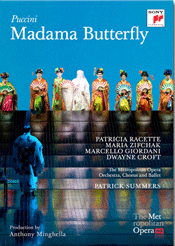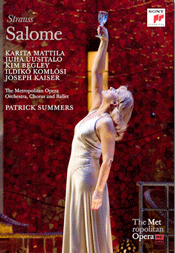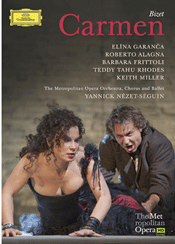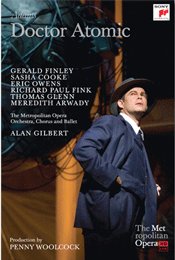June 30, 2011
Summer Treats in Saint Louis
Never a company to shy away from challenges, this summer’s risk-taking resulted in a stunning new production of John Adams’ The Death of Klinghoffer. Since its 1991 debut, Mr. Adams’ opus has had a somewhat rocky, even notorious history. Never has it seemed more topical, all the while it remains highly controversial. Consider the premise: using the actual historical event of a Muslim terrorist group’s heinous murder of a wheelchair-bound elderly Jewish cruise ship passenger as a dramatic springboard, the piece distills that cowardly, vengeful action into a forum for both political sides to lament and document the personal losses resultant from past and present conflict in the Middle East.
That this is a contentious basis for an opera, there is no doubt. But the creators have responded with a gut-wrenching, transformative work of art that promotes dialogue as much as it abhors terrorism. The composer and librettist Alice Goodman successfully walk a fine line by balancing the angry group dynamics motivating socio-political (mis-)deeds, with the real, personal, human cost reaped by those swept up in an unending, violent response to historical forces. Without respect to the Unities, the creators alternate solo scenes (largely monologues) and impressions of the passengers, crew, and attackers on the ship Achille Lauro with haunting choral pieces of aching, sinewy pain and beauty. Indeed, these powerful ensembles are among the very finest moments John Adams has composed to date and here they were performed with ravishing musicality and laser-beam dramatic intensity.
Every Festival has one standout star performance and this year that distinction belonged to the Gerdine Young Artists ensemble for their impeccable work here. This exceptional training program is not only the heart and soul of OTSL, it is its raison d’etre. Season after season young singers are developed in a nurturing yet intensive program that not only enhances the work at hand but invests in the future. Just check out the program and see how many 2011 principals began their association with OTSL as apprentices. A remarkable success story. The solid work was matched by an exciting roster of soloists.
Nancy Maultsby as Marilyn Klinghoffer wins our hearts, as she must. She has been given a marvelously varied scena to close the show, its vocal demands as wide-ranging as its emotions which span anguished loss, unbridled anger, and hopeless resolution — a potent distillation of Middle East truth and consequences in one, unbearably intense Geschrei. Ms. Maultsby is possessed of an uncommonly rich mezzo, unwavering at full dramatic force, and meltingly responsive in the role’s legato passages. (Coincidentally, Nancy is a former Gerdine Young Artist.)
Christopher Magiera displayed a suave lyric baritone which he put to fine use as the insightful, tormented Captain. In he title role, Brian Mulligan excelled in his dynamic solo moment. Adams makes us wait a long time for Klinghoffer to have his say, and when he did, Mr. Mulligan made it well worth the wait, as he determinedly took the stage with his intense, commanding baritone. Paul La Rosa effectively doubled as a tremulous First Officer, then an unrelentingly determined Rambo, pinging his powerful baritone off the back wall. And, strapping in his wife beater tee shirt, Mr. La Rosa also managed to out-Gunn Nathan in the Muscles Parade. Tenor Matthew DiBattista’s effective Moigi pinned our ears back with ringing, secure high notes. Laura Wilde’s clear, throbbing mezzo made a fine case for Omar’s stirring monologue.
First among equals was arguably Aubrey Allicock, whose distinctive bass-baritone rolled forth with chilling effect and complete assurance. Mr. A is singer with a great gift and great potential. Without reverting to stereotypes Lucy Schaufer created three diverse characters as the Swiss Grandmother, Austrian Woman, and British Dancer. Her polished mezzo and confident acting made each turn highly individual.
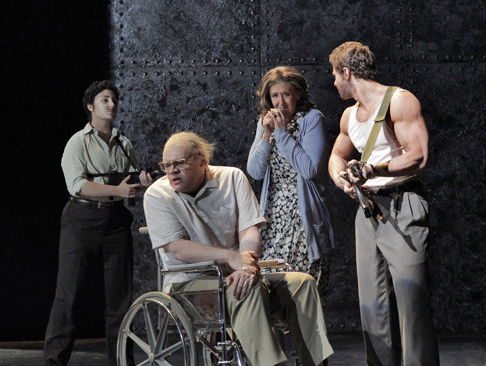 (L to R) Laura Wilde as Omar, Brian Mulligan as Leon Klinghoffer, Nancy Maultsby as Marilyn Klinghoffer, and Paul LaRosa as Rambo
(L to R) Laura Wilde as Omar, Brian Mulligan as Leon Klinghoffer, Nancy Maultsby as Marilyn Klinghoffer, and Paul LaRosa as Rambo
Michael Christie led a tightly controlled and stylistically diverse reading of this unfamiliar piece, managing at once to make it both challenging and accessible. Adams’ usual throbbing rhythms and melodic angularity are tempered with long stretches of undulating, rippling aural effects that suggest the sea. And there are moments of great repose, reflection, and resolution that are unique (in my experience) in the Adams canon. The first rate instrumentalists responded in turn with force, incisiveness, delicacy, and spontaneity.
The design team provided a performing environment well nigh unto perfect, stylized and simple. The varied, ever shifting projections (fine work by Greg Emataz) evoked the sea and eternity all at once. The show began in silence with a bone-chilling image of an empty wheelchair, down lit with a harsh white-hot spot. After a sudden, sharp retort of rifle fire, a torrent of water gushed down from above, brutally pummeling the chair.
The movable wall panels suggested the hull of a ship with expert texturing and a trim of rivets. Carefully selected set pieces and exquisite lighting from Christopher Akerlind were all that was needed to work theatrical magic and create diverse locations. James Schuette’s detailed and evocative period costumes were highly effective.
James Robinson’s direction of the chorus was superb to say the least. His masterful use of the simplest of props, suitcases in this case, first establishes that they are Palestinian refugees. By turning the cases and setting them on end as headstones, we are effortlessly transported to a Jewish cemetery. And in a brilliant stroke, they were piled up to create a wall/settlement that spoke volumes about the physical and social barrier that exists to this day.
Mr. Robinson also blocked his soloists exceedingly well, more often than not trusting them to be physically still as they delivered monologues rife with sub-text and inner life. Having the invalid Klinghoffer stand and deliver his final solo while his wheelchair, hooked to a fly line, ascends to the loft was yet another indelible moment.
The Death of Klinghoffer was of a quality and significance that it would be at home on any world stage. One minor quibble: I dearly wish that cast and conductor had continued the mood through to a sober curtain call. Audience approval prompted big, happy smiles from a few and I wasn’t ready to smile just yet.
The Adams was decidedly not the only treat to be savored. The Festival’s lone comedy proved to be a delectably frothy The Daughter of the Regiment. Director/choreographer Sean Curran skillfully served up a lavish dessert buffet of a show without over-dosing on sweetness. Mr. Curran managed this by mixing in a hint of starch and a dash of cynicism, and by staging the whole with musical comedy precision and savvy. The spot-on ballet goofs that he created for Marie and a corps of (real) dancers to open act two, was a refreshing addition. If the leading characters spoke their lines with just a twinge of Dudley DoRight, operatic-singerly declamation, well, they landed the jokes without fail so it didn’t seem to matter.
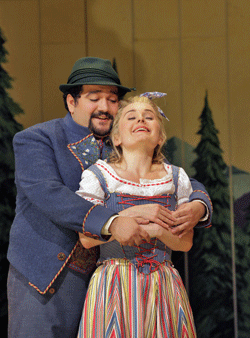 (L to R) René Barbera as Tonio and Ashley Emerson as Marie
(L to R) René Barbera as Tonio and Ashley Emerson as Marie
James Schuette came up with a jewel box of a set design, and vibrant costumes, the whole shebang being persuasively “old-fashioned” down to having a circle of footlights created from halved military snare drums. Rarely do you get to experience such a loving recreation of a bygone production style, utterly free of irony or condescension. Christopher Akerlind devised yet another clean lighting design.
Daughter is one of those operas that can make an impression whether as a showcase for leading world stars (Sills, Sutherland, Dessay, Pavarotti, Florez) or up-and-coming talent such as St. Louis fielded with the wonderfully paired Ashley Emerson (Marie) and René Barbera (Tony).
Ms. Emerson has a crystal clear, pliable coloratura instrument which she skillfully negotiates with assurance and panache. Her forays “in alt” were reliably steady, and her silvery soprano carries well. Ashley is also possessed of a winning presence and she gamely pulls off every comedic turn that is asked of her. If she does not yet have the final measure of poignancy in her Act One farewell to the troops, I have no doubt that time and experience will lead her to that skill. And…she is cute cute cute. Blond, lovely, and petite as a Kristen Chenoweth Action figure, Ashley Emerson delivers a star turn.
René Barbera complemented her perfectly, and his warm, sturdy tenor was a perfect fit not only for the technical demands of the role but also for its temperament. There is more to the part than the high C’s after all (which he nailed), and Mr. Barbera’s slightly bearish physique and sweetly expressive face stood him in good stead in winning audience sympathy.
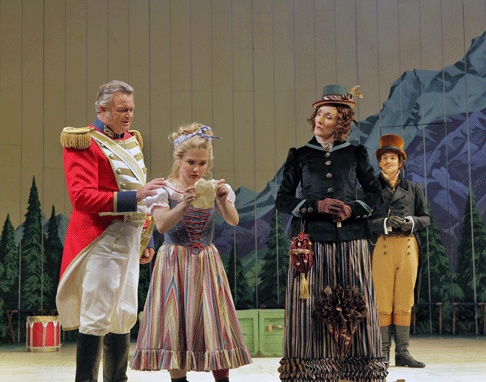 (L to R) Dale Travis as Sulpice, Ashley Emerson as Marie, Dorothy Byrne as the Marquise of Berkenfeld, and Jason Eck as Hortensius
(L to R) Dale Travis as Sulpice, Ashley Emerson as Marie, Dorothy Byrne as the Marquise of Berkenfeld, and Jason Eck as Hortensius
Dorothy Byrne was a glamorous Marquise of Berkenfeld with a more aristocratic mezzo and demeanor than is usual for a role usually essayed by ‘character’ performers. Dale Travis brought years of experience and a sturdy baritone to his broad take on Sergeant Sulpice. Operatic-soprano-turned-cabaret-artist Sylvia McNair gifted us with a well-received Duchess of Crackenthorp, dropping topical punchlines with precision and tickling us with an inserted novelty number about a diva who has a bad sense of pitch.
John McDaniel kept everything bubbling along merrily in the pit. The maestro proved to be a capable collaborator who, with his excellent cast, treated us to an effervescent afternoon. Only the Act Two trio for Marie-Tonio-Sulpice failed to fully ignite, coming off as cautious rather than breathless. Nonetheless, what a succulent confection.
Masterpiece though it may be, Pelléas and Mélisande is never going to be on the Opera Hit Parade. Dark, diffuse, elusive, the Debussy opus resists accessibility. It reminds me of a film of recent years In the Bedroom, in which, save one cathartic event, all of the emotional ‘action’ is under the surface. If you are willing to immerse yourself in Debussy’s musical pallette there is much to be mined. If not, there is always intermission, in which about one quarter of the unmoved patrons chose instead to ‘move’ to the exit.
To their credit, the production team made an earnest effort to make Maeterlinck’s ambiguous tale resonate. Paul Steinberg (Set Design) Constance Hoffman (Costumes) and especially Adam Silverman (Lighting) devised a suitably vague abstract world, a universal playing space peopled by recognizable archetypes. Mr. Silverman’s well-considered area specials and quicksilver lighting changes were models of invention, and Mr. Stenberg’s Marimekko-like green and white leaf pattern on the walls and floor were particularly apt as a constant reference point amid fluid shifts of well-chosen set pieces.
David Alden’s direction proposed that the story veils a hushed-up history of sexual threats and physical/emotional abuse. This jives well with the heroine’s protestations of “Don’t touch me.” It wears less well as the evening progresses, with Golaud becoming more and more relentlessly brutish, and the nerdily dweebish title hero becoming more emotionally paralyzed than Hamlet on downers. Stuck in the middle of these widening poles, poor Mélisande appeared more tediously catatonic by the minute. In the end, by trying to infuse the piece with a specificity out of today’s headlines, Mr. Alden actually made the piece lose its special character which allows each of us to devise our own scenario as to what has happened, and what will happen to the characters in this realm of imagination and speculation.
Stephen Lord elicited well-judged, idiomatic playing from his band. The whole reading had a wonderful, evocative arc that was ethereal, yes, but also explosive on those several occasions that demand dramatic fire. For me, this opera’s language is so specific to the musical texture that it just does not soar in English. Diction was fine, translation was all right, but the vernacular robbed the soloists of those slightly covered vowel sounds that help inform the vocal line.
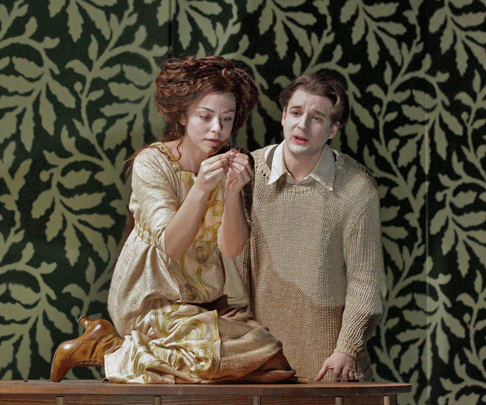 (L to R) Corinne Winters as Mélisande and Liam Bonner as Pelléas
(L to R) Corinne Winters as Mélisande and Liam Bonner as Pelléas
Of the cast, only veteran John Cheek embodied the right “sound” with his orotund, slightly grainy bass in wonderfully plangent form as Arkel. Gregory Dahl’s blustery Golaud found his baritone a bit short of oomph on the bottom which caused him to slightly distort vowels in an effort to inject some heft in the lower reaches. Mr. Dahl’s middle and upper registers rang out convincingly, and his acting as a menacing, tortured soul was wholly persuasive. Maria Zifchak’s stirring tones and commendable control in the brief role of Genevieve left us wanting more from this fine artist. Michael Kepler Meo arguably stole the show as Yniold with his responsive boy soprano and his focused, purposeful acting.
In the title parts, Liam Bonner and Corinne Winters were ‘almost’ all one could wish. Mr. Bonner has at his disposal a smooth lyric baritone which he uses with great musicality. He essays the sustained forays around the top of the staff with considerable skill, although the handful of the very highest forte notes in his final confrontation were just at (though not beyond) the limit of his resources. Ms. Winters for her part showed off a medium bodied lyric with well-honed technique, capable of considerable nuance, and comfortable throughout the wide-ranging part. What both singers lack at this point, alas, is either a unique timbre, and/or the ability to sustain a plaintive vocal appeal that the greatest interpreters brought to the piece (think von Stade and Stilwell).
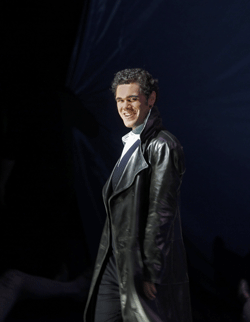 Elliot Madore as Don Giovanni
Elliot Madore as Don Giovanni
Still, what a pleasure to see such a polished mounting of this challenging work, marked by the highest professional standards and characterized by a dramatic interpretation worthy of continued consideration and discussion.
OTSL was slightly less well-served by the roster’s bread-and-butter title Don Giovanni. Not that there weren’t many enjoyable components in it — there surely were. But they stubbornly refused to gel.
Bruno Schwengl’s sets and costumes were all over the place from period fantasy looks to rather bland modern dress. His sets were generally flat-looking, and somewhat confusing. What those two blue boxy sit-’n’-spin playpens were in the scene when the Don first encounters Zerlina is anyone’s guess. The cartoonish plinth for the Commendatore’s statue didn’t partner well with the prone, naked, painted-gray-like-stone dancer who first posed as an inert sculpture then later came to life came to life.
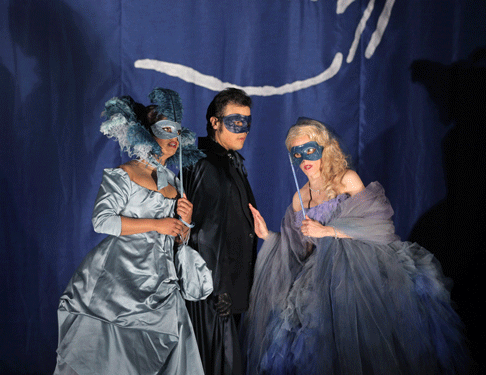 (L to R) Kishani Jayasinghe as Donna Elvira, David Portillo as Don Ottavio, and Maria Kanyova as Donna Anna
(L to R) Kishani Jayasinghe as Donna Elvira, David Portillo as Don Ottavio, and Maria Kanyova as Donna Anna
Nor were the proceedings really helped by James Robinson’s and Michael Shell’s fitful direction, although there were some intriguing ideas put forth that then sadly died on the vine. After visually suggesting at the end of the first scene that Donna Anna and Ottavio are having an aggressively active sex life, the concept is never developed. After Leporello starts the show by turning upstage and taking a leak on the wall at overture’s end, that irreverence never takes hold, and rather descends into a tiresome series of frat boy jokes and boorish behavior which endears us to neither of our two Bad Boyz. A rather promising device of having spectral supers haunt Giovanni’s misdeeds is sporadically potent, although when they strip him of his earthly trappings before throwing him into hell, they demurely stop after the shirt. If you’re going to set up the expectation of that imagery, then take it all off, baby!
The staging tripped over its own good intentions, leaving a cast of fine singers to interact with each other without really bonding. The relationship between Leporello and his master was particularly un-engaging, all rough and tumble surface macho posturing. Levi Hernandez has all the goods for a fine Leporello, mind you, showing us good buffo sensibilities and a solid bass. And boy-band-handsome Elliot Madore has a warm, virile baritone that indeed falls very pleasantly on the ear. But there is more to the Don than a shirt open to the navel, restless swaggering, making ‘sexy’ faces, and arching the eyebrows. Elliott, don’t just do something, stand there! And let it emanate from within.
Maria Kanyova was wholly successful as Donna Anna, her reliable, gleaming soprano giving much pleasure. But her acting seemed to be more about technique than inner fire on this occasion. Maybe I was just distanced by her puzzling blond wig (although Ashley Ryan contributed otherwise outstanding hair and make-up design for all four pieces). David Portillo was a marvelous Ottavio, with good starch in his character and a honeyed lilt in his tenor. Although deprived of “Dalla sua pace” he scored a bullseye with “Il mio Tesoro” (or whatever they were in English). While Kishani Jayasinghe has not just yet solved every challenge of Donna Elvira (the opera’s most complex role), she treated us to many exciting moments with a golden, even soprano that had hints of Freni. Andrew Gangestad was an imposing Commendatore with a penetrating bass.
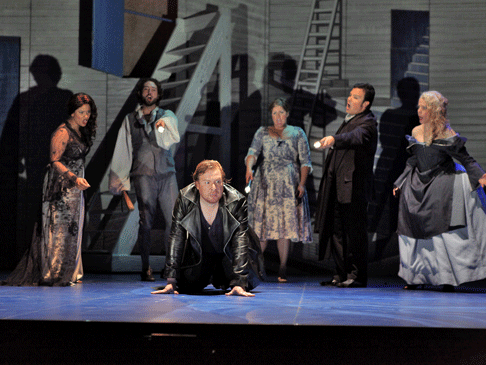 (L to R) Kishani Jayasinghe as Donna Elvira, Bradley Smoak as Masetto, Levi Hernandez as Leporello, Kathryn Leemhuis as Zerlina, David Portillo as Don Ottavio, and Maria Kanyova as Donna Anna
(L to R) Kishani Jayasinghe as Donna Elvira, Bradley Smoak as Masetto, Levi Hernandez as Leporello, Kathryn Leemhuis as Zerlina, David Portillo as Don Ottavio, and Maria Kanyova as Donna Anna
The two Mozart stand-outs for me were the fresh-voiced Zerlina from animated mezzo Kathryn Leemhuis, and the robust Masetto from Bradley Smoak. Ms. Leemhuis was a breath of fresh air: spontaneous, honest, and vocally assured; and Mr. Smoak’s attractive, manly baritone had rich presence and power. Indeed, I believe young Bradley might make a dynamic Don someday, sooner rather than later.
Since I so greatly admire Maestra Jane Glover, I wish I could say that the musical reading was at her usual high standard. But I found the orchestra while playing cleanly, sounded dry; and while the whole was well paced and musically sound, it lacked the inner drive that is so evident in Glover’s finest work.
James Sohre
The Death of Klinghoffer
The Captain: Christopher Magiera; First Officer/Rambo: Paul La Rosa; Swiss Grandmother/Austrian/British Dancer: Lucy Schaufer; Molgi: Matthew DiBattista; Mamoud: Aubrey Allicock; Leon Klinghoffer: Brian Mulligan; Omar: Laura Wilde; Marilyn Klinghoffer: Nancy Maultsby. Conductor: Michael Christie. Director: James Robinson. Set Designer: Allen Moyer. Costume Designer: James Schuette. Video Projection Designer: Greg Emetaz. Lighting Designer: Christopher Akerlind. Sound Designer: Mark Grey. Wig and Make-up Design: Ashley Ryan. Choreographer: Sean Curran. Chorus Master: R. Robert Ainsley.
The Daughter of the Regiment
Hortensius: Jason Eck; Marquise of Berkenfeld: Dorothy Byrne; Peasant: Clay Hilley; Sergeant Sulpice: Dale Travis; Marie: Ashley Emerson; Tonio: René Barbera; Corporal: Matthew Hanscom; Duchess of Crackenthorp: Sylvia McNair; Notary: Kyle Erdos Knapp. Conductor: John McDaniel. Director and Choreographer: Sean Curran. Set and Costume Designer: James Schuette. Lighting Designer: Christopher Akerlind.
Pelléas and Mélisande
Golaud: Gregory Dahl; Mélisande: Corinne Winters; Genevieve: Maria Zifchak; Arkel: John Cheek; Pelléas: Liam Bonner; Yniold: Michale Kepler Meo; Shepherd Voice: Sidney Outlaw; Physician: Allen Boxer. Conductor: Stephen Lord. Director: David Alden. Set Designer: Paul Steinberg. Costume Designer: Constance Hoffman. Lighting Designer: Adam Silverman.
Don Giovanni
Leporello: Levi Hernandez; Donna Anna: Maria Kanyova; Don Giovanni: Elliot Madore; Commendatore: Andrew Gangestad; Don Ottavio: David Portillo; Donna Elvira: Kishani Jayasinghe; Zerlina: Kathryn Leemhuis; Masetto: Bradley Smoak. Conductor/Fortepiano: Jane Glover; Stage Directors: James Robinson and Michael Shell. Set and Costume Designer: Bruno Schwengl. Lighting Designer: Christopher Akerlind.
image=http://www.operatoday.com/Klinghoffer01.gif image_description=(L to R) Brian Mulligan as Leon Klinghoffer and Nancy Maultsby as Marilyn Klinghoffer [Photo by Ken Howard courtesy of Opera Theatre Saint. Louis] product=yes product_title=Opera Theatre Saint Louis 2011 product_by=By James Sohre product_id=Above: (L to R) Brian Mulligan as Leon Klinghoffer and Nancy Maultsby as Marilyn KlinghofferAll photos by Ken Howard courtesy of Opera Theatre Saint. Louis
Luca Pisaroni sings Handel at Glyndebourne
“I really look forward to embodying Argante at Glyndebourne”, he says, “because the music that Handel wrote for Argante is incredibly challenging.” His first aria “Sibillar gl’angui d’Aletto” is not only one of the best-known arias for bass-baritone but also one of the most difficult arias in the entire baroque repertoire.
Argante is a powerful but complex character. Why is Pisaroni drawn to such dark personalities? “When I first performed Tiridate in Handel’s Radamisto at Santa Fe Opera I discovered how exciting it is to portray a ‘bad guy’ on stage. Tiridate is an abusive and violent person and in order to follow David Alden’s vision I really had to push myself. It was really rewarding to explore such a dark personality and to get a great response from the audience. In life you never get away with being the bad guy! On an opera stage you do and everyone loves it.”
After Glyndebourne, Pisaroni will be singing Argante again at the Chicago Lyric Opera. He’s singing Caliban in The Enchanted Island ,a baroque pastiche specially created by William Christie and Jeremy Sams. “I have five great arias in it”, says Pisaroni, “It will be fun to be the monster in this fantasy”. In 2012 in Santa Fe, he’s singing Maometto in Rossini’s Maometto Secondo. “It’ll be the world premiere of the new critical edition by Philip Gossett. There aren’t many operas where the bass is the title role, so I can’t wait to sing it”.
Mozart is one of the cornerstones of Pisaroni’s career. In 2010, he sang Leporello in the acclaimed new production at Glyndebourne of Don Giovanni. “ Portraying Leporello there was incredibly rewarding for me. I love to play Don Giovanni’s servant and I believe the audience can identify with him because he is an ordinary guy who witnesses something truly extraordinary”. He’s also created Leporello at Teatro Real Madrid, Opéra Bastille, and Tanglewood. He’s singing it at Baden-Baden under Yannick Nézet-Séguin. That performance will be recorded by Deutsche Grammophon.
“I adore Mozart”, says Pisaroni. “From a musical and dramatic point of view, he is simply fantastic. For a singer Mozart’s music is the best way to grow as a musician and as an actor without damaging your instrument. I especially love the three Mozart/Da Ponte operas. I love the characters they created and the different emotions they explore. The real challenge in these pieces is to sing them as naturally as possible. I believe Da Ponte and Mozart operas are all about humanity and truth”. Figaro is one of Pisaroni’s signature roles, which performed at the Metropolitan Opera, Opéra National de Paris, in San Francisco, with Franz Welser-Möst at the Wiener Staatsoper, and memorably at the Salzburg Festival.
“My ‘real’ initiation in Mozart was when I sang Masetto at the Salzburg Festival in 2002. I thought I knew the role well and, being Italian, I felt pretty confident about the way I sang the recitatives. And then, I worked with Nikolaus Harnoncourt who made me realize very quickly how little I knew about this composer and making music in general. His incredible sense of drama and his musical choices stunned me. What he did was beyond anything I had heard before or could even imagine. I vividly remember my surprise and excitement when we worked on the finale of Act I. I had never heard anything like it. Harnoncourt definitely changed my perception of the opera forever”.
Pisaroni was born in Ciudad Bolivar (Venezuela) on June 8th 1975. “I am Italian. My parents are both Italian. I was born in Venezuela because my parents lived there for almost 10 years. We moved back to Italy when I was 4 years old and I spent my childhood and adolescence in Busseto (Parma), Giuseppe Verdi’s hometown”.
“The first experiences with opera I can recall are tied to memories I have of my grandfather. He always listened to opera and the earliest musical memory I have is listening to Boris Christoff singing ‘Ella giammai m’amò’ from Verdi’s Don Carlo. It was love at first sight. I started listening to a collection of tapes of Verdi arias that my grandfather owned. I played them so many times that I ultimately wore them out. Later on my father bought me my first Luciano Pavarotti record and took me to a live performance (Aida at the Arena di Verona), which ignited my passion for opera”.
“Two tenors influenced my path, but in very different ways: Luciano Pavarotti and Carlo Bergonzi. It is because of Pavarotti that I decided to become an opera singer. When I was 11, I watched a commercial of the 1986 World Soccer Championship featuring Luciano Pavarotti singing ‘Nessun Dorma’. I recall watching the commercial in complete ecstasy and telling my mother that I could only imagine myself doing exactly the same thing. At the beginning my mother was unsure whether I referred to a career as a football player or a singer. Later on it was evident to everybody that I had decided to become an opera singer since I was not very good at football”.
“When I was 13 or 14 years old I preferred spending my afternoons listening to master classes given by Carlo Bergonzi for the ‘Accademia Verdiana’ in my hometown Busseto. Even though I wasn’t singing but only listening to other singers I learned a lot about phrasing, clear diction and how to use words to convey musical ideas. Watching other singers work with him made me realize that the only thing I wanted to do in my life was to be a singer”.
Living in Busseto, with so much Verdi around him, Pisaroni could easily have slipped into a niche. “I love Verdi!, he says. “I could probably sing most of his tenor roles by heart. I love his music and the dramatic journey of the characters he created. I just believe you should sing his operas only when you feel ready — especially for my voice type. Verdi bass-baritone roles like Attila, Filippo II, Procida and Fiesco require, in my opinion, not only a technical maturity but also a ‘personal’ maturity that only age can give you”. Since Pisaroni is still well under 40, there’s much to look forward to.
Pisaroni’s range is wide, nonetheless, ranging from Bach to Handel and Haydn, Mozart and Rossini and includes Schumann and Stravinsky. He’s also a good recitalist, singing at the Wigmore Hall, London and in Amsterdam earlier this year. “I love all classical music - opera, baroque, symphonic, sacred or Lieder. I believe that knowing the tradition and past interpretations helps you to go forward and to push yourself to the limit. It’s not about copying or stealing someone else’s ideas: for me it’s about ultimately finding your inner voice”. He adds “I think every song is like a painting that you need to bring to life through your voice — like Mussorgsky’s ‘Pictures at an exhibition’. Hence the care with which he assembles programmes, “to create a wide spectrum of emotions”.
Perhaps it is Pisaroni’s very genuine enthusiasm for music that drives his performances. “I am always excited by roles and repertoire that I can explore dramatically. First and foremost these roles need to be suited for my voice. Then I need to be sure that I can give my very personal interpretation. There is nothing more interesting to me than being able to show the journey that a character makes throughout the opera to the audience”.
For more information, please see the Glyndebourne Festival site, and Mr. Pisaroni’s website at www.lucapisaroni.com.
Anne Ozorio
image=http://www.operatoday.com/LucaPisaroni_Borggreve.gif
image_description=Luca Pisaroni [Photo by Marco Borggreve]
product=yes
product_title=Luca Pisaroni sings Handel at Glyndebourne
product_by=By Anne Ozorio
product_id=Above: Luca Pisaroni [Photo by Marco Borggreve]
City Opera Players Provide Their Own Accompaniment at Labor Protest
By Daniel J. Wakin [NY Times, 30 June 2011]
A brass quintet from New York City Opera’s orchestra played tunes from “Carmen,” “Aida” and “La Bohème” on the sidewalk in front of Lincoln Center Plaza on Thursday. A sanitation truck driver honked in solidarity. Protesters held signs denouncing the company’s leader and demanding that he not move City Opera from the cultural complex.
June 29, 2011
Le Cercle de l’Harmonie, Barbican, London
By Richard Fairman [Financial Times, 29 June 2011]
For quite a few years, the Barbican used to fill the hottest weeks of summer with its “Mostly Mozart” series, an idea borrowed from Lincoln Center in New York. The London series has gone now, taking the end-of-season fireworks display over the Barbican lake with it, but this all-Mozart concert by Le Cercle de l’Harmonie stood as a lone reminder.
Artful: 2011 Aspen Music Festival inspired by literature, dance, painting
By Stewart Oksenhorn [Aspen Times, 29 June 2011]
ASPEN — Classical music encyclopedia that he is, Asadour Santourian is no doubt aware that 2011 marks the 200th birthday of the Hungarian composer Franz Liszt, and the 100th anniversary of the death of Gustav Mahler. But Santourian, the artistic advisor for the Aspen Music Festival and School, doesn't find those milestones quite enough to build a summer of music around.
Sensitive, intelligent Madama Butterfly, Royal Opera
When this production of Puccini’s Madama Butterfly premiered in 2003, I remember being startled at how stark the production seemed, with its clean horizontal lines and open spaces. Very different indeed from the over-stuffed, over-fussy clutter of fin de siècle clichés about Japan. WesternJaponisme as decorative wrapping has little to do with reality. Madama Butterfly is a powerful opera because it deals with real human dilemmas, by no means unique to Japan or to the early 20th century.
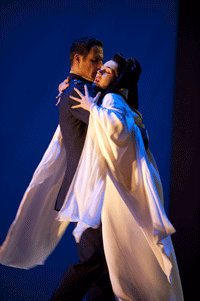 James Valenti as Pinkerton and Kristīne Opolais as Cio-Cio-San
James Valenti as Pinkerton and Kristīne Opolais as Cio-Cio-San
Instead, this production, directed by Moshe Leiser and Patrice Caurier, uses the Japanese context intelligently so it works with the drama. Japanese art is stylized, blank spaces part of the design, so key details stand out in sharp focus. The sets in this production, designed by Christian Fenouillat, are clean and open, so there’s no irrelevant distraction. The backdrop of shoji screens allows quick scene changes, contrasting the interior with the vast panorama outside. It’s a telling comment. As Goro points out, changing the walls changes perspective. This opera isn’t really “about” Japanese society as much as about the way people don’t perceive things in the same way.
As Caurier and Leiser said in their recent interview with Opera Today, Madama Butterfly is “not a beautiful story, it’s awful, it’s violent. Yes, you see the flowers but you must have the smell of blood running through them”. Throughout history, those with wealth and power have always been able to exploit those who don’t. Pinkerton buys a package, house, servants, mock family and a girl to use as sexual convenience. He’s infatuated temporarily by Butterfly’s beauty but he’s under no illusion that he’s interested in her other than as an object to gratify his ego. Perhaps that’s why he takes the child. He can’t conceive that its mother or culture mean anything.
Butterfly is so desperate to escape her background that even before she meets Pinkerton, she’s obsessed about becoming an instant American. She invests so much in her delusion that she can’t cope with reality. She kills herself, not simply because harakiri “is” custom, but because she’s invested so much into her fixation that she can’t live with reality…“nulla, nulla, fuor che la morte”.
Although this is the third revival of this production since 2003, the performance felt vivid because it was directed, not by substitutes, but by Leiser and Caurier themselves. Every performance has to be “new” because casts change and circumstances change. Patricia Racette, who has sung Cio Cio San many times before, pulled out at the last minute, but in some ways that was fortunate, because Kristine Opolais, making her Royal Opera House debut, throws herself so convincingly into the part that she makes it her own. She’s young enough to convey Butterfly’s innocence but has strength of personality, which comes through in her singing. She sings the love duet with such intensity that you wonder how a 15 year old could find such passion, especially for a stranger she’s just met. This emphasizes Butterfly’s single-minded determination. Reality doesn’t get in the way of imagination.
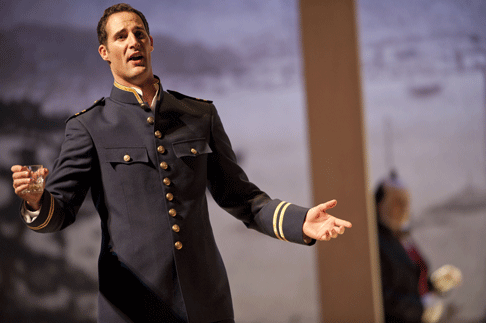 James Valenti as Pinkerton
James Valenti as Pinkerton
Opolais’s Butterfly is nicely varied. After the Bonze’s curse, her voice takes on a tense edge, showing that Butterfly is deeply traumatized, but soon switches back to gentleness when she turns to Pinkerton. Swift reactions matter, for Cio Cio San is always adapting, and living intensely in the moment. Opolias’s interaction with Dolore (Niklas Allan) feels genuine. She’s not singing to an object, or a puppet, but as real mother to real child. Madama Butterflies stand and fall on “Un bel di vedremo”, and Opolais conveys true emotional engagement. She’s not merely describing a sequence of events, but how they feel to her. An interesting voice, with good range, and a natural acting singer. She’s a regular at the Berlin Staatsoper, where she’ll be singing Butterfly in March 2012.
James Valenti as Lt. Pinkerton is rather less successful, although he has had the role in his repertoire for years. Arguably, Pinkerton is emotionally more buttoned up than many men, but Puccini builds a lot more into the part than repression. Perhaps further into the run, Valenti’s voice may blossom, and hopefully be preserved at its best in the film that’s being released on BP Big Screen and cinemas on 4th July. Anthony Michaels-Moore sang Sharpless with warmth, for the Consul is a figure of reasonableness in this claustrophobic world of extremes.
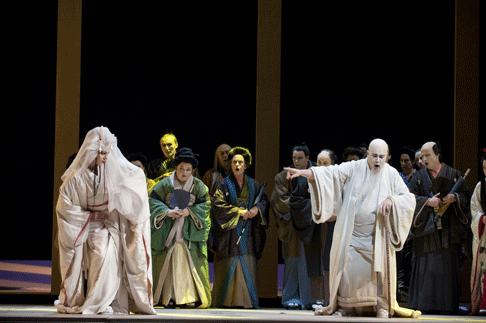 Kristīne Opolais as Cio-Cio-San and Jeremy White as Bonze
Kristīne Opolais as Cio-Cio-San and Jeremy White as Bonze
From the vigour with which Robin Leggate sang Goro, it was hard to believe that he’s retiring after the end of this production, his 909th performance at the Royal Opera House, since 1977. This Goro is directed so he moves swiftly, reflecting the character’s quick wits and cunning. Leggate sings with unflagging energy, despite having to be fleet of foot.
Similarly, Helene Schneiderman’s Suzuki was vibrant and expressive. There’s a lot more to this role than mere servant. Suzuki can be cocky, although she’s loyal. Cio Cio San isn’t completely the mistress even at home. Schneiderman intones her prayer to the gods so forcefully that when she sings with Butterfly, you pick up on the undercurrent of tension that exists even in their relationship. Suzuki’s gods will win; Cio Cio San hasn’t a chance.
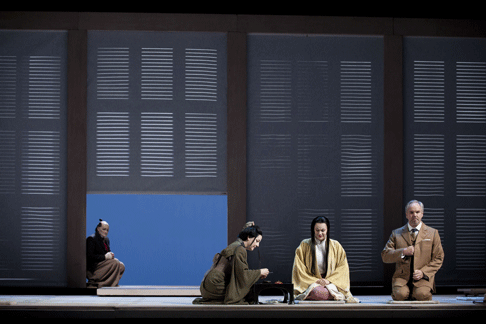 Robin Leggate as Goro, Helene Schneiderman as Suzuki, Kristīne Opolais as Cio-Cio-San and Anthony Michaels-Moore as Sharpless
Robin Leggate as Goro, Helene Schneiderman as Suzuki, Kristīne Opolais as Cio-Cio-San and Anthony Michaels-Moore as Sharpless
Buddhists don’t normally curse people, and in Japan, Buddhism co-exists with Shinto quite happily. Buddhists have a lot in common with Christians too. This Bonze is a figment of Puccini’s imagination, created to inject extreme panic, for he smashes forever Cio Cio San’s links with her past. Perhaps that’s why in this production, he appears all-white, like an apparition of a ghost from a Japanese horror story, not as a living monk. Jeremy White’s Bonze bursts onto the scene, screaming violently, striking terror. Great theatre, as Puccini must have intended.
Zhengzhong Zhou sings Prince Yamadori and Daniel Grice sings the Imperial Commissioner. Both impressed, proving how the Jette Parker Young Artists Programme nurtures singers in good directions. Yamadori is an interesting role which could be developed more than it usually is. Why would a prince marry a second-hand geisha, especially one who’s been cursed for consorting with foreigners? He rides a carriage up the steep hill, whereas everyone else in this opera walks. Why would a man of that status humiliate himself by divesting all his other wives? Zhou sings the part with tenderness, creating a sincere Yamadori who is emotionally honest and vulnerable though he has all the trappings of power. Pinkerton in reverse?
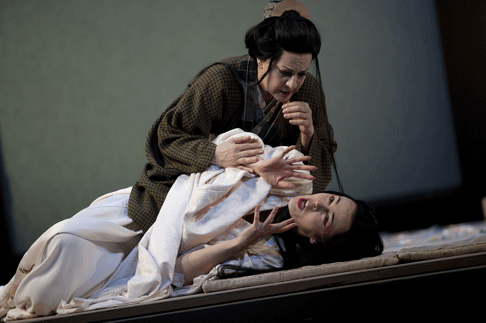 (Front to Back) Kristīne Opolais as Cio-Cio-San and Helene Schneiderman as Suzuki
(Front to Back) Kristīne Opolais as Cio-Cio-San and Helene Schneiderman as Suzuki
Andris Nelson conducted. He’s currently Music Director at the City of Birmingham Symphony Orchestra (Simon Rattle’s former post), but conducts a lot of opera, including engagements in Bayreuth, New York, Berlin and Vienna.
For more information, please see the Royal Opera House website.
Anne Ozorio
image=http://www.operatoday.com/MADAMA-BUTTERFLY.10077_0190.gif image_description=Kristīne Opolais as Cio-Cio-San [Photo by Mike Hoban courtesy of The Royal Opera] product=yes product_title=Giacomo Puccini: Madama Butterfly product_by=B F Pinkerton: James Valenti; Goro: Robin Leggate; Suzuki: Helene Schneiderman; Sharpless: Anthony Michaels-Moore; Cio Cio San: Kristine Opolais; Imperial Commissioner: Daniel Grice; Cio Cio San's family: Eileen Hamilton; Alan Duffield; Elizabeth Key; Kiera Lyness; The Bonze: Jeremy White; Prince Yamadori: Zhengzhong Zhou; Dolore: Niklas Allan; Kate Pinkerton: Rachael Lloyd. Orchestra and Chorus of the Royal Opera House. Conductor: Andris Nelsons. Directors: Moshe Leiser and Patrice Caurier. Set Designer: Christian Fenouillat. Costume Designer: Agostino Cavalca. Lighting Designer: Christopher Forey. Royal Opera House, London, 25th June 2011. product_id=Above: Kristīne Opolais as Cio-Cio-SanAll photos by Mike Hoban courtesy of The Royal Opera
June 27, 2011
Madama Butterfly by Caurier and Leiser
Leiser and Caurier hardly need an introduction. Over the last thirty years, they’ve created nearly 80 productions, all over the world.
Caurier and Leiser are directing the fourth revival of their acclaimed Madama Butterfly, first produced in 2003. This revival is being filmed for the BP Summer Big Screen on 4th July and recorded in 3D for cinema release. They arrive fresh from the dress rehearsal, where gigantic film cameras soared over the stage, and dollies moved up close to the singers. “Very up close!”, says Caurier. “The first film of this production was made in 2003 by the BBC", says Leiser. "…They were wonderful, they worked very closely with us, and the result was good". Directing for film and directing for stage are different disciplines, and the new 3D technology is more different still.”
“We changed nothing in the production for this film and had no say in the direction or the technology”, says Lieser. “The revival was decided long ago. We agreed because you have to accept that media is changing, but we have no input at all in this filming…
"We think of ourselves as acting directors” says Caurier. “For us, what is going on inside the characters and between the characters is most important, and hopefully that’s what will come across…. "Primarily, what we do is theatre”, Leiser adds, “no ‘empty singing’ or people standing around”.
“Madama Butterfly is a tragedy, not a melodrama”, says Leiser. “What really mattered to us is that the opera speaks about something very important that still exists today.” “Sex tourism” adds Caurier. “But on a wider plane it is about how people who have more take advantage of people who have less and are in more difficult situations. This opera is about human beings”, says Leiser, “and how people like Pinkerton have complete non-understanding of anyone else’s culture. Absolutely, this is serious and it is tragedy”.
“Madama Butterfly is political”, says Caurier, “Totally! But we are but we are not there to show a lesson. Puccini shows the situation so people can make their mind up though it’s not very hard if they think about it. That allows us to make the story true. There are a lot of different scenes and moments of lightness, which build up to very strong story telling. What’s wonderful is that there is such an incredible variety of feelings. Madama Butterfly is a fantastic part for a singer because there are so many different situations and emotions. She’s an innocent young girl, then she matures. Sometimes she’s weak, sometimes she’s extremely forceful. All of them precisely characterized in the music and libretto. Our goal when we do Madama Butterfly is to make the emotions happen on stage like they are real”.
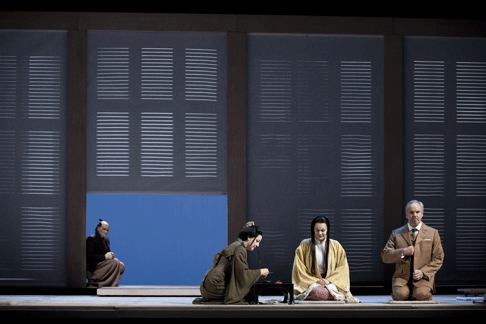 Scene from Madama Butterfly [Photo by Mike Hoban courtesy of The Royal Opera House]
Scene from Madama Butterfly [Photo by Mike Hoban courtesy of The Royal Opera House]
“Music means nothing in itself”, says Leiser, “but it becomes meaning in conjunction with words. Opera singers start with the tune, but composers start with ideas and with words. We work with the singers around the music, because that’s their way of expressing themselves” says Caurier. “We get them to think about why things are written in the score, why one passage is forte, another piano. Why, and how to make something of the markings and feelings, so there’s no moment of ‘empty singing’ and it’s full of meaning”
“In a story like Madama Butterfly”, says Caurier, “It would be terrible if it was just entertainment. It’s too much about human truth and real situations We don’t do beautiful for itself. In this production we made an aesthetic choice not go for ‘folklore’ but for Zen-like purity, the essence of Japanese art, where tiny gestures mean something , and the way people hide their feelings even though they feel deeply. It’s not a beautiful story, it’s awful, it’s violent. Yes, you see the flowers but you must have the smell of blood running through them”.
“Go and look at Japanese woodblocks or paintings. There is a lot of blank space, but there are stories behind the images. Never just milk and honey or the perfume of roses!” says Leiser. “Oui, oui, absolument!” Caurier interjects. “And that’s the way our production looks the way it does , it’s not to indulge. Even the magnolia tree at the end, it’s there because at the moment Butterfly dies, it dies too, and you realize how suddenly life can end.”, says Lieser. “And how a country can be destroyed”, adds Caurier. “Our aim is to be subtle and understated but at every moment I hope that the tension of the tragedy appears”
“Butterfly is very intense”, says Caurier, “She suffers from beginning to end but the last thing we want to see is one emotional colour on stage. It’s important to show the different dimensions and how they develop. That means a non-superficial approach. No ‘generalized weeping’, that’s not right. Every moment has a precise colour, which is specified in the music.”
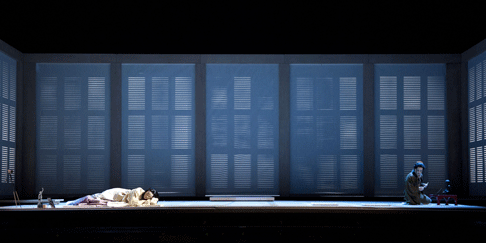 Scene from Madama Butterfly [Photo by Mike Hoban courtesy of The Royal Opera House]
Scene from Madama Butterfly [Photo by Mike Hoban courtesy of The Royal Opera House]
Lieser explains, phrase by phrase, the aria un bel di vedremo, “Butterfly is imagining many different situations — the smoke, the ship entering the harbour, the steep climb up the hill, her wedding gown, and Pinkerton’s final return. In each thought a different shading, it is not all one colour. And that’s just one aria. But we have three hours with so many details, like Butterfly rejecting Suzuki’s gods, and proudly telling Sharpless he’s in an ‘American home’…It’s these small articulations that build up to really tell us who Butterfly is, who Pinkerton is and so on. That’s the real story. In a bad production, you get a generalized idea, but in a good production every one of these articulations need to be developed. All these little fragments are put together so you build up a real human being”.
“Even Pinkerton is a complex character”, says Caurier. “What he says in the beginning is terribly cynical, yet when Butterfly arrives, he’s completely fascinated by this exotic woman, her youth and her beauty. He is sincerely attracted to her. It is sexual, and he knows in his heart it will not last. But for the moment, he means it. That’s important because if he was only a bastard, it would be appalling”.
Leiser adds “The music and the libretto are so deep. Pinkerton isn’t just a ‘bad American’. It’s much more than one dimensional. He wants to abuse a girl of 15 which he would never get away with if he was in America. He’s arrogant and insensitive, but he also shows remorse. That’s why he takes the child away. He assumes that it’s best for the child. The decision is taken quickly, he just expects Butterfly to obey”.
“This opera is a very thoughtful study of the way colonialism works. The Consul, Sharpless, has humanity. He’s been in the country long enough that he has learned to understand the culture. He saw Butterfly in the consulate and knows that she is taking the marriage seriously. He thinks what Pinkerton is doing is wrong, but he cannot go as far as protecting Butterfly because he’s obliged to support American interests.”
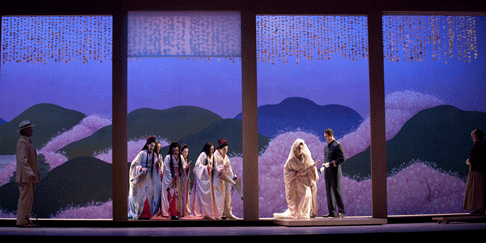 Scene from Madama Butterfly [Photo by Mike Hoban courtesy of The Royal Opera House]
Scene from Madama Butterfly [Photo by Mike Hoban courtesy of The Royal Opera House]
“It’s the colonial mentality”, says Caurier. “And Goro is from the same culture as Butterfly but he makes money by making these arrangements and selling women….It's a situation that can happen all over the world, with different people. It’s not like all Americans are bad and all Japanese are good, it’s much more complicated.”
“People are right to want to kill directors”, says Leiser, “because our primary role is to give people what they don’t expect. With pure music, most people can’t criticize precisely unless they know music and know the score very well. But everyone has mental images of what things should look like. But what we are doing is art. You don’t go to a museum to look at Picasso and then complain it’s not photo-realism like Vermeer”.
“Audiences get attached to images that might not tell the story properly. Like the red rose Carmen is supposed to wear in her hair”, says Caurier. “Everyone demands that, but in the libretto it’s a small yellow flower, like a mimosa but more humble”. “She could be wearing a rhododendron”, adds Leiser, “but it’s not about the flower at all. It’s about what’s happening to Carmen and who she is. It is about how you define freedom. The yellow flower grows in the wild, and when it’s picked it soon dies. Like Carmen.”
“The trouble is that some audiences don’t appreciate that opera [is] art but think in consumer terms”, Leiser adds. “It’s marketing. People want a hamburger that looks like a hamburger. You can put in better quality meat and even a better salad, but people want what they are used to. That’s the danger with film, because it fixes images forever. But opera is a place to expose yourself to the genius of a composer, and to the interpretations of conductor, singers and directors. No one can claim that any one vision is the absolute truth but it is a vision, like it or not. When you come to the opera you can open your ears and your eyes and most of all your soul and take in what is happening…In real live theatre, every performance is slightly different. That’s what keeps live opera healthy. Like a plant it must keep growing to survive. It’s not something that exists just to be consumed.”
“Just like Pinkerton”, says Caurier sagely. “Pinkerton isn’t interested in Japan or even in Butterfly’s feelings, he has just come to consume for his own interests". And look what happens to Butterfly.
Anne Ozorio
For more information please see the Royal Opera House’s web site.
image=http://www.operatoday.com/Butterfly_ROH_2011_04.gif
image_description=Patrice Caurier and Moishe Leiser [Photo courtesy of The Royal Opera House]
product=yes
product_title=Madama Butterfly by Caurier and Lieser
product_by=By Anne Ozorio
product_id=Above: Patrice Caurier and Moishe Leiser [Photo courtesy of The Royal Opera House]
June 26, 2011
Two Boys, ENO
Since late last year, it seems that the personable and obviously multi-talented Muhly has been (pardon the allusion) pushed down our throats from every media-angle, and by too many London hacks anxious to maintain their street-cred in Twitter-land. This kind of media blitz is obviously a two-edged sledgehammer: if the show bombs then everybody looks somewhat foolish, if it achieves critical and/or box-office success (I suspect the latter in this case) then we’ll probably get bombarded again all too soon with the next wonder-kid of modern music. Ah well.
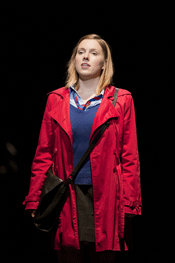 Mary Bevan
Mary Bevan
At the world premiere of Two Boys last night, (cleverly being opened here and not at its co-pro alma mater of the Met) you would have been forgiven for thinking that you had missed the date and wandered into London Fashion Week. Everyone who had read all the supplements, all the tweets, all the blogs and listened to the podcasts — or even just came on spec because everyone else said they should — was there. It was achingly hip. Never mind — we all want opera extending its audience so why not? It probably swelled the coffers of the ENO champagne bar.
So how was it? Well, perhaps one should score it in TV Talent Show style and take it from there:
Story: 6/10, Music: 6/10, Production: 6/10........you get the idea I expect. Singers? Definitely 8/10, if only for commitment to the work, vocal characterisation, and damn good acting within the limits of the production.
Craig Lucas has written a libretto that is based on a true news story of some years ago about two boys, internet chat rooms, assumed identities and attempted murder and this story — slight as it is in dramatic terms — worked to a point. What was lacking was any depth of characterisation, any motivations or emotional developments to give the piece structure. Maybe that was part of the plan: certainly the waves of music that swirled and pulsed and counterpointed the long articulated lines of speech/song didn’t suggest much in the way of dramatic development or journey. Muhly’s work is difficult to describe; his music is like high-class mood-music, or perhaps those compositions carefully constructed and “written to picture” for an expensive nature documentary. It doesn’t challenge the listener, nor does it repel — but I doubt it delighted or surprised many either.
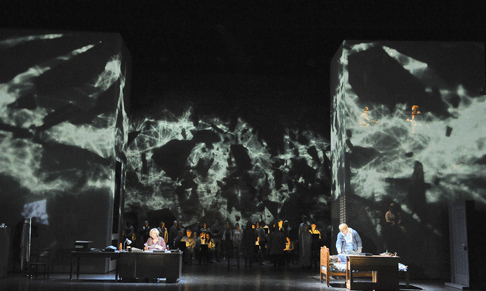 Susan Bickley and Nicky Spence
Susan Bickley and Nicky Spence
The singers were universally good: the core of the story lies with the investigating police officer played by Susan Bickley (does she ever disappoint?) who has demons of her own to confront as a stranger in the strange land of her suspect’s virtual world of net friends. Her diction was excellent and character well-drawn. That suspect, who we know as “Brian”, is sung by young tenor Nicky Spence with a tremendous empathy for this pathetic, unintelligent, bullied young man who’s flashes of desperate anger at his uncomprehending parents just reinforce his weakness and lack of self esteem. That excellent work was matched by the amazingly confident performance of boy treble Joseph Beesley — one just hopes that the calculated evil inherent in his character doesn’t leave too much of a shadow. The many supporting roles were equally well presented and sung without a single unhappy choice — and singers and orchestra (under Rumon Gamba) seemed well-rehearsed and remarkably slick considering this was a first night of an entirely new work.
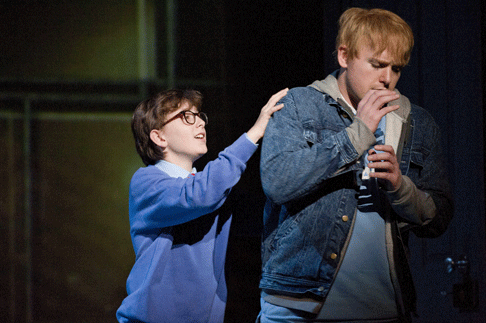 Joseph Beesley and Nicky Spence
Joseph Beesley and Nicky Spence
On the production side, a few good ideas were made much of but could have been given more emphasis — the video backdrops of world-wide internet “chatting” — words repeating, and reappearing, and often mirroring the actual sung words. Some of the best dramatic moments came with the chorus spread around and above the stage suggesting the vast numbers of internet chatters communicating endlessly and pointlessly from their sad individual bedrooms. The graphic video work was good — but again could have been so much more; in fact the whole production just felt as if it were treading far too carefully, too “nicely” and was afraid of upsetting anyone. All a bit anodyne, in essence. Perhaps they will push the boat out a bit more for its New York premiere? Somehow, I doubt it.
Sue Loder.
Six more performances through June and July: see www.eno.org
image=http://www.operatoday.com/Two_Boys_14.gif image_description=Nicky Spence [Photo by Richard Hubert Smith courtesy of English National Opera] product=yes product_title=Nico Muhly: Two Boys product_by=Click here for cast and other information. product_id=Above: Nicky Spence [All photos by Richard Hubert Smith courtesy of English National Opera]Viva Vivaldi — Garsington Opera 2011
The most recent offering is his La Verità in cimento (Truth put to the test) and Garsington have a hit on their hands if the first two performances are anything to go by. The plot is absurd, convoluted and comes down to the effect of one decision, years ago, to switch two babies (and therefore their inheritance) which in turn drives this drama of human love, greed and cold-blooded power seeking. The characters are a dysfunctional royal family whose ruling Sultan is a well-meaning tyrant who makes that one big decision but then lives to regret it as his extended family start to tear each other’s throats out when they learn of the deception as the boys come of age.
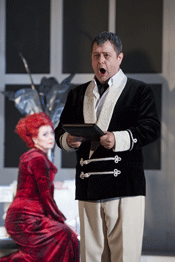
This is high-baroque opera, written by the canny Red Priest in 1720, and it is interesting to note that like his near-contemporary Handel, Vivaldi finds the moral (and immoral) dilemmas of the ruling classes of the utmost interest and worthy of his finest musical expression — after all they were his paymasters and themselves much concerned with the problems of succession, inheritance and political marriage. Unlike Handel however, the Venetian composer doesn’t tend to investigate his character’s deepest emotional conflicts with an extensive series of formal arias in classic da capo form — his music is lighter, fleeter and less organised. And yes, let’s face it, less memorable. However, there are some stand-out moments in this charming and melodic score which reveal some very un-Handel -like trios and ensemble numbers which seem to prefigure an altogether different genre of opera writing still very much on the horizon.
As the machinations of this sumptuously-dressed family unfold (much fur, leather and silk worn by all in a clever mix of styles) there is little action per se other than inside each character’s head — so all credit to director David Freeman for making the most of a delightfully outré set designed by Duncan Hayler which offers us an icy palace of glass, metal and white fur rugs with a gleaming, huge white tree dominating as a centre piece. The tree, whose two main branches sweep to the far sides of the stage, presumably symbolises the two warring factions of the two sons and their respective mothers (Sultana Rustena and Mistress Damira) but it also acts as a refuge, love-nest, and lair with its varying levels of platforms and steps. This is clever use of space, and together with the rear and side exits this configuration helps the story zip along as effectively and wittily as does the music from the pit below, directed (and, it would sometimes seem, driven almost physically) by a bobbing, sweeping and multi-tasking Laurence Cummings.
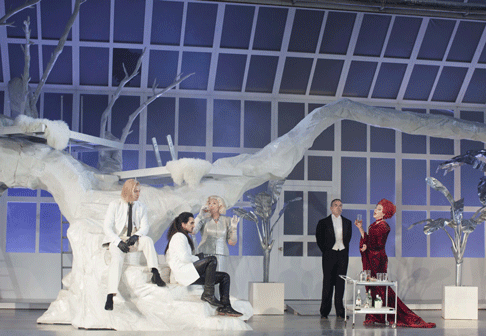
With all the emphasis on the emotions and thoughts of the characters and little physical action or change of location, it is obviously supremely important to have the right bunch of performers and once again Garsington must be congratulated on getting it right. The casting splits into two near-equal halves of the three older generation characters of Sultan, his Sultana, and his long-established Mistress and the three main young characters of his two sons and a visiting Princess who they both (naturally) fall for. Paul Nilon, Jean Rigby and Diana Montague fulfil those elder roles with enormous energy, musicianship and effortless virtuosity: Nilon’s flexible and expressive tenor and stagecraft are as good as ever as the Sultan, Jean Rigby’s (Sultana Rustena) dark mezzo soprano lends itself to her character’s emotional highs and lows (she has a gorgeous slow aria of despair “Fragil fior”, with recorder obbligato, that drew deserved applause), and Diana Montague (Damira, mezzo soprano) was stunning in her portrayal of the wronged Mistress who plans revenge — elegant and fluent coloratura mixed with effortless long-lined phrasing which mirrored her equally elegant couture gowns. These seasoned performers were the musical core of the production, holding everything together with an easy command of the idiom.
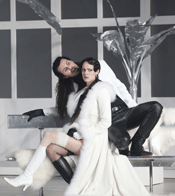
Flying higher above them, musically at least, were the younger generation of singers and characters and here the casting was almost as sure-footed. The young soprano Ida Falk Winland (winner of the Song Prize in the 2008 Ferrier competition) divides her time between her native Sweden and the UK at the moment and has an attractive voice with both a bit of weight to it and an obvious facility for Vivaldi’s ornate lines. She was often singing with either one or both of her “suitors”, the two half-brother princes who, in this production (unlike in the original of 1720, )are sung by countertenors Yaniv d’Or and James Laing, and as it often the way with this voice type the soprano out-sang both in terms of sheer volume. This did tend to unbalance the music somewhat which was a shame as there is a terrific trio for the three which could have been stunning, and perhaps needed a little adjustment on the part of the young Swede for the greater good of the ensemble sound. Yaniv d’Or, ( Melindo), who is not well known in this country, sang and acted with commitment and verve but his voice is not one that immediately attracts. James Laing (Zelim) has a sweet tone, more even and polished than his stage-brother, and I liked his easy top and legato in his more reflective arias. Two non-speaking roles of butler and gardener (the latter oddly placed throughout at the side of the stage busily tying and untying bunches of herbs and flowers — your guess is as good as mine) are uncredited in the programme book.
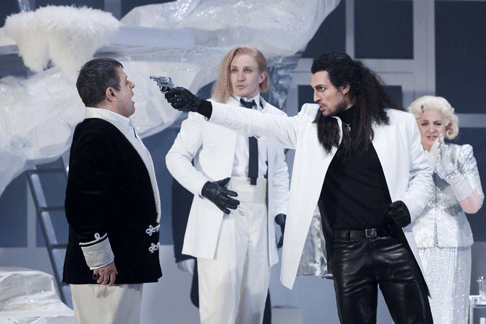
This might not be world-class opera seria (or buffo) but it is fun, it’s musically fleet-footed and charming , it’s cleverly-produced and directed, and the singers are well-cast and attractive: what more does one need for a high-summer’s evening entertainment in the lush green of an English rural estate? Here’s to Garsington’s next exposé of Vivaldi’s “lost” operas — they are setting themselves a high standard.
Sue Loder
Next performances: 25th, 29th June and 1st, 4th, July. Garsington (at Wormsley), Oxfordshire, UK.
image=http://www.operatoday.com/LaVeritainCimento_06.gif image_description=Antonio Vivaldi: La verità in cimento [Photo by Johan Persson courtesy of Garsington Opera Festival 2011] product=yes product_title=Antonio Vivaldi: La verità in cimento product_by=Click here for cast and other production information. product_id=All photos by Johan Persson courtesy of Garsington Opera Festival 2011June 24, 2011
Lehnhoff takes on Fanciulla for Netherlands Opera
A citizen of the U.S.A. may well discover with some alarm that we Americans are seen as crass capitalists with sentimental streaks and a penchant for firearms and random violence, all carried along with a confidence alternately charming and cloying. Traditional productions of Puccini’s La Fanciulla del West reflect this a bit, as inherent in the material. Minnie, the virginal, Bible-teaching owner of a saloon during the Gold Rush in the Sierra Nevada Mountains, fights off the lusty Sheriff Rance while falling hopelessly for highwayman-in-disguise Dick Johnson. Pistol in hand, she saves Johnson (already grievously wounded by Rance and his men) from a lynching, and they ride off into the sunset at opera’s end, singing “Addio, California.” The creaky plot centers on Johnson and his gang’s plan to steal the money and gold from the safe Minnie maintains for the prospectors at her saloon, but it is Minnie herself who is the real treasure.
Director Nikolaus Lehnhoff loves the sheer absurdity of it all, but the triumph of his wild production for the Netherlands Opera is how much of Puccini’s original intent shines through, because it’s all there in the score — the redemptive power of love, and the drama of broken people trying to remake themselves into something resembling a whole person.
One could wish Lehnhoff didn’t begin the opera with projections of 20th century stock traders yelling and waving their arms on an exchange floor, and then end the opera with projections of dollar bills on the scrim, raining down on Minnie and Johnson as they sing their goodbyes to the Golden State. In between, however, despite some stylized updating (Minnie’s “cabin” is a motor caravan with a Barbie-doll pink interior), Lehnhoff stays true, for your reviewer, to the spirit of the opera. The miners all adore Minnie as always, Wowkle and Billy Jackrabbit are as politically incorrect as ever, and the exquisitely scored entrances and dramatic climaxes of Puccini’s music are all reflected in the stage action. No, Minnie doesn’t ride in on a horse in act three, and Johnson is on top of a wrecked auto in a salvage yard as the noose is placed around his neck, but in theatrical context, it all works.
And the chief reason this works is Lehnhoff’s excellent cast, starting with his star, Eva-Maria Westbroek. With a passing resemblance to Carol Neblett, not only is Westbroek physically suited for the role, but she has the sizeable instrument the role requires. High note aficionados may rank Westbroek’s as somewhat under the top range on a scale of 1-10 — they don’t “bloom” — but she has the notes. And when Minnie gets to express her softer side, Westbroek can manage that singing very well too. Speaking of Neblett, in a charming if lightweight bonus feature, Westbroek speaks of her love for the justly famous Covent Garden video of Fanciulla with Domingo and Neblett, in a staging that Westbroek herself joyfully accepted the opportunity to perform in.
Westbroek’s primary male colleagues aren’t quite matches for Domingo and the Rance of that Covent Garden video, Silvano Carroli, though both Zoran Todorovich as Johnson and Lucio Gallo as Rance fit their roles well. Todorovich has a big, unsubtle technique, which works for some of the role but crucially lets him down for the biggest moment, the act three aria “Ch’ella mi creda.” It can be said that he looks pretty darn good (for a tenor) in leather jeans. Gallo’s baritone is far from being the most beautiful as well, and his act one aria is not much more than adequate. He relishes being the villain of the piece, however, and his commitment adds to the staging’s success. In the smaller roles, Roman Sadnik is very amusing as a campy Nick the bartender, and André Morsch sings Jake Wallace’s plaint prettily enough.
The reliable Carlo Rizzi leads the Netherlands forces with professional skill. In Blu-Ray the many details of designer Raimund Bauer’s sets come through with crystal clarity. In its own way — a way which will, undoubtedly, not work for more traditional viewers — the entire staging has its own beauty. This shouldn’t be the only Fanciulla lovers of this magnificent opera possess, but anyone open to Lehnhoff’s point of view will find it a smashing entertainment.
Chris Mullins
image=http://www.operatoday.com/OABD7075D.gif
image_description=Giacomo Puccini: La Fanciulla del West
product=yes
product_title=Giacomo Puccini: La Fanciulla del West
product_by=Minnie: Eva-Maria Westbroek; Jack Rance: Lucio Gallo; Dick Johnson: Zoran Todorovich; Nick: Roman Sadnik; Ashby: Diogenes Randes; Sonora: Stephen Gadd; Billy Jackrabbit: Tijl Faveyts; Wowkle: Ellen Rabiner; Jake Wallace: André Morsch; José Castro: Roger Smeets. Netherlands Opera Chorus. Netherlands Philharmonic Orchestra. Carlo Rizzi, conductor. Nikolaus Lehnhoff, stage director. Recorded live at The Amsterdam Music Theater, November and December 2009.
product_id=Opus Arte OABD7075D [Blu-Ray]
price=$39.99
product_url=http://www.arkivmusic.com/classical/album.jsp?album_id=523251
June 23, 2011
The Cunning Little Vixen, New York
In Wagner’s day, the idea that the operatic experience should be the sum of all its parts was revolutionary. Today, the conception of opera as a total theatrical experience is de rigeur, and as a consequence, is at the heart of the revival of New York’s classical music scene. This is evident in the figures of Alan Gilbert and Peter Gelb, who recently took hold of the helms of the New York Philharmonic and the Metropolitan Opera, respectively.
The past two years have seen the presentation of two fully staged operas at the Philharmonic. In both cases, the choice of repertoire has been less than conventional. This year, Janáček’s The Cunning Little Vixen continues what seems to be an auspicious tradition begun by Ligeti’s Le Grand Macabre.
Gilbert has stated that his main reason for presenting such unfamiliar repertoire is his desire to demonstrate the prowess of the Philharmonic orchestra, as opposed to solely the singers. However, both The Cunning Little Vixen and Le Grand Macabre were treated in such a way that depicted these works not only as great music but also as great theater. Furthermore, Gilbert can congratulate himself on the large number of young people who have attended these performances.
The Philharmonic’s Cunning Little Vixen is certainly a star-studded event. The well-known Grammy-winning soprano Isabel Bayrakdarian is the eponymous heroine. The production is directed by Doug Fitch, who directed Le Grand Macabre to great acclaim. However, the true star of the evening was Alan Gilbert and the New York Philharmonic.
As usual, Gilbert proved himself to be adroit in handling both dynamics and textures. Additionally, he frequently highlighted the rhythmic pulse behind the music. This was especially apt as folk melodies served as inspiration for much Eastern European music.
As the opera progressed, Gilbert also managed to expose the audience to similarities between Janáček and Puccini as well as Richard Strauss . As Janáček was influenced by Puccini, this was especially relevant. Still, it must be acknowledged that in his zeal to show off the Philharmonic in all its glory, there were times when the Tim Burtonesque nature of the score seemed to suffer. However, those moments were few and fleeting.
As Sharp Ears, Miss Bayrakdarian conceived the vixen as the type of strong, independent heroine opera audiences have come to know and love. Her portrayal pointed at a central facet of the opera, which has endeared it to audiences through the decades. Despite its short duration, Janáček’s music depicts the vixen at all stages of life and growth. The audience gets the chance to see a character grow not just physically, but emotionally, and mature into adulthood. Miss Bayrakdarian’s performance was dynamic and demonstrates all facets of this deceptively simple yet complex character.
Miss Bayrakdarian’s voice has a smooth silvery quality to it. This is thrilling to experience in performance. Unfortunately, her diction and ability to project left much to be desired. It was very difficult to hear her in the back row. What is more unfortunate is that this problem was symptomatic of most women in the cast. That said, there were many wonderful performances. Kelley O’Connor, as the dog Lapák, demonstrated the extent of her rich mezzo voice. Her lovelorn howls added a tragicomic element to the character, which served to great effect. Marie Lenormand portrayed the fox as a boyish bon vivant who was at the same time charming.
In terms of diction, the men fared much better. As the Forester, Alan Opie gave a nuanced portrayal. He brought pathos to his closing aria, which drew parallels between the despair of the human characters and the felicity and fulfillment of their animal counterparts. Also, his stentorian voice was a joy to listen to.
However, there was a confusing inconsistency in the portrayal of his character. The Forester is supposed to protect the animals from poachers. This seemed at odds with his harsh treatment of the vixen. As the poultry dealer, Joshua Bloom sang lyrically and brought nonchalance to the role.
Doug Fitch, who directed the production, presented the opera in an imaginative and eco-friendly light. Many of the costumes were made of recycled objects. The beetle costume, for instance, was made out of a garbage can. More importantly, they used Avery Fisher Hall as a performance space. An extension was put onto the proscenium, which allowed the singers to sing from the middle of the orchestra.
Performers also entered and exited through the auditorium’s center aisle, as opposed to solely on stage. To aid in this aspect, the lights were used to create the illusion of sun shining through treetops on the center aisle. Additionally, the English translation was immensely funny and full of jokes that appealed to kids and adults alike. Perhaps more important, however, was the fact that the translation fit the music.
Despite occasional flaws, the New York Philharmonic can congratulate itself on concluding its season in grand style. The fact that the auditorium was nearly full attests to the success of Gilbert’s initiative, yet there is another goal that is also being met in this production. The Cunning Little Vixen has not been seen in New York in twenty years, perhaps not since Beverly Sills commissioned a production of it for City Opera. That this opera is part of the standard repertory is not to be disputed, but the fact remains, it does not have the reputation it should. It can only be hoped that the Philharmonic’s imaginative production brings this opera one step closer to garnering more popularity.
Gregory Moomjy
image=http://www.operatoday.com/Janacek.gif image_description=Leoš Janáček product=yes product_title=Leoš Janáček: The Cunning Little Vixen product_by=Click here for cast and other information relating to this production. product_id=Above: Leoš JanáčekPeter Grimes, Covent Garden
For in this reading, it is Britten’s powerful choruses which really excite and dominate: a frightening embodiment of Victorian moral hypocrisy and viciousness, the grey-costumed mob ebb and flow, an amorphous mass exerting an oppressive and irresistible moral force.
There’s nothing inherently wrong with this reading, for Britten’s opera contains astonishingly virtuosic ensembles which erupt in Verdian climaxes. Think of the intricate polyrhythms of the shanty, ‘Old Joe has gone fishing’, where the lop-sided 7/4 tempo aptly conveys the community’s struggle both to resist the storm raging outside the tavern and to quell the disturbances caused by Grimes’ presence within. However, something of the rich diversity of the community, and thus of the opera’s colour palette, is lost. At times, the stage seems over-populated and the incessant movement can be messy and distracting; and, it’s hard for the colourful cast of minor roles to emerge with clarity from the crowd. Even in the Prologue, when Grimes is called to account for the apprentice’s death, Matthew Best’s Swallow struggled to contain the baying throng and to assert his authority despite his well-focused voice and confident stage manner.
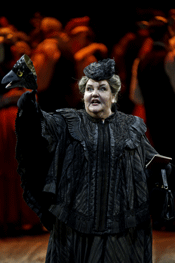 Jane Henschel as Mrs Sedley
Jane Henschel as Mrs Sedley
Some of the cast did manage to rise above the multitudes. Roderick Williams was an engaging Ned Keene, his warm tone and lyricism often suggesting a less antagonistic attitude towards Grimes – a much needed counterpoint to the pack’s pitiless cruelty. Martyn Hill’s Rector came effectively to the fore without strain, while Balstrode’s sincerity and authority was well captured by Jonathan Summers. Although Decker’s Mrs Sedley lapses into caricature, Jane Henschel cleverly suggested the latent power she exerts; seated stony-faced at the front of the stage, impervious to the taunts and ridicule of the drinkers in the tavern scene, she later becomes the driving force behind the persecution, leading the community in the unquestioning conformity. Moreover, in an unusually striking presentation of these minor female roles, Auntie (Catherine Wyn-Rodgers) and her two Nieces (Rebecca Bottone and Anna Devin) provided a welcome splash of visual and vocal colour in the tavern scene.
Amanda Roocroft tried hard to inject some warmth and tenderness into what is a rather severe interpretation of Ellen Orford, the village school mistress who yearns to save Grimes from the Borough’s tyranny and from his own inner demons. In a typically strong characterisation, Roocroft was imposing in the face of the community’s onslaught and criticism, using lyricism to oppose their callousness. However, dramatic strength was sometimes achieved at the expense of clear diction and musical accuracy, and an overly wide vibrato at times resulted in a slightly unfocused tone.
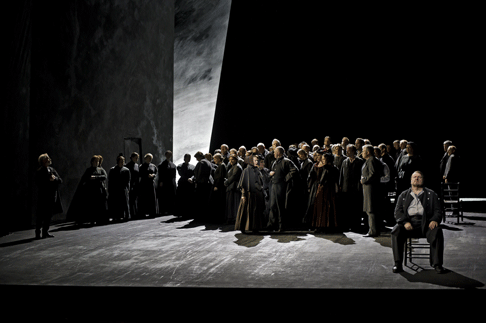 Prologue, Ben Heppner as Peter Grimes
Prologue, Ben Heppner as Peter Grimes
But, the real problem with this production is that the fate of its protagonist is never in doubt. There is not ‘conflict’ so much, between the outsider and the community, as total alienation. Estranged and unapproachable from the start, distressingly obsessed with the child’s coffin when Ellen tries to call him away, this Grimes is totally isolated and impossible to ‘save’: in Act 3 he simply covers his head (mimicking his apprentice’s earlier gesture of fear) when Ellen and Balstrode attempt to reach out to him. However, the libretto avows his intent to earn enough money to marry Ellen – he wants to win her respect and not just her pity – and to win acceptance by the community: and, it is hard to believe in this declaration or to understand why anyone would want acceptance from this community.
Ben Heppner certainly conveyed Peter Grimes’ existential despair. He is clearly a victim, and his obvious guilt and remorse should earn our forgiveness. Yet even during his visionary soliloquies and angry counter-attacks, Heppner struggled to retain his place at the centre of the audience’s vision. Moreover, there were major vocal concerns. His duet with Ellen in the Prologue was marred by poor tuning and frequently, as in ‘What harbour shelters peace?’ where the soaring minor ninths recall the tentative optimism and yearning of the Prologue duet, the voice sounded gravelly and strained. Short fragmented phrases and a rough-hewn quality created a sense of breathlessness and unease, but there was no sense of Grimes’ inner lyricism.
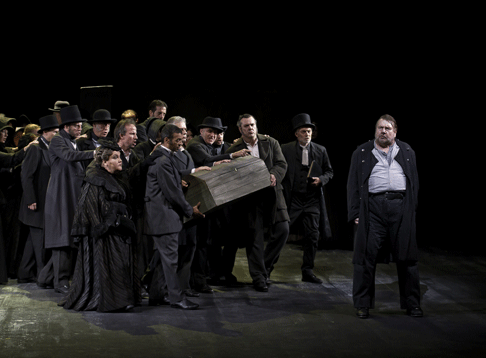 (Left to Right) Jane Henschel as Mrs Sedley, Roderick Williams as Ned Keene, Matthew Best as Swallow, Alan Oke as Bob Boles, Stephen Richardson as Hobson, Martyn Hill as Rector, Ben Heppner as Peter Grimes
(Left to Right) Jane Henschel as Mrs Sedley, Roderick Williams as Ned Keene, Matthew Best as Swallow, Alan Oke as Bob Boles, Stephen Richardson as Hobson, Martyn Hill as Rector, Ben Heppner as Peter Grimes
So many of Grimes’ numbers, originally designed to suit and enhance the vocal characteristics of Peter Pears, are mercilessly exposed; and in ‘The Great Bear’ Heppner could not control the floating head voice required. The descending scales, which convey the futility of Grimes’ hopes that he will turn the skies back and ‘begin again’, were woefully flat. Since so much of the drama is conveyed through harmonic conflicts and relationships, this was both musically dissatisfying and disrupted the dramatic arguments of the work.
These five performances at Covent Garden are dedicated to three recently deceased tenors, each of whom has stamped their own identity on a role defined for so long by Pears: Philip Langridge, Anthony Rolfe-Johnson and Robert Tear. Neither Decker nor Heppner present us with a Grimes to challenge these forebears. Decker’s Grimes does not even look like a fisherman! More importantly, in this opera so much depends on ambiguity (‘perhaps you’re not to blame that the boy died’, says Balstrode): we look in horror but we understand, we shudder but forgive, and this delicate balance between opposing forces – dramatic and musical – needs to be sustained. Decker’s vision is powerful in its clarity but loses the dramatic tension that such ambiguity bestows.
Finally, it is a vigorously anti-religious production, a reading that is perfectly justified by the text and complements the Victorian updating. But, of Britten’s desire “to express my awareness of the perpetual struggle of men and women whose livelihood depends on the sea”, there is little acknowledgement – apart from some Turner-esque backdrops. As the curtain rises in Act 1, the orchestra paints a picture of the dawn labours of a community dependent on the sea: ripples in the clarinet depict the glitter of the rising sun on the tossing waves; a high, ornamented melody recreates the dips and dives of a soaring gull; surges in the brass announce the ocean’s threatening undercurrents. The chorus sing of the duties which draw the fishing families together in hardship, perseverance and solidarity. Decker presents us with a church congregation, literally singing from the same hymn sheet – but the rhythms are those to accompany the hauling of nets and the tugging of sails. Although this dramatic motif returns in a powerful gesture in the closing moments of the opera – as, defeated, Ellen reluctantly takes her place among the worshippers, covering her face with the hymn sheet, to erase her identity and resistance – it sits awkwardly with the musical drama.
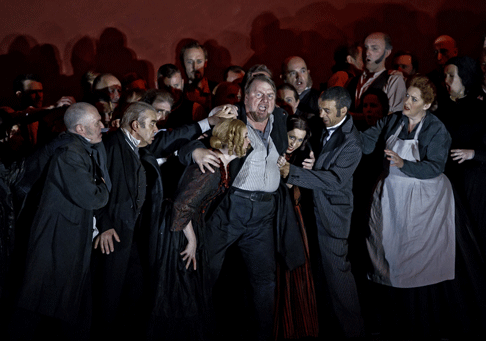 (Left to Right) Alan Oke as Bob Boles, Jonathan Summers as Balstrode, Anna Devin as Second Neice, Ben Heppner as Peter Grimes, Rebecca Bottone as First Neice, Roderick Williams as Ned Keene, Catherine Wyn-Rogers as Auntie
(Left to Right) Alan Oke as Bob Boles, Jonathan Summers as Balstrode, Anna Devin as Second Neice, Ben Heppner as Peter Grimes, Rebecca Bottone as First Neice, Roderick Williams as Ned Keene, Catherine Wyn-Rogers as Auntie
John Macfarlane’s set is visually impressive; steeply raked walls and a tilted stage increasing the sense of claustrophobia and repressed chaos. And, conductor Andrew Davis certainly drives the pace incessantly forward with a real sense of urgency and passion, even if he does not always achieve the required fullness of texture and depth of resonance. But ultimately there are too many compromises, and the cast, especially Heppner, are not quite strong enough to make Decker’s vision convincing.
Claire Seymour
image=http://www.operatoday.com/PETER-GRIMES.110615_0158.gif image_description=Ben Heppner as Peter Grimes [Photo by Clive Barda courtesy of The Royal Opera] product=yes product_title=Benjamin Britten: Peter Grimes product_by=Peter Grimes: Ben Heppner; Ellen Orford: Amanda Roocroft; Captain Balstrode: Jonathan Summers; Ned Keene: Roderick Williams; Mrs Sedley: Jane Henschel; The Rector: Martyn Hill; Auntie: Catherine Wyn-Rogers; Her Nieces: Rebecca Bottone, Anna Devin: Swallow: Matthew Best; Hobson: Stephen Richardson. Dr Crabbe: Walter Hall; Apprentice boy: Patrick Curtis. Director: Willy Decker. Conductor: Andrew Davis. Revival Director: François de Carpentries. Designs: John Macfarlane. Lighting Design: David Finn. Choreography: Athol Farmer. Revival Choreographer: Ruth Moss. Royal Opera House, London, Tuesday 21st June, 2011. product_id=Above: Ben Heppner as Peter GrimesAll photos by Clive Barda courtesy of The Royal Opera
June 22, 2011
Will Crutchfield: Interview with the Director of Opera for the Caramoor Festival
He returned to his theater roots in the mid-1990s to conduct opera. He has held leading positions with the national operas of Bogota, Colombia, and Warsaw, Poland, and has been Director of Opera for the Caramoor International Music Festival in Katonah, New York, since 1997. At Caramoor, he has been noted for his revivals of unusual bel canto repertory as well as for re-examinations of familiar masterpieces. This summer, Caramoor’s offerings will include H.M.S. Pinafore, on June 25 and, in two performances, on July 9 and 15, each preceded by pre-opera lectures and related concerts, Rossini’s last opera, Guillaume Tell, given in the original French and starring Julianna Di Giacomo, Michael Spyres and Daniel Mobbs.
 Daniel Mobbs [Photo by Will Crutchfield]
Daniel Mobbs [Photo by Will Crutchfield]
Crutchfield served on the faculties of all three New York conservatories (Juilliard, Manhattan and Mannes) and he continues to devote the summer months to extensive training programs at Caramoor. Some of the singers with whose debuts and early careers he has been associated include Vivica Genaux, Nancy Herrera, Marguerite Krull, Bruce Fowler, Daniel Mobbs, Georgia Jarman, Yegishe Manucharyan, Olga Makarina, Kate Aldrich and Alexandra Deshorties. An often-noted component of Crutchfield's research, as of his practical work with singers, has been the recovery and development of the art of ornamental improvisation. His speaking voice is familiar to audiences from his frequent intermission broadcasts from the Metropolitan Opera. He is currently completing a book on performance practice in Italian opera.
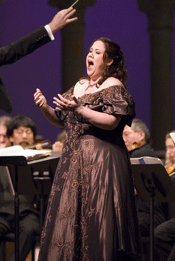 Julianna Di Giacomo [Photo by Will Crutchfield]
Julianna Di Giacomo [Photo by Will Crutchfield]
John Yohalem: No doubt you’re sick of this question—
Will Crutchfiield: “What is bel canto?”
JY: Exactly, and every definition is different, but what would YOU say is bel canto?
WC: Bel canto refers to the entire tradition of Italian singing from before the dawn of opera down to Elliott Carter. It was felt that Italians were the ones who knew how to sing, who provided the method, the path for others to follow.
JY: And what characterizes a bel canto opera?
WC: The narrow meaning of the term is an opera composed for a vocal style of high virtuosity and highly trained voices, with a wide range of colors and expressivity. This happened to come together at the height of the romantic movement [in music, drama and art as well], to make a pretty potent mix. This style has lasted to the present day. In its heyday [c.1810-45], that music was probably the most popular art form on earth. It had a broader audience than any orchestral composer, writer, stage dramatist anywhere —when you think of how many opera houses there were and what works played there.
JY: How does the music of what is called the “bel canto” era differ from the era of Verdi or Verismo that followed? Why did the earlier style fall out of fashion?
WC: Did it ever fall out of fashion? We forget that it was most unusual in those days for music of an earlier time to be heard at all. Of opera—only Don Giovanni or, in Paris, some of Gluck’s operas or, in Germany, a few other Mozart operas, Figaro or Flute, remained in the repertory. Rossini’s Barbiere was extraordinary in becoming a classic instantly, in never being forgotten. Neither was Donizetti’s Lucia or Don Pasquale or L’Elisir d’amore—or Bellini’s Norma. That was remarkable right there—that five operas did survive. And for most of the century, far more than that were remembered, not as revivals but as repertory items: Sonnambula, Lucrezia Borgia, La Favorite, La Fille du Regiment, Semiramide, Rossini’s Otello, certainly Guillaume Tell. And these works led directly to Verdi—whose operas have never been out of the repertory.
JY: I’ve always loved bel canto and opera seria myself, but most such works were seldom given for a long time. Now they’ve come back into style, revived everywhere. What is their appeal for modern audiences? Why did they reappear when they did, after World War II?
WC: After the war, New Music was in crisis. Opera had an established audience for a certain sort of music, and there was a natural desire for novelty. The new composers did not wish to compose for anything like the traditional style of singing, and so the audience had to look elsewhere for satisfaction.
It didn’t have to happen the way it did. It would have been more logical for the audience for Italian opera to look back to the operas of Alessandro Scarlatti. When you look at what “revival” meant in the rest of the “Early Music” movement, the Italian style isn’t part of it at all, for a very long time. It was Germans, English, French, Dutch—they created the “Early Music” sound, and they weren’t looking at anything later than 1700—or at the Italian operatic style. They were looking at Machaut and Telemann. So “bel canto” opera was of no interest to them, and they wouldn’t have been able to perform it properly anyway. The way they did perform owed very little to the Italian traditions of those early periods.
The person who changed everything was Maria Callas. She had the old-fashioned skills to perform things as they should be done, and she did it with utter seriousness. Anything that goes out of fashion but lingers comes to seem comic, parodistic—can no longer be taken quite seriously. If you want to make a parody of a coloratura, a cartoon of the Bell Song, say, then Lily Pons, great as she was, would be perfect for the part. But Callas did not need to wink or nod. She had the correct interpretation and the integrity to stand before the musical world of the 1950s and say, “This can speak to you the way Glenn Gould’s Bach speaks to you, or Furtwangler’s Beethoven speaks to you.” This influenced so many people, convinced them it was valid: Horne, Sills, Caballé, Sutherland. And scholars like Philip Gossett said, “There’s no scholarly edition of these scores! It’s never been done! There’s a doctoral thesis here!”
What the 21st century needs is more cohesion between the style of Pavarotti and Freni and the current non-Italian and non-operatic training that’s inevitably incomplete. You might say Verismo singers could no longer do justice to the ornamental traditions, singers of the revival can’t do legato outpourings of sheer physical sound, the luxurious beauty of sound and that way of carrying elemental truth combined with looking at the old rule books. We listen to the singers of the early twentieth century as they sing far older music, the “arie antiche,” and we turn up our noses at their affectations—but they knew certain things, they remembered certain traditions that were still valued then.
We’ve got the toolkit. We need individual performers who absorb and immerse themselves in this amalgamation, making music and giving it meaning. No sound means anything on paper—it only means something if there’s someone able to expound it to the audience and have the audience get it.
JY: What qualities do you look for in voices for the Caramoor bel canto program?
WC: Number 1. Voice 2. Enough technical preparation so that they’re not flummoxed by the demands of bel canto. 3. A communicative impulse—a desire to take what they have and pass it to an audience.
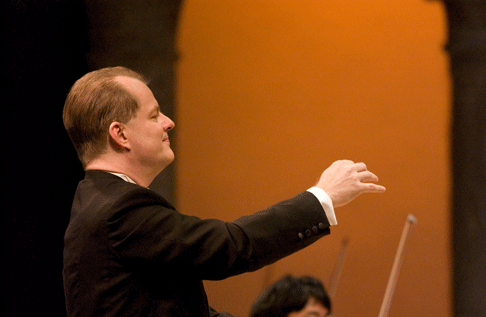 Will Crutchfield [Photo by Gabe Palacio]
Will Crutchfield [Photo by Gabe Palacio]
JY: What neglected operas seem to you especially worthy of revival, for your own program and on the opera stage?
WC: We started out doing mostly rarities, but we decided there were a lot of not-so-rare works that deserved a new, a closer look, and now about half the things we do are rarities, the others—not so rare.
My wish list includes Lucia—which I think is worthy of more study, a fresh look. Then, I think Handel belongs to the mainstream of the bel canto tradition. We tried to do a series of Handel operas at the Manhattan School, but it got in the way of their vocal department’s other projects—they weren’t going to just turn the whole department over to the study of Handel, and they shouldn’t, so we got in each other’s way and that didn’t work out.
Then I want to do Auber’s La Muette de Portici—a very strong piece—and Meyerbeer’s Dinorah, a score that may well be his best. I love Les Huguenots, it’s a wonderful opera, but Botstein did it very well at Bard two years back, so it’s not unfamiliar to New York.
Then there are Verdi’s operas composed in French, for Paris—major operas of Verdi that have never been performed in the proper language in New York. Don Carlos is a French opera. People think he composed it for Paris and then wrote it again in Italian, but that’s not true—the version we usually hear is just a clumsy translation; it’s not the opera Verdi composed, which is a masterpiece and New York has never heard it.
JY: How about the bel canto operas of Mercadante or Pacini?
WC: The only operas of Mercadante that I might do—that appeal to me at all—are La Vestale and I Briganti. But I’m not exactly passionate about him. I like to feel as close as possible to an unreserved love for any opera I’m doing. If I do Don Pasquale, I know it’s not as great a score as Falstaff is—but I like to feel completely in love with Don Pasquale while I’m conducting it—which is an easy thing to be.
I don’t listen to recordings much—unless I have the score in front of me, I’m not sure what it is I’m hearing. I think, “Shouldn’t that note be higher?” or “It would have been better if they’d done that.” I only listen to new records if there’s a voice I want to learn about, their capabilities. I like Jonas Kaufmann’s recordings very much.
Old recordings have a great deal to teach. They open our ears to something we don’t expect, to a way of doing things unlike the style we have accepted as the “right” style, perhaps to an older tradition, older ways of doing certain things.
JY: You have spoken of your great love of Wagner, and we know Wagner loved Bellini—I certainly hear Bellinian melody in Wagner’s music. Why do you think he was not as fond of Donizetti or Verdi?
WC: Bellini had something special to offer Wagner, rather like what Wagner got from Bach, Beethoven and Weber. What Wagner got from Bellini was the long, sustained melodic line, and what for that time was a fairly novel use of dissonance. In Bellini, unique in that time, more of the music is on dissonant notes, sustaining tension. That wasn’t new, but it was new in opera. In Wagner, the method is enjoying the irresolution, while waiting always for resolution, musically and dramatically.
For Wagner’s purposes, Donizetti was hasty, formulaic—and he was, of course, though I love him. Donizetti was focused on tightening things up, on immediate thrust—which leads directly into Verdi. Neither of them had anything to offer Wagner.
JY: Guillaume Tell was a new sort of opera for Rossini, as well as his last operatic creation. What carries over from his traditional method? What are the novelties and where did he find them? Did the new style exhaust his desire to continue composing?
WC: Guillaume Tell was both a continuation and a departure. The earlier opera to which it owes the most is La Donna del Lago. Tell goes further, trying things he’d already been hinting at, stepping away from the virtuosity of Italian opera and opening up to the spaciousness of Parisian grand opera. In Paris, the operas of Gluck—at least Alceste and the two Iphigénies—were still in the repertory. Berlioz speaks of cleaning them up thirty years later. Of course Rossini never heard them till he arrived in Paris, in 1824.
As for his exhaustion—I think Rossini suffered some kind of breakdown after Tell. We always think of him as the grand old man and bon vivant in Paris, but that was later—after 1850. In 1829, when he wrote Tell, he was 37 and had been composing constantly for nearly twenty years, with extraordinary success. Something happened. I don’t think it was the challenge of the “grand” new style—I think that inspired him. It might have been that his marriage was going bad—he had married his longtime lover and leading lady, Isabella Colbran, and she lost her voice and—they agreed to live apart. There was no divorce then, of course. Too, he demanded a pension from the French government, and won it, and might have been looking forward to a secure existence—but then came the revolution of 1830, and the new government did not wish to continue his pension. He had to fight for it, and he was successful in the end, but he was a nervous wreck. And when you’ve been as energetic as that for so long, and it’s all flowed out of you so easily, and the energy begins to fail in early middle age, it can be devastating. You’re just not the man you were. He was not enjoying life. All this is guesswork—he wasn’t the sort to commit things to paper, or confide in friends. But it was a long time before he became the grand old man of anecdote.
But Tell was a great success—it was in the repertory for ages.
JY: Every new management that takes over a major opera house, at least in this country, seems to say “We’re going to do something revolutionary; we’re going to have the singers act.” And yet opera has always been theater. Opera was composed to be acted, but in a certain, rather formal way, with a lot of time to express sentiments slowly, in accordance with the musical structure—a style not unlike the theater acting of its day. Can that musical style be combined with the sort of naturalistic acting everyone is familiar with today, and that many audiences seem to expect on the opera stage?
WC: Opera was always theater and taken seriously as theater. The acting qualities of the singers were discussed and taken seriously. The attitude that it’s untheatrical comes from a combination of ignorance and arrogance.
Opera, being a form dominated by music, may often tend to be twenty to forty years behind the times—so the idea that opera has a need to follow current trends is always going to be awkward. The style of theater developed by Ibsen, Chekhov and Shaw emerged around the time Puccini was basing operas on Sardou and Belasco. But in just a few years, you had the operas of Debussy, Janacek, Berg, Prokofiev, operas intended for a more modern acting style. So response does happen—operas are receptive to the change in styles, over time. Twenty to forty years, say.
Opera today has become mostly a matter of reviving old works. There are some fine new operas—I loved Nixon in China and St. François d’Assise and, going back a few years, Peter Grimes and Les Dialogues des Carmelites. But the recent record is—sparse.
Probably the biggest reason for opera’s decline is the cinema. Movies achieved for audiences what opera had given them before—the involvement with another world, larger than life, being taken out of yourself, being part of an audience enjoying this. I don’t think it’s an accident that the last opera to enter the popular repertory was Puccini’s Turandot—just before the Talkies came in. Richard Strauss, too—all his popular works date from before that point; everything he composed afterwards is a footnote. The movies displaced opera as a public spectacle, and the microphone displaced the kind of vocalism that had made opera possible. That sort of training had been necessary, not only for opera but for politicians, preachers, for actors and singers on Broadway, for anyone who had to fill a room and be understood. This only began to seem unnatural when the natural voice was replaced by the amplified or recorded voice. An industry based on recorded sound and untrained voices, which had not seemed natural before, now became the only acceptable sound, the only thing that sounded “natural” —as singers like Ruth Etting and Billie Holliday learned what you could do with a microphone.
Opera is old-fashioned in so many ways that when we tap a director from movies or modern theater, we’re asking them to rescue opera from what it is. And they don’t know opera; they just listen to a CD or something and think they know it. They create a picture to which the music is the soundtrack. But in opera, music is not a soundtrack—it is doing its job; this is how the thing ticks. It’s like performing ballet to suit the orchestra conductor’s vision. You can’t run a car by putting water in the gas tank; if you have a manual typewriter, you can’t put in a USB port. Modernism isn’t bad in itself—but it’s not the way this machine works, so it is bound to be frustrating.
image=http://www.operatoday.com/Will-Crutchfield-%28c%29-Gabe-P.gif image_description=Will Crutchfield [Photo by Gabe Palacio] product=yes product_title=Will Crutchfield — An Interview product_by=By John Yohalem product_id=Above: Will Crutchfield [Photo by Gabe Palacio]June 21, 2011
Swiss Odyssey
Zurich Opera, finding itself without its star mezzo (Elīna Garanča fell ill) and finding no viable substitute, re-purposed much of the Donizetti cast, rang up diva Inva Mula and superstar Jonas Kaufmann, and had themselves a gala-quality La Bohème (or, Anna Bohema, if you will) instead.
Having recently “done” the Puccini opus in Catania, and having already experienced this same Swiss production on DVD, I must say my enthusiasm was dampened as I entered the theatre. Routine Puccini seemed to loom in place of rare Donizetti. Still, I mused, I could see how well the production fared “live” and probably enjoy the starry line up.
Imagine my pleasant surprise when, from the downbeat, I was mesmerized.
Vincent Lemaire’s spare set design works wondrously well. A basic raised platform spanning the width of he stage is flanked by multi-purpose walls left (with household cabinet inset that swaps out with other scenic elements) and right (the obligatory door to the garret that doubles as Act Three’s Inn entrance). A claustrophobic skylight presses down on the opening scene, and a back wall is topped by cutouts of Parisian rooftops poking up over the ceiling. An omnipresent stove with smokestack craning jauntily upward remains down center left throughout, and the few requisite pieces of furniture complete the shabby lodgings. In a brilliant visual coup, as Act Two’s first chord sounds in a breathless segue from Mimi and Rodolfo’s Act One exit, the upstage wall falls backward in a glance and opens the apartment playing space to encompass the full stage, a “street” which immediately fills with revelers as the skylight flies up and away. Act Three simply re-dresses the platform once again with a simple addition of a bench, a “buffet” sign at the inn and a customs office window where the garret’s cabinet had been. All of this was atmospherically lit by Hans-Rudolf Kunz (with one caveat below), and ingeniously costumed in riffs on 60’s Free-Love garb by Jorge Jara.
Jonas Kaufmann achieved world star status while coming of age in a variety of roles in this house, and he continues to have a special relationship with the Zurich Publikum. Were any proof needed for his world-wide acclaim, Mr. Kaufmann provided it in abundance. First, he has an actor’s instincts for subtle character development and encompasses a richly diverse Rodolfo in physical action as well as vocalization. Yes, he covers the voice on occasion, most usually on introspective phrases, but the trick pays off in deeply felt effects. On this occasion the role’s high-flying, soaring phrases rang out with thrilling, gleaming, full-throated tone every bit as Italianate as my recent encounter with Giordani’s interpretation. He did misjudge the very end of the Act One duet, starting out taking the lower harmony with Mimi, and then flipping up to the unison/octave high note in voix mixe. Not bad, secure enough, just …odd. Still, this was a consummate performance from one of the world’s leading singers, and the shouts of approval and cadenced clapping greeting Jonas at curtain call threatened to bring the plaster down off the ceiling.
Nor was he alone in his triumph. Inva Mula is an ideal Mimi, petite and youthful in demeanor, yet with a soprano mature enough to handle every spinto demand of the role’s heavier going. Her “Mi chiamano Mimi” was both a model of clarity for its character exposition, and a Masters Class in how to build and shape an aria. The substantial pregnant pause before she began “ma quando vien lo sgelo” had us on the edge of our seats in anticipation as Ms. Mula drew us into most willingly into Mimi’s world with what seemed liked a giant “exhale’ of a phrase. Her full-bodied lyric has just a bit of an edge giving the voice a vibrant presence in all registers and volumes. A treasureable performance.
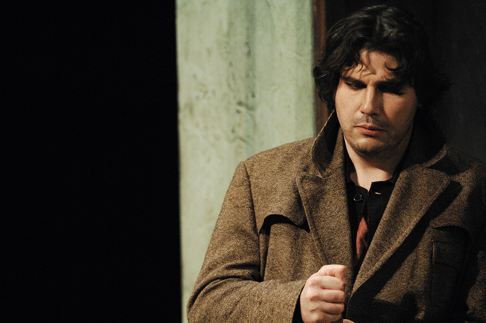 Massimo Cavalletti
Massimo Cavalletti
Massimo Cavalletti contributed a memorable Marcello, not only for the straight forward deployment of his rich and robust baritone, but also for his winning stage demeanor and personal investment in the emotional ‘money’ moments. Carlo Colombara proved to be another audience favorite for his soundly sung, unusually specific Colline, whose ‘Coat Aria’ was characterful and moving. Cheyne Davidson was the high-caliber Schaunard, rounding out the quartet with his solid singing easy stage deportment.
Eva Mei, who was to have sung the title part in Anna Bolena, did not face near the same challenges as Musetta, but the glamorous and gifted Ms. Mei threw herself into the proceedings with relish, and regaled us with some delightful sights and sounds. Making the most of every opportunity, she negotiated her creamy soprano through a wholly engaging “Quando m’en vo,” dominating Act Two as she must. Proving a wonderful collaborator, in later acts Eva ceded the focus to her colleagues all the while remaining dramatically engaged in a well-rounded, ‘human’ interpretation. Davide Fersini was an unusually youthful, opportunistic, and well sung Benoit; Giuseppe Scorsin provided the ‘glue’ needed to hold together Act Two as Alcindoro; and Carl Hieger was the secure Parpignol. Ernst Raffelsberger’s chorus sang cleanly and enthusiastically.
Ulrich Senn has re-mounted Philippe Sireuil’s direction with marvelous results. I have seldom seen characterizations and inter-relationships so richly detailed, so grounded in truth, so well-motivated, and so excitingly blocked. The by-play between Marcello and Rodolfo, for example established a loving, almost co-dependent relationship that was reinforced right up until the last moment, when Marcello tightly hugs and physically restrains Rodolfo from going to Mimi’s corpse. What a powerful moment! I never thought I could be moved to tears at the end of this chestnut, but there I was blubbering like Cher after her Met visit in “Moonstruck.” Mimi’s final moments were similarly well crafted, with her lying on her side, suggesting a fetal position. When her hand fell out of the muff she looked for all the world like a wounded bird who had fallen from a tree. There were so many creative touches that were so right, so fresh, so telling, that it would be impossible to discuss them all here. This kind of inspired specificity is what fine direction is about.
A very small quibble, though, which I hope future revivals might correct: the solo character placement in Act II needed focus, perhaps only so much as better lighting specials. Puccini paints a busy canvas in the Momus scene and the principals occasionally got lost in the bustle. But, even with that small consideration, this was a stunning achievement.
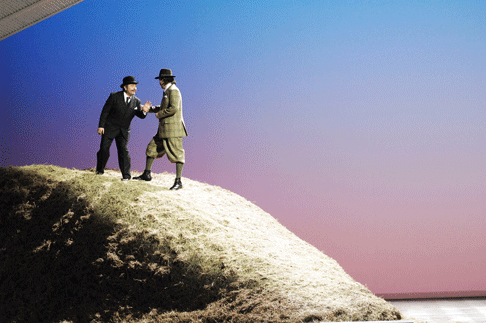 Javier Camarena and Massimo Cavaletti
Javier Camarena and Massimo Cavaletti
Maestro Massimo Zanetti paced the proceedings with infectious drive, infusing the performance with a freshness and spontaneity I did not think possible with this thrice-familiar opera. He also proved an amiable partner for his exceptional soloists, seeming to live the scenes with them, enabling moments of exceptional impact. The first rate pit responded with luminous playing throughout.
Would that conductor Daniele Gatti have been infected by such inspiration , for the next night’s Falstaff was not helped by his atypically detached musical leadership. Some of the great moments of Verdi’s final work scored their full effect, to be sure, but others, like the male and female quartets dueling in different meters hung together, but were not seamless. Ditto the “pizzica-stuzzica” ensemble which lacked the cleanliness it needs to sparkle. I have long admired Maestro Gatti, but this night he too often seemed distracted.
There was a lot to admire in the accomplished cast, however, not least of which were the Nanetta and Fenton of Eva Liebau and Javier Camarena. Ms. Liebau has the sort of youthful, crystal clear, shimmering soprano that is a perfect fit for Nanetta’s lyrical flights of fancy. The best tunes in the show are split between her and Mr. Camarena who regales us with a simply gorgeous, wide-ranging, dulcet tenor, effortlessly produced, that blossoms more the higher it goes. Massimo Cavalletti was back on stage with a potent, rafter-rattling turn as Ford; ditto Eva Mei with her well-sung and finely tuned characterization as a wilier-than-usual Alice Ford. The role of Mrs. Quickly suits Yvonne Naef to a tee, and she relished every phrase of it, putting her imposing lower middle and chest registers in over drive, and her wicked sense of fun on full alert. I have never heard Ms. Naef perform better. How utterly delightful it was for once to have a Meg Page that held her own with the other three (better-drawn) ladies’ roles. Judith Schmid was a determined foil and her sassy, ringing mezzo had fiery intent.
I wanted to like Anthony Michaels-Moore’s seasoned Falstaff more. He has certainly performed the role widely, he has the physique du role, and he has a charismatic presence. But the part seemed to be pitched about a third too low for the core of his resonant baritone, diminishing the impact of several key phrases. AM-M seemed game for anything and he was an assured, fleet-footed protagonist, although on occasion his attempts to make some cute on-stage moves came off a bit fey for such a womanizing lecher.
Peter Straka was a capable Dr. Cajus; the reliable Martin Zyssett an appropriately scruffy Bardolfo; and Davide Fersini gave us an unusually well-sung Pistola. Domeni Gloor was given more stage time than is common, and the young lad acquitted himself commendably.
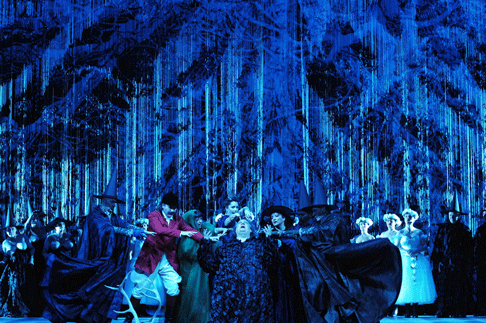 Scene from Falstaff
Scene from Falstaff
Set Designer Rolf Glittenberg provided a very handsome playing space, with solid side walls and vaulted ceiling creating a ‘house’ out of white louvered panels. The back wall had stylized, changeable open windows and doors that gave way to a floral wallpaper in Ford’s house and then in the forest scene, to a shimmering beaded curtain with a huge Herne’s Oak pattern in the bead work. Juergen Hoffmann devised a pretty straight forward light plot, but also came up with some wonderful fantasy effects for the forest scene. Marianne Glittenberg’s costumes were eye-catching if curious. Like some of the props and set dressing, the attire in the home was inspired by 1950’s fashions, while the Garter Inn scenes were inspired by Shakespearean times. Not unpleasing, and they were all character-specific, just…curious.
There were fewer oddities in Sven-Eric Bechtolf’s direction, and he managed the traffic well enough with straight forward blocking. But Bechtolf also miscued a couple of surefire moments like the kiss-behind-the-screen which was simply not heard, and the basket toss out the window which simply didn’t ‘read.’ Too, the double marriage was clumsily managed and visually implausible. In the end though, Zurich’s talented principals carried the day, supported by some intriguing design choices and an unobtrusive director, and Mr. Gatti rallied the assembled forces to a taut and compelling finale which sent at least this ‘fool’ out of the theatre with a smile on his face.
James Sohre
image=http://www.operatoday.com/ASC_0331.gif image_description=Jonas Kaufmann [Photo by Suzanne Schwiertz courtesy of Opernhaus Zürich] product=yes product_title=Giacomo Puccini: La BohèmeGiuseppe Verdi: Falstaff product_by=La Bohème — Mimi: Inva Mula; Musetta: Eva Mei; Rodolfo: Jonas Kaufmann; Marcello: Massimo Cavalletti; Schaunard: Cheyne Davidson; Colline: Carlo Colombara; Benoit: Davide Fersini; Alcindoro: Giuseppe Scorsin; Parpignol: Carl Hieger. Conductor: Massimo Zanetti. Director: Philippe Sireuil. Revival Director: Ulrich Senn. Set Design: Vincent Lemaire. Costume Design: Jorge Jara. Lighting Design: Hans-Rudolf Kunz. Chorus Master: Ernst Raffelsberger.
Falstaff — Sir John Falstaff: Anthony Michaels-Moore; Mrs. Alice Ford: Eva Mei; Ford: Massimo Cavalletti; Nannetta: Eva Liebau; Mrs. Quickly: Yvonne Naef; Mrs. Meg Page: Judith Schmid; Fenton: Javier Camarena; Dr. Cajus: Peter Straka; Bardolfo: Martin Zysset; Pistola: Davide Fersini; Page: Domeni Gloor. Conductor: Daniele Gatti. Director: Sven-Eric Bechtolf. Set Design: Rolf Glittenberg. Costume Design: Marianne Glittenberg. Lighting Design: Juergen Hoffmann. Chorus Master: Ernst Raffelsberger. product_id=Above: Jonas Kaufmann
All photos by Suzanne Schwiertz courtesy of Opernhaus Zürich
June 20, 2011
Geneva’s Juicy Oranges
You would do no better than to scurry to the Grand Theatre of Geneva where this first rate ensemble is producing a snazzy, energetic, in-your-face production of Prokofiev’s The Love for Three Oranges. Just like the opera’s hapless Prince we all could use a therapeutic laugh, and this the Swiss company decidedly delivers.
Although it is billed as a “co-production” with Deutsche Oper am Rhein and La Fenice, in truth, the physical design is so definitively reproductive of the Venice Theatre’s architectural elements that is is hard to consider this re-mounting as more than a “rental.” Consider this: the massive masking “legs” stage right and left are photographic copies of the boxes in La Fenice, clearly meant to “extend” that ‘teatro’s’ structure onto the stage. Too, the ‘stage-within-a-stage’ up center has a replica of the Fenice grand drape, and the stucco elements in the backdrop are derived from those in the Italian house. While it does not wholly matter, it does seem to stifle any of the ‘local’ resonance that was clearly intended.
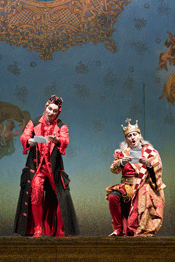 Heikki Kilpeläinen and Jean Teitgen as the King
Heikki Kilpeläinen and Jean Teitgen as the King
That said, Ezio Toffolutti’s scenery functioned well, was handsome to look at, and contributed a smooth-moving parade of inventive visual delights required by the libretto. I did wish that the “stage” had not been so far upstage as it served to distance us visually, if not aurally, from the two-thirds of the action that was played there. There was just that big empty expanse of prime “real” stage area unused for much of the time. Maybe shuttering the lighting to more tightly encompass the false stage might have focused the action more and edited the dead space out, although I found Volker Weinhart’s varied lighting design quite well-judged, with good area isolation, effective specials, smooth cross-fades and on the whole, very tightly cued.
Patricia Toffolutti’s fashion parade of meaty, varied, multi-faceted costumes (a ‘char-couture-y’?) provided constant colorful delight. Moreover, her creations were character-specific, greatly helping the actors in embodying their (largely) stock characters. The stage direction by Benno Besson and Ezio Toffolutti managed the large crowd scenes well enough, although the traffic patterns became repetitive. The pair seemed less interested in directorial distinction in the more personal scenes where they contented themselves with getting characters on and offstage with ease and pace. Power loves a vacuum, and absent a scintillating directorial hand, the cast filled in the dramatic blanks with savvy and imagination.
The hardest-working cast member had to be Emilio Pons, whose Truffaldino was not only a master of invention, but also was exceedingly well sung. Mr. Pons is almost never still as he leaps, kicks his heels, spins, cowers, beseeches, minces, and prances with more infectious energy than a Billy Blanks Tae-Bo session. His fearless, manic, even demented, cavorting during the playing of the famous March was a scintillating high point. Too, Emilio deployed his secure lyric tenor to fine effect, pouring out secure, arching phrases on demand, and ‘speechifying’ with good purpose, presence and diction on the many parlando passages. A definitive impersonation from this talented young tenor.
Chad Shelton gave us first a sympathetic and, later, a self-assured Prince. Mr. Shelton has just a hint of a ‘bite’ in his well-schooled tenor which stood him in good stead as the phrases got higher-flying and the instrumental density ratcheted up. His tireless, solid upper extension recalled the young Chris Merritt, and his command of the stage is already even better. On the distaff side, it was a distinct pleasure for me to encounter anew the (apparently) ageless mezzo of Jeanne Piland. I first took notice of Ms. Piland at New York City Opera as Orisini and Smeton in the year…well…we were all younger then. I caught up with her a few years ago as a riveting Sara in Munich’s Roberto Devereux. And here she was again engaging us with a real star turn as Fata Morgana, her rich, plummy voice in fine estate and skillfully deployed; still treading the boards as if born to the stage; still glamorous and vibrant. This was luxury casting and the opening nighters responded enthusiastically.
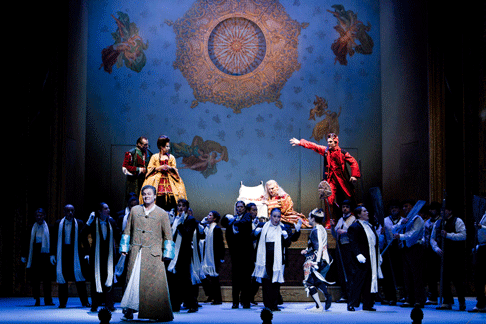 Chad Shelton as the Prince, Katherine Rohrer as Princess Clarisse, Nicolas Testé as Leandro and Michail Milanov as Tchelio
Chad Shelton as the Prince, Katherine Rohrer as Princess Clarisse, Nicolas Testé as Leandro and Michail Milanov as Tchelio
Jean Teitgen was a positively splendid King of Clubs. His rich, mature bass rolled out line after line of imposing phrases. And Mr. Teitgen devised an exceptionally well-rounded characterization, one moment amusing us as the exasperated buffoon-royal, and the next truly breaking our hearts after his son slaps him — a moment every bit as genuine and touching as the Pasquale equivalent.
Katherine Rohrer (Princess Clarice) and Nicolas Testé (Leandro) sang with solid panache, and prowled the environment with suitable relish of their evil intent. Smeraldina was as over-the-top and vibrant as her co-conspirators, but Carine Séchaye’s sizable mezzo-soprano, when pressed at forte, was occasionally marred by an overly generous vibrato that resulted in approximation of pitches above the staff. Heikki Kilpeläinen was a reliable Pantalone, Thomas Dear stood out with his virile baritone and committed stage action as Farfarello, and Christopher Stamboglis made a strong impression as the Cook. Some artists would be content to let the drag costume do all the work, but Mr. Stamboglis not only sang the role beautifully with a soft grained, weighty bass, but also imbued the part with considerable sensitivity.
The Princesses Linette, Nicolette and Ninette are usually as individual as Huey, Dewey and Louie. Here however, there was good distinction offered by three young sopranos: Susanne Gritschneder with her limpid, lyric Linette; Agnieszka Adamczak with a slightly darker, urgent Nicolette; and Clémence Tilquin in the more extended role of Linette. Ms. Tilquin was just lovely — slim as a ballerina, but with a sizable soprano with a hint of metal that sailed over the orchestra and proved a good partner to Mr. Shelton’s pointed tenor.
The seasoned bass Michail Milanov may not be producing the most fresh-voiced or roundly sung performance of the evening. But, damn if his demonstrative Tchelio didn’t score every point as he brought his years of experience to bear, husbanding his resources to make the most of every dramatic statement. The Geneva public lavished Mr. Milanov with a warmly appreciative ovation for his efforts.
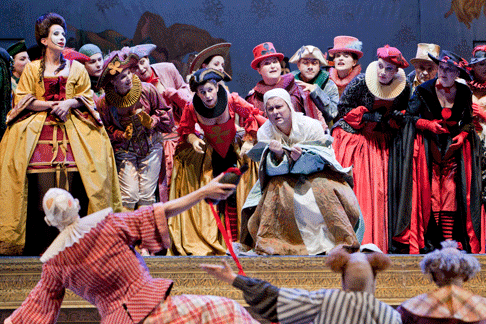 Chad Shelton as the Prince and Katherine Rohrer as Princess Clarisse
Chad Shelton as the Prince and Katherine Rohrer as Princess Clarisse
Arguably the star of the evening was conductor Michail Jurowski. Never have I heard such fire in this score tempered by such nuance. Maestro Jurowski not only had all the angular, rhythmic flash and dazzle abundantly in place, but he also lovingly inspired contrasting moments of transparency, tenderness, and mellow rumination. This was as deeply felt, stylistically impeccable, personalized and persuasive a reading as you might be lucky enough to encounter once every ten years. The Maestro was ably abetted by Ching-Lien Wu’s meticulously prepared chorus.
James Sohre
image=http://www.operatoday.com/Three_oranges_Geneva_03.gif image_description=Chad Shelton as the Prince, Katherine Rohrer as Princess Clarisse and Nicolas Testé as Leandro [Photo by Yunus Durukan courtesy of Grand Théâtre de Genève] product=yes product_title=Sergei Prokofiev: The Love for Three Oranges, Op. 33 product_by=The King of Clubs: Jean Teitgen; Prince: Chad Shelton; Princess Clarisse: Katherine Rohrer; Leandro: Nicolas Testé; Truffaldino: Emilio Pons; Pantalone: Heikki Kilpeläinen; Tchelio: Michail Milanov; Fata Morgana: Jeanne Piland; Princess Linette: Susanne Gritschneder; Princess Nicolette: Agnieszka Adamczak; Princess Ninette: Clémence Tilquin; Cook: Christophoros Stamboglis; Farfarello: Thomas Dear; Smeraldina: Carine Séchaye; Master of Ceremonies: Fabrice Farina; Herald: Jérémie Brocard. Conductor: Michail Jurowski. Directors: Benno Besson and Ezio Toffolutti. Choreography: Maria Cristina Madau. Set Design: Ezio Toffolutti. Costume Design: Patricia Toffolutti. Lighting Design: Volker Weinhart. Chorus Master: Ching-Lien Wu. product_id=Above: Chad Shelton as the Prince, Katherine Rohrer as Princess Clarisse and Nicolas Testé as LeandroAll photos by Yunus Durukan courtesy of Grand Théâtre de Genève
Boston Early Music Festival: Niobe, Regina di Tebe
From a specialty occasion, a meeting of minds and interests and instruments for a week every two years, its classes and performances culminating in the sometimes casual staging of a forgotten opera from an obscure corner of the repertory, cast with singers soon to become Early Music A-listers (Suzie LeBlanc, Karina Gauvin), it has become a major event on the international calendar, the most important Early Music festival in North America, a riot of concerts and classes and displays with a healthy fringe to boot. The operas are now elegant spectacles starring singers already on the international A-list (Philippe Jaroussky). This year, the opera given five performances at the colorfully restored Cutler Majestic Theater in Boston plus two more in Great Barrington is Agostino Steffani’s Niobe, Regina di Tebe, a work premiered in Munich in 1688. As the rare performances of Steffani’s operas always do, Niobe left audiences wondering how they had missed so accomplished and appealing a composer, and eager for further acquaintance with his oeuvre.
Steffani (1654-1728), though born in the Veneto, spent most of his composing career at German princely courts. He specialized in vocal music—though ballets are important in his operas, he usually subcontracted their composition. He was also a diplomat and possibly a secret agent of the Vatican during a tricky time in Central European politics. After retiring from his secular careers, he became a bishop and a high papal official, but holy orders had no effect on the worldliness of his opera plots. Famous in his day for operas, church music and for chamber compositions for vocal amateurs, his music was soon forgotten, a fate that also befell the operas of such even more famous contemporaries as Handel (a sometime protégé) and Alessandro Scarlatti. Today, a dozen masters (and many minors) of these eras are just what the opera audience craves: Operas of Cavalli, Lully, Conradi, Caldara, Vivaldi and Hasse are revived everywhere. Steffani belongs on that list; thus BEMF has gotten around to him.
BEMF’s Niobe is billed as the "North American stage premiere" of the opera (or, possibly, any Steffani opera), for those who recall the concert performance of Niobe at Alice Tully Hall in 1977 by the Clarion Society. Clarion also presented Steffani's Tassilone, and what I remember from those concerts is how impressed I was with the melodious scores, how we were all knocked over by their quality, how certain that these performances would lead to a Steffani revival. They did not. Cavalli and Handel and Rameau and Charpentier intruded, and today they can be heard in every musical capital and festival. Perhaps it is Steffani’s turn at last—the BEMF Niobe follows acclaimed recent productions at Schwetzingen, Luxembourg and Covent Garden,. One hopes that BEMF, as it has done prize-winningly in the past, will record this superb performance.
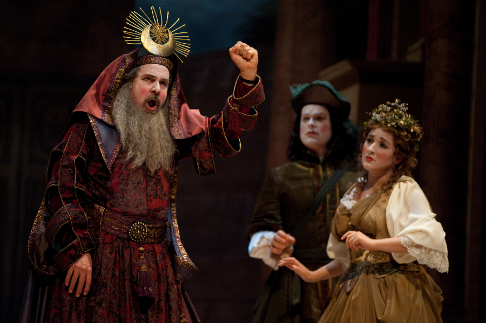 Charles Robert Stephens, Colin Balzer, and Yulia Van Doren
Charles Robert Stephens, Colin Balzer, and Yulia Van Doren
A DVD would be an even happier idea, considering the production’s color and grandeur, but is probably beyond the resources of the festival. BEMF has given Niobe the splendor and special effects worthy of a proud ducal court under the influence of Louis XIV’s Paris: On the small but deep stage of the Cutler Majestic, we behold the glittering marble metropolis of ancient Thebes; the perilous Claude Lorrain-ish woods that surround it, which are haunted by fierce (dancing) bears, chariots drawn by winged dragons, coy shepherdesses and other wild life; a sacred fane of the goddess Latona; a magical paradise to which Mars (actually the disguised Creonte) transports the bewitched Niobe for purposes of—oh, let's keep it clean. (He succeeds, but during an intermission.) Much influenced by the operas of Lully, Steffani included many ballets in his works, and these were choreographed stylishly and in the proper period. The special effects that have always been essential to grand opera include Anfione singing to raise, magically, the walls and gates of endangered Thebes. This was surprisingly and elegantly brought off, accompanying Jaroussky’s exquisite invocation, and so made perfect dramatic and musical sense. The designers of the Met’s Ring should observe this scene to learn how mythic events can be staged without forfeiting musical and emotional power. (Gilbert Blin was the director and scenery designer. He often made do with painted flats—old technology you might say—but the painting was sumptuous, and flats made earthquakes easier to dramatize.)
In Greek mythology, Niobe was the lady who boasted of her scads of children and was duly punished by losing them and turning to stone, a myth that (I’ve always supposed) referred to the loss of innumerable youths to every passing germ in the pre-Pasteur era. Her husband, Amphion, was regarded as second only to Orpheus as a singer and player of the lyre, famed for raising the walls of Thebes by song (euhemerized as playing lively work songs to encourage the builders). That is, besides begetting Niobe’s twelve (or fourteen or however many) children, his major mythological accomplishment. In Steffani’s version, Niobe has a wandering eye most unsuitable to a matron, and Anfione, besides raising the walls with his singing, is of a philosophical turn of mind, inclined to retire from power to his deep meditations. This leads to a wonderful aria about the music of the spheres, illustrated in Boston by having his seven children circle him bearing globes of differing sizes. Jaroussky, tall, slim, handsome and bewigged like Louis XIV, sang all this movingly in his pure countertenor, none the less exciting for his prevailing calm. His style of ornament hewed scrupulously to the earlier, French style rather than the rapid divisions he performs in Handel’s operas, lingering to express “tormenti,” weeping his “pianti,” and at last (having stabbed himself) dying on a delicious fading melisma.
Amanda Forsythe, a Boston local favorite, sang Niobe. She has a dignified mien and a lovely soprano, great sensitivity to text and its tasteful ornamentation: She drew out the agonies of her “pena” (pain) in a most affecting way, and she turned convincingly to stone in the final moments of the opera. Most of the role presents her as a haughty, not to say shrewish, queen, wife and mother or a sarcastic lover, but Forsythe’s finest moment was her sensual aria of awakening in (she imagines) the arms of a god at the opening of Act III, when her lyrical runs expressed happily sated eroticism. A little later, though, humiliated at her deception, she sang an aria threatening the very gods—who punished her in due course. This revealed Forsythe’s greatest defect: Her instrument is too small for heroic outcries. Wisely, she does not force it past its natural limits, but one misses a dimension in her arias of rage. Happily, she has found her niche in Early Music, which will not often demand that she fill large halls with stormy sound; she sang Manto successfully in the London Niobe. In Boston, this secondary soprano role, a priestess in the throes of first love, hence not forced to quite such hysterical extremes of emotion as is the mobled queen, was taken by Yulia Van Doren, who won my heart with her silvery, bell-like tones, whether delighting or sorrowing or sighing. I hope to hear more of her.
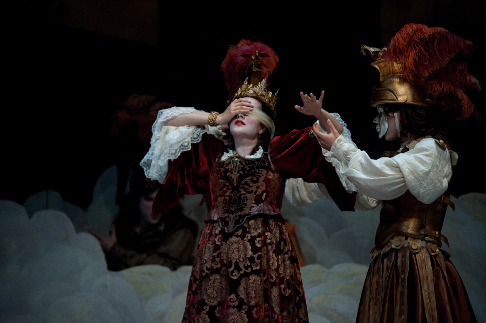 Amanda Forsythe and cast
Amanda Forsythe and cast
Colin Balzer sang Manto’s lover, Tiburino, with a most agreeable and flexible tenor. Charles Robert Stephens sang her father, the legendary know-it-all Tiresia, with pleasing resonance but little oracular command. Countertenor Matthew White made a serenely delicious Creonte. Jesse Blumberg sang wicked Poliferno with a likeable light bass but inaudible low notes. José Lemos, a contralto countertenor dressed like a baroque Katisha with stalks in his hair-do and a lewdly fluttering fan, had the stock role of the wicked old nurse played in drag, who utters cynical morals to undercut everyone else’s high-flown sentiments. His voice can be beautiful, but Nerea mostly calls for comic commentary, which he generally indicated with gravelly low notes or squawky high ones.
An array of baroque strings and winds (including recorders) spread out below the stage to the right-hand corner, where BEMF’s directors, Paul O’Dette on baroque guitar and Stephen Stubbs on some sort of keyboard, directed things, with harp, theorbo and viola da gamba joining them as continuo for the recits. This was all very pleasing except when valveless trumpets and trombones scattered about the auditorium joined the overture: Either they were playing raggedly or Steffani’s harmonies were mighty advanced. The bits of the London Niobe available on youtube suggest more effective timpani and a more modern symphonic sound there, which may have been necessary to present the work to a grand opera audience, but for Early Music fans and a smaller theater, the BEMF forces were sufficient and elegant.
Besides Gilbert Blin’s magnificent sets and Anna Watkins’ plushy costumes and the stiff but versatile PALS Children’s Chorus, who supplied and presumably trained Niobe’s enormous brood of doomed children, major credit for the evening’s splendor must be accorded to choreographers Caroline Copeland and Carlos Fittante, who designed pastorals, hunts, revels and flirtations to make the point that, at the French-influenced Munich court of Elector Max Emmanuel, dance interludes between stretches of singing were an important part of an evening’s musical entertainment.
John Yohalem
image=http://www.operatoday.com/Niobe_01.png image_description=Philippe Jaroussky [Photo by André Costantini courtesy of Boston Early Music Festival] product=yes product_title=Agostino Steffani: Niobe, Regina di Tebe product_by=Niobe: Amanda Forsythe; Anfione: Philippe Jaroussky; Manto: Yulia Van Doren; Clearte: Kevin D. Skelton; Tiresia: Charles Robert Stephens; Creonte: Matthew White; Poliferno: Jesse Blumberg; Tiberino: Colin Balzer; Nerea: José Lemos. The Boston Early Music Festival Orchestra and Dance Ensemble, conducted by Paul O’Dette and Stephen Stubbs. At the Cutler Majestic Theatre at Emerson College. Performance of June 14. product_id=Above: Philippe JarousskyAll photos by André Costantini courtesy of Boston Early Music Festival
Don Pasquale, Opera Holland Park
Opera festivals — indeed, all outdoor or semi-outdoor activities — in the UK are in thrall to the vagaries of the weather, and as I write this review in early June I am sitting in my living-room, listening to the rain battering on the window and hoping it might clear up by the time I have to go to Glyndebourne in two days’ time.
For Opera Holland Park, whose theatre is ultimately a tent (albeit a highly sophisticated one) in which the sounds and light quality of the outside world are an inevitable part of the show, director Stephen Barlow has harnessed the characteristic changeable gloom of the British summer to create a modern and very British Don Pasquale that will resonate with anybody used to taking seaside holidays in this country. It is an ingenious treatment, finely honed by the work of lighting designer Mark Jonathan, which I cannot imagine would work as well in any other theatre. It almost made a virtue of the frequent noises-off from aeroplanes passing overheard and children playing elsewhere in the park.
The opera is sung in the original Italian, and Pasquale’s drab, tatty beach café is arbitrarily Italian (in the surtitles, Pasquale refers to it throughout as his ‘casa’). Its menu, however, consists of fish and chips or pie and mash, and there is no question that we are on the British coast — a world of striped awnings, deckchairs for hire, pensioners picnicking on benches with home-made sandwiches and a Thermos. Crucially, it’s the world of another phenomenon with its roots in Italian culture but adopted by the British as their own — the end-of-pier Punch and Judy show, an idea which, while never overtly suggested, Barlow recreates in spirit with a staging which served this peculiarly mean-spirited opera well with a combination of broad visual comedy and vicious humour.
None of the characters in Don Pasquale are obviously sympathetic. Even Ernesto, for all he’s been given the best of Donizetti’s lyrical melody to in which to bewail his uncle’s attempt to disinherit him, is ultimately a lazy freeloader who has grown too used to taking advantage of his old uncle’s generosity. While Pasquale is unquestionably in need of being taught a lesson in respect of his view of women, the bullying he suffers at the hands of everybody else in the cast goes much too far and you can’t help but feel sorry for the old man. It’s cynical, cruel and unashamedly selfish.
The visual humour was plentiful, with some laugh-out-loud moments. The fresh-from-the-convent “Sofronia” whipped off a full nun’s habit to reveal a sexy scarlet number, and in Act 3 was “revealed” in a more grotesquely extravagant get-up still, draped across the counter of her newly refurbished “Café Corneti” like a swimwear model across the bonnet of a sports car.
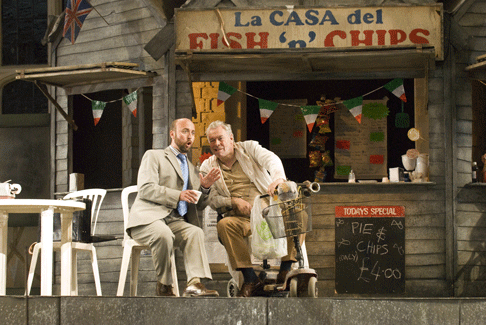 Donald Maxwell as Don Pasquale and Richard Burkhard as Dr Malatesta
Donald Maxwell as Don Pasquale and Richard Burkhard as Dr Malatesta
Meanwhile, a series of peripheral gags involving walk-on characters from the chorus further highlighted the general tone of the production. Don Pasquale’s outdated attitudes are underlined by his gleefully lascivious reaction to the sight of two scantily-clad young lady joggers, and disapproving glances towards a male gay couple with a baby (they are later revealed not to be a couple at all, but the partners of the joggers). Meanwhile, a casual user of a coin-operated telescope on the seafront has his gaze distracted by the sight of the snazzily-attired Norina provocatively applying sun lotion to her décolleté, much to the annoyance of his long-suffering pregnant wife.
Top vocal honours went to the Ernesto, the South African tenor Colin Lee who is now deservedly enjoying a high-profile international career. He has a personable stage presence, and a voice at the more substantially rounded end of the flexible bel canto tenor spectrum, with bright liquid tone which pings right to the back of the auditorium. In the title role, opera buffa veteran Donald Maxwell was highly entertaining when the action demanded, but on the whole he was more sympathetic and genuine than most, offering a rare degree of balance. Richard Burkhard’s Malatesta had a well-schooled voice and engaging personality.
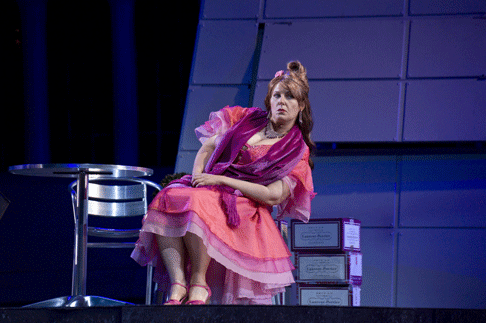 Majella Cullagh as Norina
Majella Cullagh as Norina
I have admired Majella Cullagh in numerous Donizetti roles in the past, but sadly felt that she was miscast as Norina; her light, vinegary soprano did open up somewhat as the evening progressed, but she remained overpowered by her colleagues during the ensembles. And as spirited and entertaining as her performance was, she made rather a matronly heroine — believable perhaps as the scheming merry widow (there’s no reason at all why Ernesto’s lover shouldn’t be somewhat older than him), but hardly convincing as the nubile young bride who the lecherous Pasquale believes is the embodiment of his fantasies.
In the pit was bel canto’s supreme champion, Richard Bonynge, looking spry and conducting with poised lyricism.
All in all a strong, entertaining and memorable opening to Opera Holland Park’s 2011 season, and one which turns this unique theatre’s many idiosyncrasies to its advantage. One of next year’s operas is Falstaff, which has immense potential in a theatre which loses natural daylight as the performance progresses; let us hope the director makes the most of it.
Ruth Elleson © 2011
image=http://www.operatoday.com/Don-P_0016_lzn.gif image_description=Donald Maxwell as Don Pasquale [Photo by Fritz Curzon courtesy of Opera Holland Park] product=yes product_title=Gaetano Donizetti: Don Pasquale product_by=Don Pasquale: Donald Maxwell; Doctor Malatesta: Richard Burkhard; Ernesto: Colin Lee; Norina: Majella Cullagh; A Notary: Simon Wilding. Chorus and Orchestra of Opera Holland Park. Conductor: Richard Bonynge. Director: Stephen Barlow. Designer: Colin Richmond. Lighting designer: Mark Jonathan. Choreographer: Ewan Jones. product_id=Above: Donald Maxwell as Don PasqualeAll photos by Fritz Curzon courtesy of Opera Holland Park
June 17, 2011
Jeremy White and the British character singer tradition
“We’re not mobile scenery,” says White. “We’re part of what makes opera theatre.” Composers write character parts for a reason. Often they’re pivotal to the drama, even if they don’t involve long stretches of singing. The Sacristan in Tosca, for example, is level headed and sensible, a counterfoil to Tosca’s wild extremes and to Scarpia’s devious cunning. White will appear in the forthcoming film of Puccini’s Tosca, to be released at HD cinemas from September 2011.
When White started singing at the Royal Opera House in the 1990-91 season, he used to study his great predecessors like John Dobson and Philip Langridge, tenors, and Eric Garrett, like White a bass baritone, who created 70 roles over 40 years. "They were men of the theatre", says White. “The moment they walked on stage you knew exactly who their character was, and what their backstory might be. They might have only 30 seconds, or maybe two minutes, but they could instantly establish the presence of a personality.” White mentions an early production of Mozart The Marriage of Figaro. Count Almaviva was seen at an ornate inlaid chess table, plotting his stratagems. Garrett rushed in with Cherubino’s hat, misread Almaviva’s gestures and knocked every chess piece to the ground. “All this in a few seconds, but impeccable timing…. I watched as many of his performances as I could.”
White has inherited the tradition, for his repertoire ranges from early polyphony through to contemporary opera. Recently he sang Daddy Hogan in Mark Anthony Turnage’s Anna Nicole. He was so good he was barely recognizable as the same man who sang Dansker in Britten’s Billy Budd at Glyndebourne last year, or Reinmar von Zweter in Tannhäuser at the Royal Opera House in December, or, indeed, the genial Sacristan in Tosca two days before we met. That’s a sign of a really good character singer: he seems to become whatever part he does.
“Until last week, I was singing five roles,” says White. “This week, only three.” But these are the Sacristan in Tosca, the Bonze in Madama Butterfly and Le Roi in Massenet Cendrillon.
“The part of the Bonze,” he says, “lasts only one minute and forty seconds, of which 25 seconds happen off stage. It takes forty minutes to get the makeup and costume on and then I have to rush on. The music’s as wild as Hell’s Kitchen, the Bonze is yelling. It can be a panic, as the music is extremely difficult and you can’t see the conductor. Then you go off and you think, was that alright? And you know you need another half an hour just to get the makeup off.” Short as the part is, it’s crucial, for the Bonze’s curse severs Cio Cio San's links to her own society, so when her hopes are dashed, she sees only a violent end. There’s much beauty in this opera, but the Bonze’s savage outburst reminds us that there are much darker undertones.
A week after Madama Butterfly opens, Cendrillon begins. Rehearsals overlap. “One day I’m singing a homicidal maniac and the next it’s all looney tunes.” This is the premiere of the first production of Cendrillon at the Royal Opera House. ”I hope I’m not giving anything away too early,” he says, “but it’s absolutely hilarious! Cartoon acting, and so much fun. It keeps you on the go.”
“Character singing is a whole different ball game to ordinary singing,” White adds. “ Completely different values. You have only a few moments in which to make maximum impact. No comparison with singing an aria in a concert hall. You’re responding to musical cues, and to what’s happening elsewhere on stage. What’s on the page is forgotten once you’re fully into the role and singing.”That fluency comes from a solid foundation in the craft of singing. “Young singers’ heads are often full of magic, but the main thing is to really learn your craft, so thoroughly it becomes instinct. Ballerinas do their barres, visual artists draw. If you don’t keep on form, you get rusty.”
White takes out a notebook and shows how he prepares. He copies his part out by hand and makes notes. “The very act of writing out helps to fix things in my mind. Sometimes when I’m singing a part like Ramfis or Selim in Il Turco, the notebooks get pretty fat, but I can carry them around and have them on hand whenever I need. It saves a lot of heartbreak, because if you put in the hours behind the scenes you internalize the part. Everyone gets moments when they get fuzzy, but if you’ve absorbed the part properly, it flows. When you become the part, then you can go for that extra X factor!”
“In live music what you want is more than generalized loveliness, you need to communicate. You have to address the text or you’re not even in the position the composer was before he started writing. So think about meaning. When I started singing, I sang a lot of Handel. There are many exquisite passages which a true personality can inhabit. It made my blood boil that it was once fashionable to bleach things out so they didn’t sound human. In Handel’s time people went to the opera to get excited. Fights broke out, people used to eat meals and dally with their lady friends.”
White started singing as a choirboy in Liverpool Cathedral, but took his first stage role aged only 7, as the second witch in Dido and Aeneas. At 11, he sang Josephine in HMS Pinafore. “I was a Heldentreble then. I screamed.” Later he won a choral scholarship to Oxford, where he read first at Queen’s, then at Christ Church. He moved to Guildford, one of the active centres in British choral music, and was a founder member of the Tallis Scholars and member of The Sixteen. Then one day a friend phoned about a vacancy with the BBC Singers. He had a young family by then, but it was too good an opportunity to miss.
The BBC Singers are renowned for their versatility. They sing everything, from medieval polyphony to the avant garde. They’re formidable sight readers. White learned Brian Ferneyhough’s Transit, for six singers and very large orchestra. “In the bass part there was one bar under four brackets, then a triplet bracket, and underneath throughout, a slow rhythmic beat. We got out calculators to work out how to sing it.” With such a foundation, a singer can find work anywhere. Although White’s love for fully staged opera won out, he stills sings Requiems, Mahler, recitals and concert performances and of course Bach and Handel. It keeps his voice in good singing form, and makes a change from stage work.
In his long career, White has worked with many different directors and conductors. “When I started at the Royal Opera House, Bernard Haitink was conductor. He had an extraordinary ability of bringing out the best in everybody just by being there, even without saying a word. Everyone felt valued and it channeled through Haitink.”
“Tony Pappano has a huge range and is so dynamic. He always talks about finding the energy that replenishes itself. When you get into a voice in the right way, it’s like riding a magic carpet, you never tire.”
White enthuses about singing Wagner. Recently he sang a concert Das Rheingold and realized how comfortable he felt. He’s done Die Meistersinger many times in different roles. Sachs, after all, is the ultimate character part. “A Wagnerian is more likely to complain about their legs being tired from standing on a rake than their voice being tired. Lighter stuff can wear you out because it’s like always being en pointe, but in Wagner, once you get into the phrases, it’s liberating, like swimming, and you can become the part.” Besides singing at the Royal Opera House, White also appears at Glyndebourne, at the ENO, at Opera North and in European companies like De Nederlandse Opera and Bregenz. A good character singer makes a lot of difference.
Anne Ozorio
image=http://www.operatoday.com/TOSCA.2484ashm_0130.gif
image_description=(Front to Back) Jeremy White as Sacristan and Juha Uusitalo as Scarpia [Photo by Catherine Ashmore courtesy of Royal Opera House]
product=yes
product_title=Jeremy White and the British character singer tradition
product_by=By Anne Ozorio
product_id=Above: (Front to Back) Jeremy White as Sacristan and Juha Uusitalo as Scarpia [Photo by Catherine Ashmore courtesy of Royal Opera House]
June 16, 2011
Wagner’s Rienzi in Berlin
With such large operas — in duration, cast, theme, and more — the viewer is best prepared to enjoy any production by foregoing Apollonian expectations. Wagner held himself to very high standards, of course, and one early victim of his search for perfect artistic self-expression was his opera Rienzi — Last of the Tribunes. Created around the same time as The Flying Dutchman, Wagner decided later that Rienzi fell into his early growth period, while Dutchman marked the beginnings of his artistic maturity. So Rienzi was banned from the Bayreuth canon, and indeed the opera has seldom been staged elsewhere, although there are some historic recordings available. What has kept the opera’s title alive is the popularity of its overture in performance and on classical music radio stations. The stirring nobility of the main theme and then the energetic propulsion of the middle section must have led many a listener to be curious about what the opera would be like, seen staged.
An answer — if partial — can be found in the ArtHaus DVD of a 2010 Deutsche Oper Berlin performance, directed by Philip Stötzl. Wagnerian perfectionists face two daunting challenges in enjoying the best of this staging: first, the radically edited version of the score created as the basis of this performance, and second, Stötzl’s decision to forego the setting and even tone of Wagner’s libretto for the sort of modern theatrical interpretation often described, not to say derided, as “regie.”
Set in 14th century Rome, Wagner’s original libretto had a sprawling cast of characters engaging in multiple subplots, but Stötzl cut away everything except the central story of the Roman tribune Rienzi, who becomes a hero to the people when, with the backing of the Church, he faces down a civil revolt. Somewhat reluctantly, he agrees to take leadership and find a final resolution to the conflict. A key member of one of the opposing factions, Adriano, falls in love with Rienzi’s devoted sister, Irene. Adriano pledges support to Rienzi, but other members of the rebelling factions attempt an assassination. Rienzi survives, but then he becomes as autocratic and oppressive as those he sought to subdue. Ultimately, civil war breaks out again, and Rienzi is killed, along with his sister Irene, who chooses her brother over Adriano, leaving the young man bereft.
That much of the story Stötzl communicates very clearly, but he does it through the iconic images of the Third Reich (although there is no specific Hitler parallel in Rienzi’s appearance). Under the overture, a gymnast in a fat military suit cavorts around a huge desk, a homage to Charlie Chaplin in The Great Dictator playing with a globe-shaped balloon. In his white suit and pulled back hair, Torsten Kerl as Rienzi has a quasi-Mussolini affect, but even from the beginning he seems unstable and unreliable as a force for bringing others together. His dissolution carries no tragic force, therefore, but tragedy is not Stötzl’s aim. The best of the score is known through that famous overture; otherwise, this is indeed early Wagner, the anarchic master locked into the rigid forms of a Meyerbeerian grand spectacle. Stötzl’s menacing yet comical tone turns out to be an effective gambit. And Kerl deserves a lot of credit, singing out with sustained power and thrust, but also fully invested in the production’s atmosphere. Kerl rivets the attention, even if the character often repels it.
In appearance Camilla Nylund is almost too spot-on as Irene — tall, attractive and blonde, Nylund embodies what might have once been called a vision of feminine Aryan beauty. She also physically overwhelms Kate Aldrich in the pants-role of Adriano, but Nylund doesn’t supplant Aldrich as a vocalist. Aldrich sings with great precision and passion, in a type of role that Wagner would never attempt again. While effective, Nylund lacks any special character to her soprano.
Conductor Sebastian Lang-Lessing doesn’t allow any of the score’s many edits to disrupt a potent, melodic flow. And for once a disc’s “special feature” is truly special — a 20-minute “making of” documentary that actually has interesting interviews and rehearsal glimpses that give a good sense of how a complex staging such as this comes together. Look for the moment when Nylund asks Stötzl why Irene doesn’t approach Rienzi when her libretto line states she is coming to his side, and a momentarily exasperated Stötzl points out that the production is far from literal. Whether one sympathizes with the singer’s inquiry or the director’s response, the exchange shows the kind of involvement of all parties that resulted in this unusual and frequently exciting production. Recommended.
Chris Mullins
image=http://www.operatoday.com/ArtHaus101522.gif
image_description=Richard Wagner: Rienzi — Der Letzte der Tribunen
product=yes
product_title=Richard Wagner: Rienzi — Der Letzte der Tribunen
product_by=Rienzi: Torsten Kerl; Irene: Camilla Nylund; Steffano Colonna: Ante Jerkunica; Adriano: Kate Aldrich; Paolo Orsini: Krzysztof Szumanski; Cardinal Orvieto: Lenus Carlson; Baroncelli: Clemens Bieber; Cecco del Vecchio: Stephen Bronk. Berlin Deutsche Opera Chorus and Orchestra (chorus master: William Spaulding). Sebastian Lang-Lessing, conductor. Philipp Stölzl, stage director and set design. Ulrike Siegrist, set design. Kathi Maurer and Ursula Kudrna, costume design. Recorded live from the Deutsche Oper Berlin, 2010.
product_id=ArtHaus Musik 101521 [2DVDs] | 101522 [Blu-Ray]
price=$39.99
product_url=http://www.arkivmusic.com/classical/album.jsp?album_id=513473
Jane Henschel — An Interview
There is scarcely a major international opera house at which Henschel has not delighted and astonished audiences; and, she’s been a regular performer at festivals including Edinburgh, Glyndebourne and Salzburg. Her repertoire encompasses practically all the significant mezzo roles by Verdi, Wagner and Strauss, plus Puccini, Janáček, Bartok, Stravinsky, Schoenberg, Weill, Henze, even Bizet and Berlioz. Moreover, Henschel has regularly appeared on the concert platform, in works such as Mahler’s Eighth Symphony and Das Lied von der Erde. Critics repeatedly admire her powerful, clear singing and the magnificent warmth of her voice, as well as her attention to dramatic detail.
I meet Henschel during rehearsals for the revival of Willy Decker’s production of Peter Grimes at the Royal Opera House, Covent Garden, where she is to perform the role of Mrs Sedley. She has previously appeared in Britten’s tense, tragic opera about the tortured and alienated fisherman, taking the role of Auntie (in Salzburg and Dusseldorf), but this is the first time she has played the eerie laudanum addict who is such a sinister and persuasive force within the Borough community. I point out to Henschel that she seems to be making a habit of playing, ‘the baddie’ — having recently performed Janáček’s steely matriarchs, Kostelnička and Kabanicha, and Strauss’s femme fatale Clytemnestra. Henschel laughs:
“It’s one of the advantages of being dramatic mezzo rather than a dramatic lyric soprano; I love getting my teeth into these roles, taking an audience by surprise … and I really enjoy playing ‘nasty’ sometimes!”
Indeed, earlier this year her imposing impersonation of the Witch in Hansel and Gretel at the ROH won many accolades: “Henschel was a Witch of heroic Wagnerian calibre” but she was no “mere caricature” and the performance was “all the more malicious for presenting a properly sung portrayal”. She instinctively appreciates and integrates the way music and text cohere to create meaning, producing convincing drama of deep expression and emotion. As one critic observed, “With high-voltage singing combined with a detailed portrait, [Clytemnestra] was much more than the cardboard-cutout evil one normally sees.”
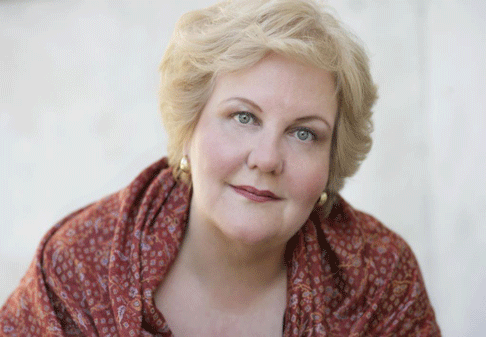 Jane Henschel [Photo by Barbara Eichinger]
Jane Henschel [Photo by Barbara Eichinger]
There is much ‘evil’ in Peter Grimes, but it is a more subtle, cloaked and ambiguous malevolence, a malice which is deeply disconcerting and troubling:
“It is one of those pieces that is more moving for the audience than for us on stage. It’s the old truism — we shouldn’t cry, we should make the audience cry. We have to find a distance; and because some of the most moving scenes, such as with the child, are not actually on stage, it’s a little easier to get that distance.” Other than Ellen, the characters have little pity for Grimes, and while Ned Keene and Balstrode are less judgmental, they cannot ignore or overcome the collective verdict of the shipping village; and, this production emphasises Grimes’ existential isolation.
“The chorus is actually the biggest role in this piece —musically it’s a very tricky role — and this makes the atmosphere so claustrophobic. “
I remark that when I saw this production in 2004 I felt that the rigidity of the community was emphasised, particularly in the church scenes when they are literally all ‘singing from the same hymn-book’, and that this is a very ‘anti-religious production. Henschel agrees:
“And, the set helps this, with the high, straight walls, and the tavern with its imposing back wall. I imagine when you see it from the front it’s rather daunting. It’s very bleak and ‘edgy’.”
How does she see her own part in the persecution of Grimes?
“In this production, Mrs Sedley has a crucial role — she’s always watching what is going on, and she disapproves of the tavern, even though she’s drug-dependent herself. In fact, her hypocrisy isn’t emphasised in this production, because although it reveals her flaw, her weakness, here it is her strength which is emphasised.”
Henschel trained at the University of Southern California in Los Angeles, before moving to Europe where she sang in local repertory houses in Germany — “that was actually my training” — where she was fortunate to be able to sing many big roles away from the spotlight.
I ask Henschel if she thought it was usual, or necessary, for young American singers to come to Europe to ‘learn the trade’.
“For a while there were very few American singers coming to Europe because when the [Berlin] Wall came down lots of very talented Eastern European singers travelled to the West, and perhaps they were willing to work for a bit less money … but also, in America there more singing programmes, more small opera companies and greater opportunities to sing, so there was not so much need to come to Europe. But, now, finances in America are so tight that young singers are again travelling here to begin their careers.”
Henschel truly values the opportunities she had as a young singer in a German house; although the big Strauss roles came later, she was able to tackle many of the major repertory roles, including Tristan, Lohengrin and nearly all of Verdi — this is especially important to her, as many of these roles she now no longer sings, except for Mistress Quickly in Falstaff and Ulrica in Un Ballo in Maschera, because, she says wryly, “no other mezzos want to do it!”
“In the end you have to find the place where you are better than most people and stick with it. It’s great to be able to sing exactly what you want to sing, but it doesn’t always work that way. […] I started with dramatic repertory, even though I was just 24, because I was hired as a dramatic mezzo — and it’s bad advice for any young singer but it just worked out that way and I was able to sing all of those roles without hurting my voice. But, I was always happy though to do the Messiahs and Bach … and I still warm up with Rossini every day, because I believe that really any dramatic voice should be able to move at least somewhat. If the voice is so tense and so pushed that it won’t work quickly then you don’t have the dramatic flexibility.”
I wonder if there any of the numerous roles she’s explored have been less fulfilling.
“There is one role that I’ve done quite a bit but it’s not my favourite role and that’s Kabanicha in Katya Kabanova. I’ve done only one production, but I’ve done it all over, and that’s the Salzburg production by Marthaler. And he had Kabanicha in her bedroom along the side of the stage and so she was watching quite a lot of what was going on; it made the role more interesting and more sympathetic, as it showed another side of her. But, basically she’s a harridan and she has no redeeming factors, and she screams all the time! On the other hand, Kostelnička in Jenufa, is much more beautiful to sing; and, she asks for forgiveness.”
Simultaneously, we both remark that in fact Kabanicha and Mrs Sedley have a lot in common! They are similarly hypocritical; and, both push an individual to the brink, enjoy doing so, and carry the community with them. “But Mrs Sedley is more fulfilling to sing; they’re totally different — Mrs Sedley is quite low whereas the other is quite high — it’s just not screaming at people all of the time!”
Henschel also relishes teaching. Although previously she did teach beginners, for the last three years she has taught only young professionals as they start out on their careers. “I find it’s very rewarding, I learn so much. You have to figure out what the problem is and why it’s there. How am I going to get the singer to change it? How am I going to explain it? And I find that although there are some things you say to every student, there are other things that are individual — everyone is different. And I’ve had to think about what I do, and it’s made me analyse my own singing. […] I think singing needs to be as close to speaking as possible — it sounds ridiculous but the more difficult you make it … there are so many different ways of approaching it because you can’t say ‘move this and don’t move that’, or ‘relax this but not completely’.”
Home is in Dusseldorf, and Henschel is always pleased to sing before her ‘local audience’, but future projects will continue to take her all over the world — in the next few months to Madrid, Moscow, and Valencia. The one role that Henschel admits that she would perhaps have liked to have done is Santuzza in Cavalleria rusticana but she’s just delighted to have “had such a wonderful career and it’s wonderful to have been a part of this family here [at Covent Garden] for so many years. I’ve been lucky too — there’s always a bit of luck involved.” I point out that you need luck but you also have to take all the opportunities that arise, to which Henschel astutely replies: “You also have to be ready for them”.
Good advice for any aspiring performer. And, there may be many of those in the audience of the schools matinée on Friday 17th June, when Henschel marks her 100th performance at Covent Garden — an anniversary that, with typical modesty, she fails to mention.
Claire Seymour
Peter Grimes opens on Tuesday 21 June 2011 and runs until Sunday 03 Jul 2011.
image=http://www.operatoday.com/Henschel_Elektra.gif image_description=Jane Henschel as Elektra (Deutsche Oper Berlin) [Photo courtesy of Askonas Holt] product=yes product_title=Jane Henschel — An Interview product_by=Interview by Claire Seymour product_id=Above: Jane Henschel as Elektra (Deutsche Oper Berlin) [Photo courtesy of Askonas Holt]June 15, 2011
Les Huguenots, La Monnaie, Brussels
By Francis Carlin [Financial Times, 15 June 2011]
Meyerbeer’s grand French operas were very much creatures of their time, bloated extravaganzas that needed the considerable resources of the Paris Opera to work. If they are so rarely performed today, it has nothing to do with a cabal manoeuvring behind the scenes as so many of his fans claim, but because they are too demanding and overlong.
Israel Opera cuts wide swath at festival
Then it was Opera at Masada, where Verdi’s Nabucco was performed in a mammoth new open-air theater set between the mountain central to Jewish identify and the Dead Sea. A recital by Jesse Norman was included in the season.
This year it was the Masada Dead Sea and Jerusalem Opera Festival Six performances of Verdi’s Aida were set for at Masada, while Verdi’s rarely performed Jerusalem, a revision of his I Lombardi, was staged at Sultan’s Pool, once a reservoir in Jerusalem’s historic water system. This was also a season of collaborations that contributed greatly to plans by Israel Opera’s inventive general director Hanna Munitz to make this a destination festival on a level with long established programs in Europe.
Special this year was the Masada performance of Verdi’s Missa da Requiem by orchestra and soloists from Arena di Verona, the Italian festival that reaches back to 1913. In the performance the opened the season on June 3 Giuliano Carella conducted the Verona forces, plus the Israel Opera Chorus and Tel Aviv Philharmonic Choir. The Verona guests further offered an evening of opera’s greatest hits at Sultan’s Pool, attended by 5000 enthusiastic fans. Star of that show was internationally celebrated tenor Setfano Secco in such favorites as “Nessun dorma” and “E lucevan le stelle.” Carella made the evening a success despite a sound system unfair to the instrumentalists involved.
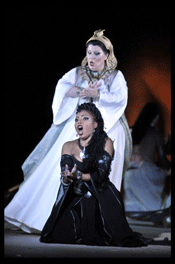
Once the fireworks of the Triumphal March were out of the way, Aida, seen on June 5, seemed a work not terribly well suited to the vastness of Masada. In the essential duet that results in Aida’s confession of her love for Radames, Aida and Amneris seemed lost in the desert night and without the dramatic personal confrontation that sets the scene for the rest of the story.
Happily, things improved after intermission when China’s Hui He made her entrance on a camel. And it was He who earned high marks for her work in the title role. A former IO Tosca, He was a strong but gently female Aida whose love grew ever greater when challenged.
Of course, it’s hard to avoid the feeling that Verdi stacked the cards against Egyptian Princess Amneris, who has little chance of winning the sympathy of an audience. Amneris is primarily a public person, never intended to be passion’s plaything. In the role Hungarian-born mezzo Ildiko Komlosi was a regal presence, conscious of her role in the conflict between public and personal feelings. Yet it was clear that she had no choice in setting the events that would lead to Radames’ death in motion.
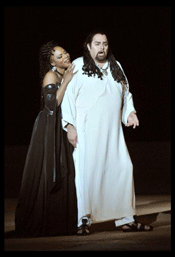
Although in appearance hardly a dream Radames Pierre Giuliacci, a familiar figure at European festivals was equally heroic and sensuous as Radames. Veteran bass Paata Burchuladze brought dignity to High Priest Ramfis. Born is a Georgia then part of the Soviet Union, Burchuladze has been an Israel favorite since he sang the title role in the Boris Godunov that opened the opera house in Tel Aviv in 1995. (Thus Israelis overlook an increasingly wide vibrato that is irritating to non-fans.) Italy’s Roberto Frontali made his IO debut as a movingly human Egyptian King Amonasro.
The staging, directed by Charles Roubaud, was largely straightforward. Sets by Emmanuelle Favre were minimal — four sphinxes and a huge royal statue — and wisely made no effort to compete with impressive natural surroundings. Costume designer Denise Dufolt appeared to have found a bargain in white cotton, the dominant material in mob scenes, but unflattering to the full figure of Giulliaci.
Especially effective were projections onto Masada Mountain designed by Nicolas Topor. The production added a bit of local color by including residents of a local Bedouin village in lieu of a dance ensemble. Daniel Oren conducted the IO Orchestra Rishon LeZion.
The sound system failed for a moment late in the production, stressing that technology is never totally reliable. Nonetheless, this was all in all a successful, if not memorable Aida, but as entertainment no match for the exuberance of the 2010 Nabucco, which reached its high point when conductor Daniel Oren conducted the audience in a “community sing” repeat of the famous chorus “Va, pensiero.” Aida does not invite such audience participation.
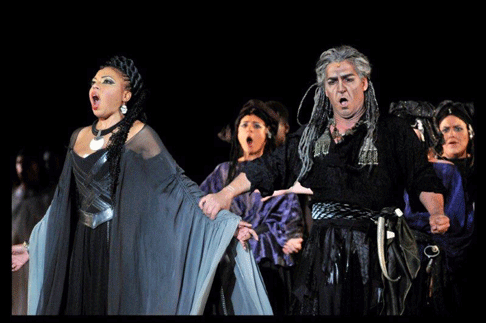
Aida was a co-production with Les Choragies d’Orange and will be staged at the Roman Theatre in Orange.
The current season concluded with a Masada concert by Italian tenor Andrea Bocelli on June 12. In a further expansion of the season, 30 chamber concerts were performed in Jerusalem at places of worship and historic sites in the city.
Bizet’s Carmen has been announced as the major opera of the festival’s 2012 season.
While European cultural capitals have their castles and cathedrals Israel offers the visitor over 2000 years of — often tormented — history. Even so, archeological activity continues at break-neck speed.
Israel is a small and easily manageable land. Tel Aviv and Jerusalem, its major cities, are an hour apart, and the drop from Jerusalem to the Dead Sea is approximately that distance. Where but in Israel can one float in the Dead Sea, have dinner and head for an opera at Masada all in one afternoon?
Wes Blomster
image=http://www.operatoday.com/Aida_Israel_01.gif image_description=Aida Israel Opera [Photo by Yossi Zwecker] product=yes product_title=Verdi: Aida product_by=Ramfis: Paata Burchuladze; Radames: Pierre Giulliaci; Amneris: Ildiko Komlosi; Aida: Hui He; King of Egypt: Carlo Striuli; Messenger: Yosef Aridan; Amonasro: Roberto Frontali; High Priestess: Efrat Ashkenazi. Conductor: Daniel Oren; Director: Charles Roubaud; Set Designer: Emmanuelle Favre; Costume Designer: Denise Dufolt; Lighting: Avi Yona Bueno; Choreography: Jean-Charles Gil; Video Designer: Nicolas Topor. Israel Opera: Open-air Theater at Masada, June 5, 2011. product_id=All photos by Yossi Zwecker courtesy of Israel OperaJune 14, 2011
Simon Boccanegra, ENO
Not only did the set for the prologue, a town square in 1960s mafia-controlled Genoa, follow Miller’s Rigoletto in drawing on Edward Hopper’s ‘Nighthawks’, but it was also an urban variation of the desert diner design of Miller’s 2009 L’elisir d’amore.
As trench-coated gangster, trilbies inclined to mask their plotting and intriguing, gathered in a night-time café, and Graham-Greene-esque figures lurked menacingly on street corners, a stylish car rolled in from stage right, and then proceeded to flash its lights unceasingly — and headache-inducingly — for the entire prologue.
Certainly the designs for this prologue were by far the most engaging, and dramatically relevant, of the evening. When we whizzed on twenty-five years (or, in this production, perhaps forty years) for Act 1, minimalism took over from realism — although the assault on the audience’s eyes continued, this time in the form of a glaring white square on the bleak, black back wall. The Grimaldi household was a sparse and modernist affair: one white arm-chair, one wall painting. In fact, the latter had occasioned the most surprising and exciting moment of the production, when the final tableau of the Genoan street scene was electronically transferred to a stage drop and electronically shrunk, rapidly receding only to reappear as a pictorial memory of the past on the wall of the family home.
In the final two acts, a featureless, grey, rather underequipped committee room, in a bland corporate command centre, replaced the majestic Doge’s place of the original scenario. The fully functioning wall clock suggested a countdown to crisis, but why did the various stages of action commence at seeming random hours thereby destroying the realism? There were many other non sequiturs: doors which were immovably fixed, but then swung freely open; a text (translation by James Fenton) which spoke of ‘swords’ as the gangsters brandished their steel hand guns. Motifs and ideas were introduced but not developed: so, having decided to update the action almost to the modern day, Tcherniakov seemed to lost interest in pursuing real-life parallels after the prologue — a pity, as there is plenty of potential for highlighting modern-day coups d’état , given recent history and even the contemporary ‘Arab Spring’. Moreover, the costumes did little to add to the impression that this was a serious attempt to portray political power struggles: Adorno’s biker’s leathers and Amelia’s grungy Doc-Martens jarred with the endless grey suits, and I’d be grateful for an explanation as to why Boccanegra sported a ludicrous paper hat on his head during his final decline?
I’m not sure that Tcherniakov was really interesting in engaging his audience. He frequently placed his characters to the rear or edges of the stage, or with their backs to the auditorium; and, it was unclear at times whether characters sharing the stage could or couldn’t see/hear each other. Add some inexplicable stage business — the desperate wrestling over Maria’s dead body which was almost ripped apart in a tug-of-war between Boccanegra and the patriacians; Paolo’s cartoonish writhing and squirming when, alone on stage at the end of Act 1 Scene 1, he bitterly conjures up his dastardly plot; the final tussle between Amelia and her new husband, Adorno, with the plebs joining in the fisticuffs as the curtain fell — and the overall vision was incomprehensible.
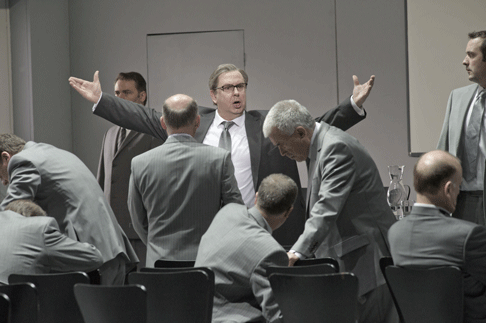
Perhaps Tcherniakov thought that because the plot is so notoriously complicated that such details would not matter. Indeed, he tried to help us follow the action by projecting the unfolding readout of a tele-printer onto the stage drop before each act or scene. These were indeed useful at times, but, presumably to cover a tricky scene stage, an overly explanation after the prologue caused the action to stagnate, diminishing the musico-dramatic momentum which has been so skilfully built by conductor, Edward Gardner. And, there are inherent dangers in highlighting the libretto’s more ridiculous moments: an inevitable audience chuckle accompanied the bald statements, in successful sentences, that Amelia had been abducted, but … she had now managed to escape. There are many awkward ‘fudges’ in the text, and they are probably best ignored — the music should make the narrative and emotional drama clear.
Thank goodness, then, that the music and much of the singing were top notch. As the eponymous champion of the people, Bruno Caproni — after an underwhelming start during which an over-indulgent vibrato muddled the intonation — grew in stature, and in his final poignant portrayal of regret revealed an expressive, flexible voice of pleasing tone. His diction was superb throughout, even when he was placed in the margins or at the rear of the stage. Roland Wood, as Paolo, also took some time to get into his stride, but produced a strong performance in the final Act. Peter Auty and Rena Harms were musically effective but not entirely suited dramatically to their roles as Adorno and Ameila. Both exhibited brightness and lightness at the top of their registers, but lacked some of the gravity required; Harms struggled to convey the developing complexities of Amelia’s character as her knowledge and understanding of her past and present increase, while Auty had tuning some problems during his big moments.
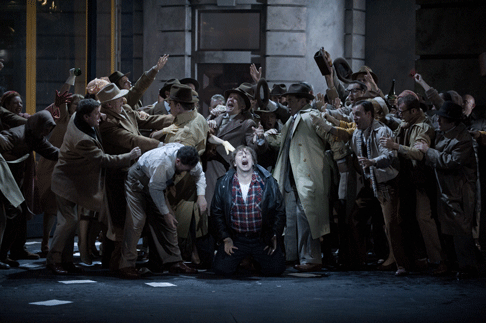
Best of the bunch was Brindley Sharratt’s Fiesco; although Fiesco was clutching an asthmatic’s inhaler, he clearly suffered no problems with his lungs, and produced a powerful tone which carried the clearly articulated to the farthest reaches of the house. Despite his vengeful plotting, with its tragic consequences, Sharratt won the audience’s sympathy, and the final duet between Fiesco and the faltering Boccanegra was immensely moving.
But the loudest applause of the night was deservedly awarded to Edward Gardner and the ENO orchestra. Gardner gradually ratcheted up the musical and dramatic tension, controlling the broader structures with a masterful sweep. The way he whipped the chorus from pianissimos to fiery climaxes was astounding. Sensitive to the needs of the drama, and individual singers, he also allowed the instrumentalists free rein when it was the turn of the score to carry the responsibility for the expressive drama. It was a relief that at least someone was able to make a coherent unity of the work.
Claire Seymour
image=http://www.operatoday.com/Simon-Boccanegra_Brindley-S.gif image_description=Brindley Sherratt as Jacopo Fiesco [Photo by Mike Hoban courtesy of English National Opera] product=yes product_title=Giuseppe Verdi: Simon Boccanegra product_by=Simon Boccanegra: Bruno Caproni; Amelia Boccanegra: Rena Harms; Jacopo Fiesco: Brindley Sherratt; Gabriele Adorno: Peter Auty; Paolo Albiani: Roland Wood; Pietro: Mark Richardson; A captain: David Newman; Amelia’s maid: Judith Douglas. Conductor: Edward Gardner. Director: Dmitri Tcherniakov. Set Designer: Dmitri Tcherniakov. Lighting Designer: Gleb Filshtinsky. Video Designer: Finn Ross. English National Opera, London Coliseum. Wednesday 8th June, 2011. product_id=Above: Brindley Sherratt as Jacopo FiescoAll photos by Mike Hoban courtesy of English National Opera
New directions at the Royal Opera House
He’ll be working with Kaspar Holten who becomes Director from September 2011. Fulljames is a daring, but inspired choice.
This could be interesting news. Currently, Elaine Padmore is Director of Opera, responsible for both artistic direction and production. When she retires in September, Kaspar Holten will become Director of Opera, while Cormac Simms, currently General Manager, will become Administrative Director.
Padmore was Artistic Director of the Copenhagen Opera before 2000, when Holten, then only in his mid 20’s, succeeded her. Now that she’s leaving the Royal Opera House, he’s following her to London. The transition should be smooth and relations between London and Copenhagen have been cordial.
In Denmark, Holten oversaw the opening of the new Opera House at Copenhagen in 2005, so he has sound management experience. But he’s also an opera director, who creates his own productions. He directed the famous Copenhagen Wagner Ring, which confirmed the company’s status on the European opera circuit. He’s also interested in film, and the possibilities film opens up for opera. His Juan, a retelling of Don Giovanni in English is being screened in film festivals around the world. He’s very much a hands-on artist, so it’s understood that he will be directing productions after current commitments in the next few years are cleared.
“It’s a hugely challenging time ahead”, says Antonio Pappano, Music Director and Chief Conductor of the Royal Opera House. “We’re continually striving to present the very best on our stages and I think with the combined energies and expertise of Kasper and John, and ably supported by Cormac Simms, audiences can expect to see some very fascinating developments building on the wonderful work of the past decade in the new theatre.”
John Fulljames is highly respected, and charismatic. Although he won a First in Physics at Cambridge he’s also a musician. He was a founder of The Opera Group, an adventurous company that specializes in chamber opera. If Fulljames’s work can be characterized in any way, it is influenced by his deep appreciation of the musical roots of opera. He’s even been a singer, so he understands voice.
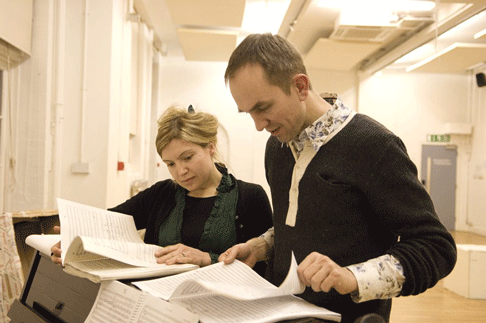 John Fulljames [Photo by Katie Leedale]
John Fulljames [Photo by Katie Leedale]
Fulljames works closely with composers when he can, which is why he’s created so many modern operas. His staging of George Benjamin’s Into the Little Hill was superlative because it was so true to the spirit of the opera. It was reviewed in Opera Today in July 2010.
Currently, Fulljames and the Opera Group are working on Luke Bedford’s Seven Angels. Bedford is one of finest young British composers, who has a special affinity for voice. Writing for the stage, however, is different from writing for the concert hall, so Bedford worked closely from the start with Glyn Maxwell, his librettist, who is both poet and playwright. Fulljames and artist Takamine Tadasu were involved at a very early stage. “As John has been involved in the project from the beginning”, says Bedford, “He’s seen how Glyn and I have shaped it, so he has a deep and sensitive understanding of what we’re trying to achieve.” Seven Angels tours from 17th June 2011 and reaches the Linbury Theatre at the Royal Opera House from 12th July.
Recent productions elsewhere include The Excursions of Mr Broucek, Romeo et Juliette and Hansel and Gretel (Opera North), Gianni Schicchi, Zemlinsky Florentine Tragedy,Mavra (Greek National Opera), Von Heute auf Morgen (Lyon) Tobias and the Angel (Young Vic), Nabucco (Opera Holland Park),Rimsky-Korsakov’s Snegurochka for Wexford Festival which opened the new opera house in Wexford, Ireland, where he earlier directed Carlisle Floyd’s Susannah.
Anne Ozorio
image=http://www.operatoday.com/john-fulljames.gif
image_description=John Fulljames [Photo by Greg Funnell (2009)]
product=yes
product_title=New directions at the Royal Opera House
product_by=By Anne Ozorio
product_id=Above: John Fulljames [Photo by Greg Funnell (2009)]
L’amico Fritz, London
We expect the white-hot intensity of passion, bloody vendettas, blazing fury, recklessness and danger.
It’s therefore surprising to find Pietro Mascagni, the composer of one of the classic examples of this naturalistic genre, following up the trail-breaking Cavalleria rusticana just one year later with L’amico Fritz, a gentle bucolic tale of unrequited love … not a flashing dagger or bloody assassination in sight! Moreover, realism seems not to have been a priority: the setting is ‘somewhere’ in Alsace, the period ‘some time’ in the nineteenth century, and any contemporary political tensions between Christians, Anabaptists and Jews are overlooked in the interest of a happy ending.
In an interesting programme article, Robert Thicknesse reveals that it was actually Mascagni’s intention to write a work that was as different to Cavalleria as possible: “I want to take a different toad, particularly seeing that too many newspapers, praising Cavalleria, attributed all its success to the libretto. For that reason, l I want a simple libretto, something almost insubstantial, so the opera will be judged entirely on its music.”
In the event, the text by Nicola Daspuro, with additions by Giovanni Targioni-Tozzetti (based on the French novel L'ami Fritz by Émile Erckmann and Pierre-Alexandre Chatrian) was judged by Verdi to be “the worst libretto I’ve ever seen”, while composer Antonio Camps declared that the opera was sure to fail as, lacking passion, it would never enrapture its audiences. However, after performances in 1891 in five Italian cities, it was successfully exported to Hamburg (conducted by Gustav Mahler), Berlin, Vienna, Prague, arriving at the Royal Opera House, London in 1892 and evening travelling to Australia in 1893.
Certainly, it’s a slightly daft affair with little dramatic tension, the favourable denouement never in doubt. Confirmed bachelor, Fritz Kobus, a wealthy landowner, professes a disdain for marriage; but, his rabbi friend, David, suspects that Fritz is developing amorous feelings for Suzel, the daughter of one of his tenants, and suggests to his friend that she would make a good bride. Protesting that she is too young to marry, Fritz bets David on of his vineyards that he himself will never marry.
When Fritz visits Suzel in the countryside, the idyllic spring air and floral scents begin to work their erotic magic, but tentative romantic leanings are interrupted by the arrival of Fritz’s friends who ask Fritz to show them the farm, leaving Suzel and David alone. Suzel is embarrassed by the rabbi’s suggestion that she should marry; later, when David intimates to Fritz that he’s found the perfect husband for Suzel, the two men argue.
By now Fritz has realised that he has fallen in love; he returns to town but cannot banish thoughts of Suzel — even the songs of his gypsy friend, Beppe, fail to lift his spirits. Suzel too is in despair, despite David’s reassurances that all will be well. But after further intrigue and machinations by David, a passionate declaration of love ensues. Fritz has lost his wager; but, David announces that he is going to give his prize — Fritz’s vineyard — to Suzel as a wedding present.
This delightful Opera Holland Park production clearly demonstrated why Mascagni was right to have faith in this simple, sentimental divertissement. Verismo was never a merely dramatic genre, but also a musical one, characterised by passionate declamation by solo voices, emotionally charged melodies, and affecting harmonies and modulations. And, in Mascagni’s score glorious melodies tumble one after the other in an endless stream of beautiful lyricism, coloured by imaginative harmonic twists and turns, enriched by instrumentation.
Sensibly, director Annilese Miskimmon resisted the temptation to tamper unnecessarily with the wafer-thin libretto, transferring the action to the 1950s — Fritz is a property developer, marketing domestic tranquillity and bliss: “The perfect home for your perfect wife” . In so doing, she emphasises the fresh charm and exuberance of the opera. The retro designers by Nicky Shaw are both enchanting and clever. Dividing the Act 1 stage into a typists’ pool, reception and boss’s office is a neat trick which allows for some effective juxtapositions and asides. And, the slick transformation from corporate office to rural idyll, as the recorded nightingale trilled, fully deserved its round of appreciative applause.
Moreover, whatever the work’s dramatic or musical merits, it’s worth seeing this Opera Holland Park production just to hear Anna Leese as Suzel, as she flawlessly captures the coy grace of the naïve peasant girl. From her first appearance, tentatively clutching a bouquet of violets for the birthday boy, Fritz, it was clear that Suzel’s gauche simplicity, so incongruous among the sharp office suits and Mondrians, would triumph. Leese’s soprano soared creamily and effortlessly above the fairly large orchestral forces — no mean feat in this auditorium. And, her transformation from inexperienced country lass to flourishing young woman was totally credible.
The ‘cherry duet’ between Fritz and Suzel in Act 2 is the opera’s pièce de résistance; if the plot is a sort of ‘vengeance-free’ Romeo and Juliet, this duet is suggestive of the mystery and enchantment of A Midsummer Night’s Dream:
“So we grew together,
Like to a double Cherry, seeming parted,
But yet a union in partition;
Two lovely berries moulded on one stem.”
Eric Margiore certainly looked the part of the gallant, handsome bachelor, and brought a strong stage presence to Fritz; but, despite his pleasing lyric tenor, he didn’t quite have the stamina required. Though he phrased the lines intelligently, he occasionally sounded strained and rather rough-edged, especially in the Act 3 homage to Love, ‘O amore, o bella luce del core’.
David is an ambiguous role, at times a comic schemer, elsewhere a surprisingly hostile meddler. David Stephenson’s interpretation was engaging and convincing, and his Act 2 duet with Fritz dramatic and compelling. Patricia Orr sang the en travesti role of the gypsy fiddler Beppe with panache; her birthday song to Fritz is preceded by an extended offstage violin solo — here rendered with character and flair by Iwona Boesche — and the quick switch between the two performers was deftly done. In the smaller roles of Federico and Hanezò, Fritz’s friends, Robert Burt and Simon Wilding provided strong support.
Conducting an alert and precise City of London Sinfonia, Stuart Stratford made much of the score’s expressive details. In particular, the orchestra relished the both the sweetness and the drama of the Intermezzo which precedes Act 3.
The happy ending may never be in doubt, but what it lacks in dramatic tension is more than compensated for by the opera’s glorious, irresistible music. This romantic fable set in an idyllic rural world is just the thing to beguile one’s cares.
Claire Seymour
image=http://www.operatoday.com/Fritz_0404_lzn_.gif image_description=Anna Leese as Suzel and Eric Margiore as Fritz [Photo by Fritz Curzon courtesy of Opera Holland Park] product=yes product_title=Pietro Mascagni: L’amico Fritz product_by=Fritz Kobus, a wealthy landowner: Eric Margiore; David, a rabbi: David Stephenson; Federico, a friend to Fritz: Robert Burt; Hanezò, a friend to Fritz: Simon Wilding; Suzel, daughter of a tenant of Fritz: Anna Leese; Beppe, Fritz's friend, a gypsy: Patricia Orr; Caterina, a servant: Susan Young. Conductor: Stuart Stratford. Director: Annilese Miskimmon. Designer: Nicky Shaw. Lighting director: Mark Jonathan. Costume supervisor: David Thorne. Opera Holland Park, Friday 10th June, 2011. product_id=Above: Anna Leese as Suzel and Eric Margiore as Fritz [Photo by Fritz Curzon courtesy of Opera Holland Park]June 12, 2011
Tosca, Covent Garden
The film will feature Angela Gheorghiu, Bryn Terfel and Jonas Kaufmann, all of whom have sung in this production before — Gheorghiu and Terfel together in 2006 and 2009, and Kaufmann for the first time in 2008.
The current season started, however, with an alternate cast — Marcelo Giordano, Juha Uusitalo and Martina Serafin. Giordano sang Cavaradossi in 2006, and with Gheorghiu and Terfel in 2009, so he’s experienced in the role. On the first night of the run, he had intonation problems to start with, but settled well, only to have his voice break badly in the crucial Act Three arias. No-one regrets it more than the singer himself, when “E muoio disperato!” comes out more desperate than it should be. But such things happen, even to very experienced singers. In any case, this audience didn’t seem to mind and applauded him warmly. Tosca is such a glorious opera that it’s always a good night out even when it’s not perfect.
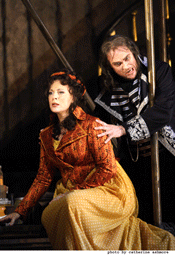 Martina Serafin as Tosca and Juha Uusitalo as Scarpia
Martina Serafin as Tosca and Juha Uusitalo as Scarpia
Juha Uusitalo was making his Royal Opera House debut, though he’s appeared all over Europe and in the US, and in concert performances in London. His Scarpia is interesting, more subtle and introspective than some, but that’s a perfectly valid interpretation of the role. Tosca wears her heart on her sleeve, but Scarpia has risen to power by concealing his. Scarpia is a cold-blooded hunter who doesn’t reveal himself, but Uusitalo’s tightly controlled phrases and brisk intonation suggest the tension that might lie within the charcater.He’s so used to being in command that he can silence the commotion in church by a swift glance and a sarcastic phrase “Bel rispetto!”. Uusitalo ‘s stage presence carries authority even when he’s not singing.
Martina Serafin has created Tosca in Vienna, Rome and Taormina. She’s charming and the London audience delighted in her coquettish Act One jealousy. Tosca, however, is a much more complex personality, and the jealousy can be a glimpse of much greater violence in the character. Whether it’s Serafin or the revival direction (Duncan Macfarlane) the murder scene is a curious anticlimax. The orchestra wells up, as the music’s expressing extreme alarm. Serafin leans against Uusitalio, but so politely that if you didn’t know, you’d wonder why he drops to the ground in agony.
In contrast, Jeremy White’s Sacristan was very animated, reflecting the subtle changes in mood as the Sacristan interacts with different people. As whole mayhem breaks out around him, the Sacristan is anchored, sensitive to others, but sensible. Another contrast to Tosca, but without Scarpia’s menace,
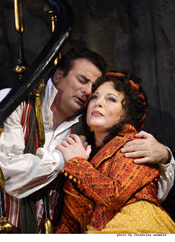 Marcello Giordani as Cavaradossi and Martina Serafin as Tosca
Marcello Giordani as Cavaradossi and Martina Serafin as Tosca
Hubert Francis’s Spoletta worked well with Uusitalo’s discreet Scarpia. Angelotti was Lukas Jakobski and Sciarrone was Zhengzhong Zhou, both members of the Jette Parker Young Artists Programme. The Shepherd Boy, William Payne, was a delight.
Usually, Antonio Pappano’s Puccini is superb, as he has the Puccini spirit in his soul, but at the first night performance even his irrepressible energy seemed to have deserted him. Just as the direction on stage seemed lifeless, the orchestral playing sounded like a rehearsal. Nonetheless, Pappano and the Royal Opera House orchestra are very good even when under par. In other houses this would have been fine, but we’re so used to excellence that average doesn’t excite.
One compensation was that it was an opportunity to study the scenery, which you can’t when performances are white hot. The scene in the church is brightly lit, with candles everywhere. On stage, attention is dissipated, but the scene could film well. Scarpia’s chambers reflect the grandeur of his status. Magnificent statues dwarf the singers, just as the opulence of the music shows up the tawdry proceedings in the plot.
The Final Act is most impressive of all. Gone are the trappings of worldly splendour. Cavaradossi now inhabits a stark no man’s land. The music gets to work its sinister magic without distraction. A man is seen getting dressed. He looks human and vulnerable, but when he’s in uniform he becomes a killing machine. The set is plain, but eloquent, for now there’s no room for manoeuvre. Even if Cavaradossi escaped, he wouldn’t be safe when news gets out of Scarpia’s death. Poor Tosca goes off the wall, in more ways than the obvious.
Tosca runs at the Royal Opera House, London until 17th July. Filming with the second cast starts on 14th July. For more information please see the Royal Opera House site.
Anne Ozorio
image=http://www.operatoday.com/TOSCA.2484ashm_0265.gif
image_description=Martina Serafin as Tosca [Photo by Catherine Ashmore courtesy of Royal Opera House]
product=yes
product_title=Giacomo Puccini: Tosca
product_by=Angelotti: Lukas Jakobski, Sacristan: Jeremy White, Cavaradossi: Marcelo Giordano, Tosca: Martina Serafin, Baron Scarpia: Juha Uusitalo, Spoletta: Hubert Francis, Sciarrone: Zhengzhong Zhou, Shepherd Boy: William Payne, Gaoler: Joihn Morrisey. Conductor: Antonio Pappano. Chorusmaster: Renato Balsadonna. Director (original): Jonathan Kent. Director (revival): Duncan MacFarlane. Designs: Paul Brown. Lighting: Mark Henderson. Royal Opera House, London, 7th June 2011.
product_id=Above: Martina Serafin as Tosca
All photos by Catherine Ashmore courtesy of Royal Opera House
June 10, 2011
Tosca, Royal Opera House, London
By Richard Fairman [Financial Times, 10 June 2011]
Five years ago there was apprehension when the Royal Opera announced that it was disposing of its classic Zeffirelli production of Tosca, the one that can be seen in the historic film with Maria Callas. Now its successor is also going to be filmed and an all-star cast is being assembled especially for the last two performances of this revival.
Luke Bedford’s Seven Angels
Bedford is one of the finest British composers of his generation. Any new piece of his is big news, but what makes Seven Angels significant is that Bedford writes especially well for voice. It’s his first opera, and its genesis shows how thoughtfully he’s taken to writing for the stage.
Seven Angels was inspired by John Milton’s Paradise Lost. “You can’t set Paradise Lost,” says Glyn Maxwell, the poet who wrote the libretto. “You have to read it, absorb it and then have a response.” The narrative is allegory, not literal setting. “We knew that we wanted to use Paradise Lost as a template in some way and to bring out issues of climate change and environmental destruction,” says Bedford. He, Maxwell and director John Fulljames worked together closely from the start. “The very rough outline of the story and the idea of the angels narrating it came from these sessions, if I remember correctly. Then Glyn went away and did a first draft synopsis, which beautifully collected together all the fragments of text and story that we had.”
In the new opera, seven angels have been falling from above and arrive in a deserted place. They try to work out who they are and where they are. Using such clues as they have, such as the wind and rain, they begin to construct a story that explains how this place was ruined. So each of the Angels acts as a narrator and also a character in the story they are telling.
Their story concerns a King and Queen, who have a beautiful garden; their son, the Prince; the Waitress, who serves him along with other members of the royal household; and three delegates from other lands who have travelled to see the garden. Eventually, the “Infinity of Plenty” the garden is supposed to represent is revealed as illusion. At the end of scene six, the Angels’ story breaks down and we are left with just the seven figures in their deserted landscape. However two of the Angels refuse to give up on the story and continue on into that world. “We are all that the Garden was,” sing the Waitress and the Prince. “We are all that the Garden is.”
Reading Glyn Maxwell’s text for Seven Angels is intriguing. On paper, their lines overlap, blank spaces indicating blank spaces in the score, perhaps. Intuitively, you can feel how Bedford’s setting might sound — wavering, dream-like textures, harmonies that flow effortlessly, creating atmosphere and wonder. Sometimes the text is set in dense blocs, which read with turbulent rhythm. Not all poets write well for the stage, but Glyn Maxwell is also a playwright. His experience in the theatre informs the way he writes for music. He’s written several libretti for opera, and texts for film. Drama is thus inherently linked to his work.
“Once we had something like a full libretto,” says Bedford, “I went away and tried working on sections of it. Sometimes I had an inkling of the music that I need to write straight away, other times not! The very opening of the opera was one of the hardest sections and took three or four drafts of very different material to get right. Whenever there was a section that I felt needed more, or more often less, text I would ask Glyn and he would be very understanding. Sometimes I asked for slightly different words at certain moments, so they fitted the music better. But by and large Glyn’s text just needed me to add some music to it.”
Bedford has collaborated with Maxwell before. Bedford’s Good Dream She Has stems from the idea of Adam and Eve, dreaming in Eden before the Fall. Seven Angels is a much larger piece. “There’s certainly a link between the kind of material in Good Dream and the opening section of the opera for example. In both pieces there are familiar tonal triads but they are chiseled out from their familiar surroundings and reseen in a new light.”
Bedford’s Seven Angels is, however, much larger and more ambitious. “One of the things I enjoyed about writing a ninety-minute-long work was being forced into having big changes of mood; of music; of style! So you’ll find some manically fast music, despair and even the dreaded word ‘humour’ in there too.”
“As there is a fair amount of narration by the Angels, I had to try to work out a way of telling the story musically. It is really important that the words are clear and understandable at these moments. So I worked on ways of incorporating recitative-like moments into the piece. If you look through the score, you will see quite a few senza misura bars, where the singer has a degree of rhythmical freedom. I found this was extremely useful in allowing the singers to help bring out the words.”
“Having said that, I didn’t want to have any sort of traditional aria and recitative-type structure in the piece. The music must be able to flow in and out of these narrated moments and I think the technique I found allows me to do that. Apart from the seven singers, there is an ensemble of twelve players. It’s quite an unusual line-up, not least as there are four violas in there and a concentration on lower, darker wind sounds. It could be the first opera where the contrabassoon part has more pages than the flute!” This is “Paradise Lost” after all, and the orchestration is atmospheric. Apart from the four violas and contrabass there are steel drums, piano, analogue radio, crotales, tam tam, cymbals, lion’s roar, a whip and rainstick.
What kind of opera is this where there are almost as many singers as instrumental players? In Bedford’s music, speech translates into beautifully expressive form. Bedford is the Wigmore Hall’s first composer in residence, and several of his works, like Or voit tout en aventure, are classics in new music terms. “The voice is something so fundamental and natural to us. It is the channel, through which composers can address audiences in a very direct way. It’s very humanness, with all the qualities and disadvantages that entails, is what appeals to me so much about the voice.”
“Writing for the stage”, he adds, “is indeed quite different from concert pieces. It feels as if there’s an extra dimension that you have to think about and it took me a little time at first to adjust to this,” says Bedford. “But once I got into the soundworld of the opera, I felt I could write quite quickly as there’s not only the text but the drama propelling where the music should go. The early workshops (with Maxwell and Fulljames) were really instructive for me, just to see what a difference it makes when someone is just standing singing from music, to when they start moving around and interacting with others. Suddenly this extra dimension comes to life.”
John Fulljames is director and artist Takamine Tadasu created the designs. Because Bedford and Maxwell worked so closely with Fulljames and Tadasu from the start, the production has grown organically from the opera. “They’ve come up with something that I think is going to look very special. The whole stage will be covered in over a thousand books and almost all the props will be created out of these books. Even the King and Queen’s garden will be one enormous pop-up book! As John has been involved in the project from the beginning, he’s seen how Glyn and I have shaped it, so he has a deep and sensitive understanding of what we’re trying to achieve.”.
Fulljames has just been appointed Associate Director of Opera at The Royal Opera House. This is good news, for Fulljames is one of the most promising directors in the business. He and the company he founded, The Opera Group, created the outstanding second production of George Benjamin’s Into The Little Hill, reviewed in depth here on Opera Today. Fulljames’s work has appeared at Wexford, Aldeburgh, the Linbury Theatre, the Young Vic, Opera North and throughout Europe.
Luke Bedford’s Seven Angels premieres in Birmingham on 17th June. The Birmingham Contemporary Music Group then tours to Cardiff, Glasgow, Brighton and Oxford, and comes to the Linbury at the Royal Opera House in London on 12th July. It’s also part of the Latitude Festival in Suffolk, a multi-genre event that attracts audiences who might not normally venture into opera or art music.
Anne Ozorio
For more details, please see, the Opera Group’s web site and the web site of the Royal Opera House.
Click here for a video preview.
image=http://www.operatoday.com/LukeBedfordBenEalovega1Bear.gif
image_description=Luke Bedford [Photo by Ben Ealovega]
product=yes
product_title=Luke Bedford: Seven Angels
product_by=Click here for cast and production information.
product_id=Above: Luke Bedford [Photo by Ben Ealovega]
June 9, 2011
Karlsruhe “Gioconda” Unintentionally ‘Konzertant’
Barbara Dobrzanksa continues to go from strength to considerable strength in the title role, with her secure soprano now assuming all the trappings of a thrilling spinto performer. Let’s cut to the chase: The Divine Miss D scored a triumph — personal, professional, artistic, musical — think of a category, and she nailed it. Her searing top notes rang out in the house, the chest tones were dramatic and solid, and her floated phrases and occasional messa di voce effects were nigh unto faultless. This supremely intelligent artist commands a reliable technique that not only allows for great nuance of utterance and phrasing, but also finds her as fresh-voiced at the finale as when the show began. When has any Gioconda tossed off the sudden coloratura flirting with Barnaba in the closing pages with such self-assured élan? (Pace, Maria.)
Let me go out on a limb here: there is possibly no singer currently performing the part that is in quite the same league as this Karlsruhe star. Why the theatre feels it must bring in Violeta Urmana (whom I do like) for an upcoming “gala” performance is beyond me. Barbara could probably be singing this and many other roles on world stages any time she wants. The local Publikum should (and does) rejoice in the fact that their Diva is a home body.
Her accomplishment was wonderfully partnered by Keith Ikaia-Purdy’s ringing Enzo. But stentorian singing of the high order is not his only asset, for Mr. I-P is above all else a supremely sensitive interpreter of the multi-faceted moods of the text. Without crooning he can scale back his sizable tenor to craft phrases of melting beauty, infused with great meaning. Moreover, his Italianate styling is well-judged and idiomatic. It is bittersweet to note that this run of Gioconda’s will mark Keith’s final scheduled appearances with the company. He will be missed in Karlsruhe. In the meantime, we reveled in his professionalism and craft, including a lovingly shaped, haunting “Cielo e Mar.”
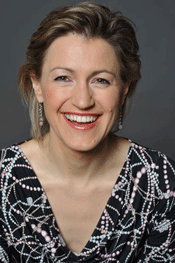 Sabina Willeit [Photo by Jochen Klenk]
Sabina Willeit [Photo by Jochen Klenk]
The evening’s true show stopping set piece, however, belonged to Dobrzanska and her Laura, the glamorous mezzo Sabina Willeit. Their heated Act I duet escalated to a fever pitch of sizzling singing and supremely bitchy confrontation, and the audience erupted like a group of opera-crazed Italians in an appreciative response. That ovation might be going on still had the conductor not finally urged things along. Ms. Willeit is another fine company asset, possessed of a throbbing, communicative instrument, somewhat bright with a wide range and considerable allure. As her husband Alvise, house favorite Konstantin Gorny did not disappoint. His familiar orotund bass rolled out to blanket the auditorium, and his sensible phrasing and reliable musicianship provided all that was wanted.
Anna Maria Dur contributed an affecting Cieca. Though not particularly matronly in demeanor (like Chookasian) nor voice (like Dunn), Ms. Dur suggested a frail, quirky mother eerily in the mold of “Six Feet Under’s” Frances Conroy. Her meaty mezzo was by turns plangent, urgent, and excitable as required and she found much variety in her relatively brief stage time. Walter Donati is a sturdy and stirring Barnaba. Mr. Donati’s career is somewhat a marvel, since he began as a successful tenor, switching mid-point to baritone and bringing with that an exceptional clarity of tone all the while having found a true baritonal core and timbre. And at 70+, he sounds more youthful and vibrant than most singers half his age. This is not the bullying, blustering Barnaba often encountered, but rather intensely focused and beautifully couched for maximum Slime Factor and dramatic impact.
Any house would be proud to have fielded this top notch sextet of soloists, who almost performed the feat of making you forget that when it came to the production, there was no “there” there. Sometimes a spare scenic design can focus the drama, and sometimes, as here, “less” is just “less.” Actually, make that…”least.”
Is there any locale more atmospheric and evocative than Venice. (That was rhetorical: No. Except maybe Bruges.) And yet set designer Siegfried E. Mayer found “gar nichts” to suggest the slightest hint of La Serenissima. In fact, let me be blunt. All he came up with was a butt-ugly set of orchestra risers surrounded by a box set of reflective walls that had all the beauty of a fading 50’s concert hall in Brno, and all the charm of a bus terminal in Tenafly. Mr. Mayer shared credit with Annegret Ritzel for a hodge-podge of costumes that seemed to have Fascist leanings, a look that was already tired out in German theatres in the 80’s.
Gioconda’s get-up was a cross between Sally Bowles in a trench coat and Lotte Lenya in Pierrette drag. Enzo (who is supposed to be incognito) sported a can’t-miss-him dazzling white sailor uniform that made him look like Pinkerton took a wrong turn from the dressing room. Poor Barnaba fared worst, looking as sinister as a Fasching reveler with a costume thrown together from the closet: flowered muumuu culottes, tux jacket with clownish white satin lapels, and a bird’s head hat like the god Horus as interpreted by South Park. And he was in white face. Laura first sported a black tailored jacket and Frederick’s of Hollywood metallic slip, then a flowered gown that just didn’t hang right (was it backwards?). Why the chorus women were look-alike Jean Harlow’s in Act IV is anybody’s guess.
Nor were any of these visuals helped in any way by Gerd Meier’s dismal lighting plot which seemed to have been created to keep the singers’ faces in as much darkness as possible. Alvise sang his entire second aria un-illuminated except by back-light until the final two bars when he wandered (by mistake?) into an area light down right. (I had the feeling that Herr Meier was somewhere hissing “My God, fools, his face is lit! Turn that light off! Turn it off!”) Note to all “designers:” it is not about you! The design elements should only exist to help the performers create their characters, and to tell the author’s story. Not “your” story…”the” story. When a light design robs the performer of the ability to communicate with the audience (“Two eyes to two eyes” as Martha Graham said) then you have made a bad lighting design. When you make the sinister baritone look like an inexplicable buffoon, you have made a bad costume design. When you fail to visually evoke any sense of time or place or intent, you have made a bad set design. Punkt!
Flavio Salamanka’s eccentric choreography of the famous “Dance of the Hours” was enthusiastically applauded, although its overall impact somewhat eluded me. The Karlsruhe corps boasts wonderful young female dancers to be sure and they threw themselves with skill and gusto into the concept of having an Adonis-like (sole) ballerino invading their regimented world. The scenario “seemed” to be about eschewing totalitarianism. As the girls stripped away their regimental jackets, and then their long black tulle skirts they did so with considerable more dramatic propulsion than was otherwise present in the longish evening. But while the steps and combinations were clever enough, and the groupings and intent sincere, the overall impact of the piece seemed pleasantly generic but dramatically neutral.
Ulrich Wagner’s chorus was polished and full-throated but did the entire group have to be trapped on stage for virtually the whole show for no good reason? They sat around on the risers in various vague groupings, trying to look interested, trying to stay in character and ultimately failing at both pursuits. Sorry to say Annegret Ritzel proved to be a better costume designer than director, for while her attire was variable it at least showed that she had made some choices. In her unfocused direction she seemed to avoid choices at all costs. Characters wandered at will. Actors didn’t look at each other or relate. Scenes meant to have characters in close proximity found them on opposite sides of the stage. And then there was the omnipresent bored chorus for the soloists to navigate around. I had the distinct feeling the experienced principals were doing their damndest to fill in the vast directorial blanks.
Attilio Tomasello took over the baton for the rest of the run with largely excellent results. The Karlsruhe pit is peopled by a superb group of musicians, and they had a very good night indeed. Maestro Tomasello deviated from a few standard choices of tempi with this phrase a bit slower, that phrase a bit faster, and yet another passage a lot slower, etc. but he partnered well enough with his singers and displayed secure control of the many large ensembles. I found the polished reading just shy of the passionate Italianate incisiveness that would have taken this Ponchielli pot-boiler to the ultimate level, with the strings, though assured, a little cool.
All told, it is always a pleasure to encounter this seldom-performed piece, especially a performance with such an exceptional International-level cast. But really, if you are going to go to such great lengths to make it look for all the world like a half-baked concert version, for God’s sake get all the crap out of the way, put the accomplished band, chorus and soloists on the stage and … just plain do it as a concert version. We would have been far better off.
James Sohre
image=http://www.operatoday.com/Dobrzanska.gif image_description=Barbara Dobrzanska [Photo by Jochen Klenk] product=yes product_title=Amilcare Ponchielli: La Gioconda product_by=La Gioconda: Barbara Dobrznaska; Laura Adorno: Sabina Willeit; Alvise Badoero: Konstantin Gorny; La Cieca: Anna Maria Dur; Enzo Grimaldo: Keith Ikaia-Purdy; Barnaba: Walter Donati; Zuàne: Alexander de Paula; Isèpo: Sebastian Haake. Conductor: Attilio Tomasello. Director: Annegret Ritzel. Set Design: Siegfried E. Mayer. Costume Design: Annegret Ritzel and Siegfried E. Mayer. Choreography: Flavio Salamanka. Chorus Master: Ulrich Wagner. Lighting Design: Gerd Meier. product_id=Above: Barbara Dobrzanska [Photo by Jochen Klenk]Andreas Scholl, Wigmore Hall
A capacity crowd at the Wigmore Hall eagerly awaited the arrival of Andreas Scholl and Tamar Halperin on the platform on Tuesday evening. Given the famed serene beauty of Scholl’s countertenor, the programme of mostly slow, contemplative songs from sixteenth- and seventeenth- century England, followed by simple canzonettas by Haydn and folksong arrangements by Brahms, promised great delights
However, Scholl took some time to settle down. Purcell has formed a staple element of his concert programmes and recordings of recent years, and he is renowned for the quiet, controlled restraint which so much of this repertoire demands; yet, the opening two songs suffered from a rather constricted, thin tone and a few problems with intonation. ‘Music for a while’ epitomises the composer’s deep, reflective style, characterised by a controlled simplicity which calls for clarity of line and carefully, flowing phrases. One would expect Scholl to effortlessly deliver the goods, but in contrast to the dark, expressive elaborations of Israeli harpsichord Tamar Halperin’s introductory harpsichord realisation, the vocal line rather lacked shape and focus, the phrases disrupted by exaggerated by over-emphasis on textual repetitions.
Scholl’s diction was also quite poor with consonants and vowels all sounding rather similar. Although it did improve as the evening progressed, he did not ever quite capture the subtleties of the texts, the rich suggestions latent in its metaphors and understatements — as in, for example, Johnson’s ‘Have you seen the bright lily grow/ Before rude hands have touched it?’ The exclamatory flourishes of ‘Sweeter than roses’ did, however, demonstrate his theatricality as the striking textual images triggered rapidly changing vocal moods, complemented by varied accompanying textures.
The first instrumental item completed this Purcellian group. Halperin’s rendering of ‘Round O’ was delicate and restrained; thoughtful ritenuti in the variations made the restatements of the theme seem relaxed and inevitable. Later, the slow movement of Handel’s F Major suite was similarly affective; the repeated middle-register chords above which the ornate stream of melody unfolds were evenly and carefully placed, a ceaseless, sustained bed of sound for the decorative figurations above. One longed for several more movements from this work.
Scholl continued with repertory by lutenists associated with the Elizabethan and Stuart courts — John Dowland, Robert Johnson and Thomas Campion. Here there was more attention to the small details in the texts: in ‘Sorrow, stay’, Scholl’s gentle tone brought out the quiet despair of phrases such as ‘Mark me not to endless pain’, and some simple word-painting was made more pungent by oppositions of major and minor tonalities. The energy and optimism of ‘Say, Love, if ever thou didst find’ introduced a welcome contrast to the melancholy mood. Campion’s ‘I care not for these ladies’ was the most bright and fresh of these songs, as Scholl really engaged with the narrative, subtly changing tempo, pausing or altering emphases to convey the wit and humour of the text. The cry — ‘forsooth: let go!’ — of the girl who is courted and kissed by the poet-speaker, was at first one of denial, then lacked conviction, and finally seemed decidedly inviting!
A return to Purcell brought the first half to a close, and the sensuous sentiments of ‘O solitude’ brought forth a greater range of colour from Scholl, as he shaped the wide ranging phrases effectively, making expressive use of his dark-hued lower register.
After the interval, Scholl seemed more relaxed and the songs by Haydn and Brahms were eloquently delivered. The simplicity of Haydn’s three canzonettas was enlivened by the light, playful accompanying gestures which Halperin, now seated at the piano, introduced, and she demonstrated a similar understated restraint and firm appreciation of classical balance and form in the composer’s Sonata in A, the movements propelling ceaselessly forward into one coherent whole. In the ornate triplets of the Andante, Halperin sustained the evenness of the continuous flowing line while shaping individual motifs with grace. Subtle manipulation of the tempo deepened the expressive power of the minor key Trio in the Minuet, before a rapid alleviating of mood in the jovial Finale.
Scholl seemed most at home in four folksongs selected from Brahms’ Deutsche Volkslieder. In ‘Guten Abend’ he effectively conveyed the tension between the two voices, ‘Er’ and ‘Sie’, engaged in an awkward discussion about love. A similar opposition in ‘Es ging ein Maidlein zarte’ (A tender maid went out’) was further enhanced by the contrasting accompanying textures, rich chords conveying the natural world in which the ‘cheerful healthy maiden’ delighted, being juxtaposed with low halting, hollow octaves. Halperin brought much insight to these rich accompaniments, and also showed great invention in the improvisatory accompaniments to the three English folk-songs which concluded the recital. Now fully at ease, Scholl’s warmer and more relaxed tone led to increased textual clarity, which in turn helped him develop a closer relationship with the audience.
Indeed, throughout the performance Scholl sought to engage directly with his listeners, frequently prefacing the songs with explanations and introductions. Occasionally this destroyed the continuity of mood that the music itself established, however; and, similarly, there was rather too much to-ing and fro-ing between items, as the performers left and re-entered the stage when they were not themselves performing.
There was even some audience participation — not a regular occurrence at the Wigmore Hall! — when, before the interval, Scholl invited us to join in with the refrain of Purcell's ‘Man is for the Woman Made’, in which he himself deployed his conventional tenor register. According to his preamble, Purcell intended the song to provide some light relief for the original theatre audiences. A little surprised, but delighted by the invitation, the Hall proved in fine voice. Indeed, the recital had begun rather unconventionally when one rather exuberant member of the audience greeted the appearance of their ‘idol’ with football-crowd style whooping — possibly the first time such ‘unmusical’ sounds had been heard inside the hallowed walls of the Hall? The more familiar appreciative cries of ‘Bravo’ brought the evening to a warm conclusion.
Claire Seymour
Programme:
Purcell: Music for a while; Sweeter than roses; Round O
Dowland: Sorrow, stay, lend true repentant tears; I saw my lady weep; Say,
Love, if ever thou didst find
Handel: Two movements from Suite No.2 in F
Johnson: Have you seen the bright lily grow?
Campion: I care not for these ladies
Purcell: O solitude, my sweetest choice; Man is for the woman made
Haydn: Two English Canzonettas; Sonata in A HXVI:12
Brahms: Four folksongs arranged from the Deutsche Volkslieder
Three Traditional Folksongs: I will give my love an apple; O waly waly; My love
is like a red, red rose
June 7, 2011
Candide, Barbican Centre
And, her show-shopping number from Bernstein’s opera-operatta-musical, Candide, certainly provided an apt watchword for this concert performance at London’s Barbican Centre on Sunday evening, which fizzed and sparkled, oozing happiness and sweetness to wash away the occasional glints of darkness.
From the first downbeat of Kristjan Järvi’s baton, as he furiously kick-started a breakneck overture, to the stirring choral conclusion, the energy never once flagged, and the melodies kept flowing. Järvi control of Bernstein’s flexible structures, with their changing time signatures, flexible syncopations and cross rhythms was superb, and he deftly kept the large forces of the orchestra and chorus synchronised, give or take a few untidy ritenutos, dynamically driving them forward. It’s not often that one sees an entire viola section smiling beatifically to themselves, but that’s what happened here as they rang out yet another glorious overture melody, anticipating the optimistic sentiments of Candide’s and Cunegonde’s vision of future bliss, ‘Oh happy we’. The LSO’s instrumentalists obviously enjoyed the indulgent riches of this colourful and euphonious score, and relished the variety of the composer’s effortless pastiches and parodies, although at times I would have liked a little more brash boldness from the brass and reckless abandon from the percussionists!
The chorus were in boisterous mood, their carefree swaying and animated hand-waving, providing a dash or two of visual humour to match the primary-colour lighting which flagged up changes of mood, for anyone in doubt. Having collapsed anarchically as the Westphalian schloss Thunder-ten-Tronck succumbed to an enemy onslaught, the chorus gleefully bobbed and cheered — ‘Watch ‘em die! … Hang ‘em high’ — through the frenzied mayhem of the Auto-da-fé. Their rather uncoordinated involvement was funny the first time, but rather tiring on the second, third, fourth occasion. However, by the final chorus, ‘Make Our Garden Grow’, they were back firmly under the control of the conductor’s baton for the stunningly powerful a cappella declaration, ‘Let dreamers dream what world they please’.
Best of the soloists was Andrew Staples, as a wide-eyed, innocent Candide; he balanced a firm, focused tone with moments of more gentle reflection. The bright buoyancy of his opening ‘Life is happiness indeed’ had, without undue sentimentality, modulated by the end of his journey into a moving moment of realism and disillusion, as his love and hopes dissipated into ‘Nothing more than this’ — Cunegonde was really only in it for the money. Candide’s two Meditations in Act 1 were the highlight of the evening as, supported by piquantly alternating major/minor harmonies, he floated perfectly placed rising major sixths to convey his tender hopes that his teacher Pangloss’s maxim could indeed be true: ‘There is a sweetness in every woe’. Staples sincerity was utterly convincing as he put his faith in the ‘kindness’ and ‘sunlight I cannot see’; and strong harp and woodwind playing gave rhythmic and harmonic propulsion, suggesting optimism and resolution.
At times, Kiera Duffy might have done well to remember that power sometimes works best when balanced with restraint. For, while she dazzled in ‘Glitter and be gay’, crystal clear when striking the stratospheric heights of Cunegonde’s wild enthusiasm for a bling-laden life of recklessness and glamour, she allowed her enthusiasm to get the better of her and at times was in danger of slipping into melodrama and histrionics.
She was matched in her excesses by Kim Criswell, an old stager of musical theatre and ‘cross-over’, whose Old Lady was a wild, backcomb-haired banshee, exuberantly flinging herself — and her partners — into the tempestuous tango of the aptly titled ‘I am easily assimilated’, and the musical hall antics of ‘What’s the use’. Marcus DeLoach, as Maximilian, was one of the few whose diction was unfailingly crisp and biting; and, in various supporting roles, Jeffrey Tucker, Matthew Morris, Charles Edward, Jason Switzer, Peter Tantsits and Michael Scarcelle were uniformly accomplished.
But, I found Welsh baritone Jeremy Huw Williams a disappointing Pangloss; he distinctly lacked the warm openness of sound needed to convey Pangloss’s spirit of innocent optimism. There was little sparkle, despite his diamante-studded tie, and he fell back on bluster and posturing. Both pitch and words were pretty indiscriminate, which made the title of his aria, in his second role as Martin, wryly ironic — ‘Words, words, words’.
Certainly, there is nothing sacred about Bernstein’s text. No fewer than six contributors had a hand in the book and lyrics, and it underwent numerous revisions, with Bernstein himself being involved in at least seven of them! Here we were treated to a cynical, occasionally acidic, narration by Rory Kinnear — updating that prepared by Bernstein and John Wells for concert performance. Kinnear reprised some of the bitter scepticism of his recent Hamlet at the National Theatre. Leaping blithely onto the platform, he was a master of droll scepticism, eye-brows arched, tongue firmly in-cheek. I suspect that many of the topical witticisms were added, or even improvised, by Kinnear himself; his voice amplified, we could sharply hear every riposte, something which could not always be said for the singers themselves who suffered when Järvi gave chorus and orchestra free rein, despite their placing at the front of the stage. It didn’t help that, although the libretto was printed in the programme, it was impossible to read the text in the darkened auditorium — at least during in the first Act before, presumably, complaints made their way to the stage management …
There was one ‘wrong note’ in Kinear’s narration, however, and it came right at the end when, interrupting the triumphant final cadences of the gloriously overwhelming chorus, he sardonically asked the audience, ‘Any questions?’, a quip which jarred with the musical sentiments expressed. Of course, there are no ‘questions’: the music is unambiguously jubilant, the ‘message’ clear.
That said, this flippant parting shot couldn’t dampen my spirits at the end of this wonderful performance and, despite the torrential June downpour, my smile lasted all the way home.
Claire Seymour
image=http://www.operatoday.com/Voltaire.gif image_description=François-Marie Arouet (aka Voltaire) product=yes product_title=Leonard Bernstein: Candide product_by=Andrew Staples: Candide; Kiera Duffy: Cunegonde; Kim Criswell: Old Lady; Jeremy Huw Williams: Pangloss, Martin; David Robinson: Governer, Vanderdendur, Ragotski; Marcus Deloach: Maximilan, Captain; Kristy Swift: Paquette; Jeffrey Tucker: Bear Keeper, Inquisitor, Tzar Ivan; Matthew Morris: Cosmetic Merchant, Inquisitor, Charles Edward; Jason Switzer: Doctor, King Stanislaus; Michael Scarcelle: Junkman, Inquisitor, Hermann Augustus, Croupier; Peter Tantsits: Alchemist, Inquisitor, Sultan Achmet, Crook. London Symphony Chorus. London Symphony Orchestra. Kristjan Järvi: conductor. Thomas Kiemle: director/producer. Barbican Centre, London, Sunday, 5th June, 2011. product_id=Above: François-Marie Arouet (aka Voltaire)Götterdämmerung, San Francisco
By Joshua Kosman [7 June 2011]
Wagner's "Ring" cycle has rarely felt so, well, cyclical as it did at the conclusion of Sunday afternoon's superb performance of "Götterdämmerung" at the War Memorial Opera House. After introducing the individual installments of its new production over three years, the San Francisco Opera is finally set to take things from the top with complete cycles, beginning next week.
June 6, 2011
Phaedra in Philadelphia
Henze started composing when Arnold Schoenberg and Richard Strauss were still alive; he is the last living link to a continuous tradition of German opera reaching back for centuries. Yet his Phaedra, composed in 2007 when the composer was in his early 80s, is as vital and moving as any of his dozen previous operas. Presented by a brilliant and committed young cast, it marks a special occasion for any serious music-lover.
Phaedra retells the Greek myth of a step-mother’s fatally incestuous love for her son—a theme that has fascinated playrights from Euripides to O’Neill and composers from Rameau to Britten. Act One in Henze’s libretto follows Euripides. When Hippolytus rejects Phaedra’s love, it turns to hate. She plots his murder, then commits suicide out of shame. In the background, goddesses make sport of men, with Aphrodite goading on Phaedra and Artemis backing Hippolytus. In Henze’s Act Two, drawn loosely on Ovid, Hippolytus is resurrected by Artemis, loses his memory, is imprisoned in a cage and a cave, but in the end regains both freedom and identity.
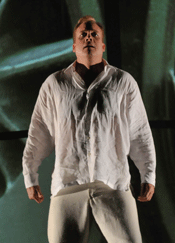 William Burden as Hippolytus
William Burden as Hippolytus
The work contains autobiographical resonances. Henze, in the classic mode of German Romantics, moved in later life to Italy—by chance, close to the spot where these mythical events are said to have occurred. He had finished Act One when he suddenly fell into a coma for several months. He was expected to die, but suddenly recovered. Seemingly revitalized, he wrote Act Two, with its theme of reincarnation.
All this is reflected in Henze’s luminous, precisely constructed score. Those familiar with his most famous operas, written in the 1960s when he was engaged in broader social and intellectual causes, will note that the mode of expression here is more private. One encounters neither the intricate and dramatic interactions among the characters in Elegy for Young Lovers, nor the symphonic sweep and struggle with implacable fate before a Greek chorus of Die Bassariden. The characters in Phaedra barely take notice of one another or the society around them. The dramatic focus lies instead on their interior monologues.
Consistent with its private, existential emphasis, Phaedra is delicately scored for five singers and an orchestra of 23 players. Yet it is miraculously varied, evocative and often sensuous writing of a mature master. The style is influenced, as always with Henze, by the second Viennese school—one key reference being Alban Berg’s Lulu—with clearly audible elements of Schönberg’s serialism, Stravinsky’s neo-classicism, Britten’s sound-world, and Weill.
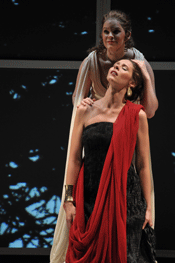 Elizabeth Reiter (standing) as Aphrodite with mezzo-soprano Tamara Mumford (kneeling) as Phaedra
Elizabeth Reiter (standing) as Aphrodite with mezzo-soprano Tamara Mumford (kneeling) as Phaedra
Henze makes this all distinctively his own, creating unforgettable moments. Phaedra and Hippolytus’s early dawn wanderings in the forest are introduced by a sinuous duet for alto saxophone and English horn. The apex of the opera, when Hippolytus questions his identity, is followed by the most magically subtle suggestion of an orchestral storm: a brooding cello, swirling woodwinds, and a light, almost Japanese, rainstorm of solo percussion. The final scene, expressing the moral that we should dance our way through life rather than hunting (or being hunted) in the labyrinth, wittily echoes the finales of classic Baroque or Mozart opera.
Such writing imposes enormous technical and interpretive demands. Complex, largely atonal passages, subtle shifts in dynamics and meter, and a wide range of refined timbres must be performed in a limpid and fluid manner.
In Philadelphia, four outstanding young American singers take the leads. Phaedra is movingly sung by young mezzo-soprano Tamara Mumford. Her uncommonly expressive voice has increased in size since her successful Lucretia in Philadelphia two years ago—almost to the limits of the role—yet retains its plangent edge. Her elegant physical beauty perfectly suits aristocratic women in uncomfortable circumstances, such as Lucretia and Phaedra.
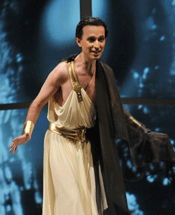 Anthony Roth Costanzo as Artemis
Anthony Roth Costanzo as Artemis
Anthony Roth Costanzo, the leading American countertenor of his generation, assumes the role of Artemis with clarity, precision and occasionally seductive charm. His voice has also grown in recent years, perhaps—as with Mumford—the result of singing at the Met.
William Burden, another returnee from the 2009 Lucretia, sings Hippolytus with passion, musicality, and dramatic impact. To be sure, some might object that the role of Hippolytus calls for less virility and a cooler and more focused tone production—John Mark Ainsley sang the European premiere to perfection—but Burden slims down to a ravishing “mixed voice” when it matters most, as in the Act II scene starting “Bin ich ein Vogel…”
Henze’s meandering, atonal phrases are murderously difficult to sing precisely on pitch. Only Elizabeth Reiter, who sings Aphrodite, is fully up to the task (though Costanzo comes close). Singing spot on pitch, she brings the music suddenly into focus, revealing its Mozartian naturalness and grace. It is hard to believe Reiter is a still a graduate student at Curtis—albeit one already boasting Tanglewood, Carnegie Hall, and European credits. Jeremy Milner is vocally and physically imposing in the cameo role of the Minotaur.
For all the vocal splendor—reinforced by the small confines of the Kimmel Center’s Perelman Theater—the musical preparation is not uniformly idiomatic. Both singers and orchestral players might take fuller advantage of extensive dynamic markings in the score. And only Costanzo consistently communicates of the eclectic pedigree of this music: where, for example, are the Cabaret influences in Phaedra’s Weill-inspired Act II seduction scene? German diction, though uniformly intelligible, remains uneven. Vocal trills go missing. Some questionable orchestral intonation mars Act II, and orchestral detail under Music Director Corrado Rovaris is lost. Yet such issues may resolve themselves out during the 5-performance run of what is an extremely difficult work.
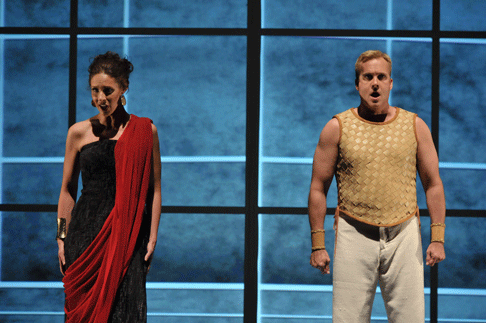 Tamara Mumford as Phaedra with tenor William Burden as Hippolytus
Tamara Mumford as Phaedra with tenor William Burden as Hippolytus
A more serious problem is that the visual treatment falls well short of the high musical standard. The basic concept of the production is promising: abstract, geometrical panels on which projections appear and in front of which a large cage descends in Act Two to entrap Hippolytus. Yet the costumes, make-up and stage direction fail to capture the mysterious essence of this opera. In part this is because much of the production does not engage Henze’s explicit instructions. One would never know that in the finale of Act One, Henze’s score brutally confronts the audience with Phaedra’s death: “The bang of a trap door. Phaedra hangs from a rope.” In the final scene of Act Two, the stage directions read: “In the background, the Minotaur dances,” evoking the archaic strangeness of the libretto, as well as its aspiration to reconceive two millennia of the Western tradition.
Such instructions need not be followed to the letter, but the lowest-common-denominator realism of the Philadelphia staging—characters in realistic costumes, little make-up and no masks, with pictures of birds and trees behind them—seems banal and earthbound in a way fundamentally at odds with the opera’s spirit. Expressionism or abstraction might better convey that Henze’s characters are not, in the end, real people, but archetypes engaged with central issues of Western culture.
Ultimately, however, the Opera Company of Philadelphia has rightly chosen to emphasize first and foremost the music. Phaedra is a miraculous musical achievement that combines the freshness of youth with the wisdom and skill of old age. An opportunity to hear voices of this quality in a work of this significance should not be missed.
Andrew Moravcsik
image=http://www.operatoday.com/fullres_2011_06_01_KM0262.gif image_description=Tamara Mumford as Phaedra [Photo by Kelly & Massa Photography courtesy of Opera Company of Philadelphia] product=yes product_title=Hans Werner Henze: Phaedra product_by=Click here for cast and production information product_id=Above: Tamara Mumford as PhaedraAll photos by Kelly & Massa Photography courtesy of Opera Company of Philadelphia
June 3, 2011
The Metropolitan Opera HD Live on DVD
Instead of adolescents or youngsters and their parents shambling in to see the latest animated feature or some popular action/horror movie, a polite, more “senior” audience appears (often quite early) for a live simulcast in high-definition from the Metropolitan Opera’s home in Lincoln Center. Earlier attempts of this sort of media exploration had never really been much of a success, making the “Met Live in HD” venture something of a risk. In this case, the bet has paid off, and the so-called moviecasts have become a phenomenon, at least in the world of opera. The number of presentations has increased, the number of theaters hosting the shows has multiplied, and later “encore” showings are part of the program now as well. That first live moviecast remains the biggest draw, as most anyone who has attended one of the movie theater showings can attest that somehow at least some of the energy and atmosphere of the actual live performance manages to get conveyed, even in some suburban multiplex hundreds and hundreds of miles from NYC.
The fact that these moviecasts end up on PBS within a few months (although erratically scheduled) and then eventually on store shelves in DVD format has done nothing to slow the program’s expansion and success. Viewing five of the Met Live in HD moviecasts in their DVD equivalents offers reasons for that. Although the DVDs have at least some of the intermission features and begin with the backstage introductions by one or another of the Met’s singing stars, a true “live” feeling is absent once the opera proper begins. The viewer is left with somewhat ordinary operatic DVD viewing — with the expected variable successes in singing, production, and musical performance. The optimal way to enjoy these performances would have been to see them at Lincoln Center, but the definite next best would be the live HD moviecast. After that, the magic dissipates.
Start with the Sony DVD of the Met Live in HD series’s Simon Boccanegra, filmed on February 6, 2010. In a brief interview conducted by Renee Fleming, conductor James Levine speaks of his high regard for the opera and suggests it is no surprise to him that tenor Placido Domingo would, at this point in his career, take on the title role, which Verdi wrote for a baritone. For all the talk of the “baritonal” timbre of Domingo’s voice, what is striking about his vocalism as Boccanegra is how bright and high-placed he makes so much of the music for his character sound. Duets with a low voice such as that of James Morris, as Boccanegra’s adversary Fiesco, have a tint of Otello and Iago facing off. What cannot be questioned is Domingo’s identification with the role, where he is able to indulge his passion for enduring emotional, if not physical, pain on stage. He projects dignity at all times, however, which strengthens his portrayal. Up against a wily veteran such as Morris, Domingo raises this performance to a high level. The rest of the cast does not reach that elevation. A fine soprano, Adrianne Pieczonka is miscast as Amelia, her solid, hefty soprano sounding blustery and forced. A favorite tenor of the Met, Marcello Giordani is at his best when he can power through a role, and the male ingénue role of Gabriele Adorno gives him few such opportunities. The production of Giancarlo del Monaco would have been at home at the Metropolitan a quarter century ago. Handsome, detailed, almost monolithic in its high walls and expanse, it would be perfectly appropriate for an opera with a more believable narrative. The greatness of the opera, however, is not in its plot but in its score, which Levine and his orchestra play with taste and expertise. Still, when Morris and Domingo are not on stage, the performance drags.
Not dragging at all is the Madama Butterfly in the late Anthony Minghella’s acclaimed production. Here a viewer can regret the TV director’s propensity for close-ups, as the total stage picture offers the greatest reward. Minghella, lighting designer Peter Mumford and set designer Michael Levine put on a master class of how to create dramatically cogent and visually arresting stage pictures on a stark set, through color and effective use of minimal props. The one controversy of the production centered on the decision to use a puppet for Sorrow, Butterfly’s child (puppet theater being a cultural and theatrical tradition in Japan). Viewers will make up their own minds about this, but for your reviewer, the puppet fits perfectly into the theatrical techniques of the entire show and has an impact often absent from productions which use an older child than the libretto indicates.
A strong cast exhibits high professionalism, if lacking in the aura on inspiration that makes for truly great performances. Patricia Racette’s soprano can begin to wobble under pressure, and your reviewer, like some others, finds something external, or generic, about her acting. But this is one of her best total performances, no doubt. Much the same goes for Marcello Giordani, who gives us a strong portrayal of the classic very-Italian B. F Pinkerton. Dwayne Croft’s Sharpless and Maria Zifchak as Suzuki give fine support. Reliability would seem to be the key word for conductor Patrick Summers, but one only has to endure one less than reliably conducted performance to understand the virtues of a conductor such as Summers. He does well by Puccini’s magnificent score.
Summers has the baton again for the October 11th, 2008 recording of Richard Strauss’s Salome. One might have hoped for some more distinctive musical leadership. When Karita Mattila first took on this role at the Met in Jürgen Flimm’s spooky, modern dress staging, she sang for Valery Gergiev, and the radio broadcast gave evidence of the visceral excitement of those performances. Years later, in 2008, Mattila is working with slightly less secure vocal resources, but the brazen aggression of her princess still makes for a startling show. She also had Bryn Terfel as her Jochannan in that earlier run. Here Juha Uusitalo takes the role, and he cannot match the stage charisma or vocal authority of Terfel. Some viewers may be grateful that neither Kim Begley as Herod nor Ildikó Komlósi as Herodias overact in their roles, as singers in many another production have, but sometimes it is that extra element of risk that adds to the total frenzy a great Salome can produce. This production, therefore, ranks as respectable, rather than great. Too bad the cameras were not there in 2002, for that first run.
A strongly conducted performance appears in the Carmen, with Yannick Nézet-Séguin bringing out distinct colors and etching a sharp rhythmic profile. He has two superior leads — the well-established exuberance and commitment of tenor Roberto Alagna as Don José, and the warm, sensuous tones of mezzo Elīna Garanča. Often one reads references to the “clichés” of a Carmen portrayal, but any performance that doesn’t acknowledge what the libretto establishes — the sensuality and wildness that make Carmen stand out — won’t pass muster. Garanča herself, even in a dark wig, doesn’t have to stretch to evoke this reputation, and the intelligence with which she sings the role cuts against any cry of “cliché.” In the key supporting role, Barbara Frittoli manages to be beautiful and yet clearly not much competition for the Carmen, especially as the soprano needs time to warm up and even then, a persistent beat appears in higher lines.
Richard Eyre’s staging was new to the Metropolitan when filmed in January 2010, and while far from innovative or evocative, the sets establish the sultry, threatening mood of the piece, and scene changes are easily accomplished. A performance of this quality reminds everyone of why this masterpiece never loses its appeal.
For all the above titles, numerous competitors on DVD might lay claim to being superior in one category or another. For John Adams’s Dr. Atomic, the only DVD competition also features Gerald Finley in the title role — the Peter Sellars staging of the premiere production (originally seen at San Francisco Opera, later filmed at De Nederlandse Opera). For the Metropolitan Opera , Penny Woodcock took over the production responsibility. Her work is more formal and naturalistic than what Sellars opted for, but it has enough stylization to support the atmospheric effects of Adams’s score. Seeing this opera again (your reviewer caught the premiere run in San Francisco, twice), the strengths seem just as distinctive as ever, but the weaknesses only grow more persistent. The libretto seems to be modeled on Nixon in China, with Oppenheimer a more sympathetic figure than Nixon, but just as troubled and conflicted, and with Kitty Oppenheimer (Sasha Cooke) being the equivalent of Nixon’s sadly sympathetic Pat Nixon. There is even a comic villain character to match Nixon’s Kissinger in General Leslie Groves (an excellent Eric Owens here), with tints of that same color in Richard Paul Fink’s Edward Teller. But Sellars’s libretto remains a mish-mash of various prose and verse texts, so that unity Alice Goodman brought to the Nixon libretto fails to appear.
Whatever one’s opinion about Dr. Atomic, the DVD has to be seen to catch Finley’s great performance of the title role, caught at its zenith at the end of act one, in the solo of Donne’s “Batter My Heart.” New York Philharmonic conductor Alan Gilbert crossed the plaza to conduct, and he finds all the idiosyncratic power of Adams’s score. Your reviewer has his doubts about the long-term prospects for the work, but Finley’s performance will always be worth viewing.
The 2010-2011 Metropolitan Opera season of Met in HD moviecasts will undoubtedly all be out on DVD soon enough. However, the real treat lies ahead, when the 2011-2012 season opens in movie theaters — that’s where the glory of this venture lies.
Chris Mullins
image=http://www.operatoday.com/Simon_Boccanegra_Met_HD.gif
image_description=Giuseppe Verdi: Simon Boccanegra
product=yes
product_title=Giuseppe Verdi: Simon Boccanegra
product_by=Simon Boccanegra: Plácido Domingo; Amelia: Adrianne Pieczonka; Fiesco: James Morris; Gabriele: Marcello Giordani. The Metropolitan Opera Orchestra. Conductor: James Levine
product_id=Sony 88697 80664 9 [DVD]
price=$26.99
product_url=http://www.arkivmusic.com/classical/Drilldown?name_id1=12554&name_role1=1&comp_id=55972&genre=33&bcorder=195&label_id=3
Jordi Savall, le maître de musique (video)
[LeFigaro, 3 June 2011]
Après avoir remis la musique ancienne au goût du jour, le chef catalan court le monde pour jouer avec sa viole des oeuvres que l'on croyait tombées dans l'oubli. Il a reçu Le Figaro Magazine dans sa maison barcelonaise.
June 1, 2011
Brahms Liebesliederwalzer, Wigmore Hall, London
They aren’t performed live as often as they should be because they need four singers, two pianists and plenty of flair.
At this recital in London’s Wigmore Hall, the singers were Bernarda Fink, Sylvia Schwartz, Michael Schade and Robert Holl. The pianists were Malcolm Martineau and Justus Zeyen.
Appropriately, the evening began with Schumann’s Spanische Liebeslieder op 138 (1849) for they use the same forces as Brahms was to use in his two Liebeslieder Walzer op 52 and 65. Although Schumann’s song are set to Emanuel Giebell’s translations of Spanish and Portuguese texts, they’re not overtly Iberian. These charming songs would have been performed quite happily by talented amateur ensembles. This is sociable music, ideal for discreet flirations, perhaps. Weh, wie zornig ist das Mädchen, the men sing in mock alarm, in a song about an angry girl rushing off in a huff to the mountains. Then Fink sings Hoch, hoch sind die Berge about a girl upset because her lover’s headed for the hills. Joyful repartee, perfectly in order.
Brahms would have known the Schumann songs well, but, as Richard Stokes writes in his programme notes, they are not a “prototype” for the songs Brahms was to write twenty and twenty five years later. Brahms takes the concept of part song to an altogether more sophisticated level. Solo voices alternate with full ensemble, or divide into pairs. Voices sing in harmony, then suddenly revert to polyphony. Intervals and rhythms change. Sometimes the singers sing rounds, sometimes they weave intricate patterns around each other. In really good performances, the singing seems to almost levitate with energy. Significantly, Brahms called these songs Walzer, not Gesänge. They’re waltzes for the voice.
Moods change from the gruff, mock bucolic humour of O die Frauen to the elegant, arched lines of Wie des Abends where the female voices throw the words. “Einem, einem” and “Sonder, Ende, Wonne, sprühn” as if the vowels were garlands. Notice how Brahms pairs songs as partners to one another, and creates long cotillions, where songs move in formation, without a break between them.
Brahms doesn’t merely paint text, he works meaning into form itself. In Die grüne Hopfenranke, the four voices trill and entwine like the tendrils of the vine they’re singing about.
In this repertoire, Bernarda Fink was superlative. Her voice dances brightly, like the belle of the ball. When she needs depth, her voice darkens expressively. In Wahre, wahre, deinen Sohn, her voice becomes the witch/seductress who’ll kill if she can’t get her man. It’s an important song, for its adds menace to what on the surface seems a light hearted, lilting series of songs.
Robert Holl, too, was superb. Although he’s no longer in the first flush of youth, his technique is so good that he can bring agility to his voice which is rich and veers towards the darker range of his fach. He uses it well for dramatic effect, but here he moderated himself at times to blend in unison. That’s a sign of his artistic integrity. A lesser man might want to shine at the expense of the group. Holl knows that it’s ensemble that counts in these songs, not showmanship per se. He was a last minute substitute for Thomas Quasthoff, who was unwell, but Holl’s so experienced and so impressive, that it was no loss.
Some of the finest songs in both Brahms sets are written to showcase the tenor, and Michael Schade delivered well. Since the programme was devised around Quasthoff (the main pianist, Justus Zeyen, is Quasthoff’s regular partner), a Schreier or Prégardien would distract from the baritone part. Schade is good, though, providing a nice balance with Holl’s almost basso resonance.
The soprano was Sylvia Schwartz, a new name to me. She’s been in ensemble at the Deutsche Staatsoper, Berlin where her roles have included Zerlina. She doesn’t quite have the experience as the others and at times sounded pinched and exposed. It was heartening, though, to hear how Fink shielded Schwartz, giving her room so she could build confidence. Another sign of an artist who puts music before ego. Indeed, this is why part-songs like these are so enjoyable. Just as in a string quartet, the whole is greater than the sum of its parts.
Anne Ozorio
Programme:
Robert Schumann: Spanische Liebeslieder op 138
Johannes Brahms: Liebeslieder Walzer op 52, An die Heimat, Der Abend, O schöne Nacht, Abendlied Neue Liebeslieder Walzer op 65,
image=http://www.operatoday.com/Brahms.gif
image_description=Johannes Brahms (1833-1897)
product=yes
product_title=Schumann and Brahms, Wigmore Hall
product_by=Sylvia Schwartz, Bernarda Fink, Michael Schade, Robert Holl, Justus Zeyen, Malcolm Martineau, Wigmore Hall, London, 26th May 2011
product_id=Above: Johannes Brahms (1833-1897)
